THE Picture Perfect
Basher Watts living the ownership dream

Ben Sangster
Minnie Hauk’s breeder flying high ‘This doesn’t work’


Basher Watts living the ownership dream

Ben Sangster
Minnie Hauk’s breeder flying high ‘This doesn’t work’

Juddmonte would like to thank all those breeders from around the world who have supported our stallions in the 2025 breeding season.
Editor: Edward Rosenthal
Bloodstock Editor: Nancy Sexton Design/production: Thoroughbred Group
Editorial: 12 Forbury Road, Reading, Berkshire RG1 1SB editor@ownerbreeder.co.uk www.theownerbreeder.com
X: @TheOwnerBreeder Instagram: theownerbreeder
Advertising: Giles Anderson
UK: 01380 816777 IRE: 041 971 2000 USA: 1 888 218 4430 advertise@anderson-co.com
Subscriptions: Keely Brewer subscriptions@ownerbreeder.co.uk 01183 385 686
The Owner Breeder can be purchased by non-members at the following rates:
1 Year UK £60 Europe £90 RoW £120
The Owner Breeder is owned by the Racehorse Owners Association
Editorial views expressed in this magazine are not necessarily those of the ROA or TBA
Our monthly average readership is 20,000
Racehorse Owners Association Ltd 12 Forbury Road, Reading, Berkshire RG1 1SB Tel: 01183 385680 info@roa.co.uk • www.roa.co.uk
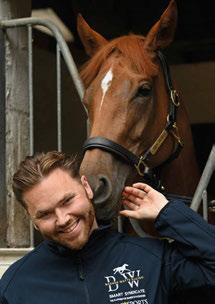
As this issue went to press, news came through that two training legends, Barry Hills and D. Wayne Lukas, had passed away. In June we also lost Peter Easterby and Kevin Prendergast, both giants of their profession.
Hills, who was 88, enjoyed an outstanding career, one that famously began after he backed Frankincense to win the 1968 Lincoln Handicap while head lad to John Oxley in Newmarket. He dived in at 66-1 and punted him right down until he was one of the favourites for the mile contest.
The proceeds of that victory – £60,000 at the time, which equates to over £900,000 today – enabled Hills to set up on his own as a trainer at South Bank stables in Lambourn.
While he didn’t manage to win the Derby –the great Rheingold and Hawaiian Sound both suffered narrow defeats at Epsom – he captured the 2,000 Guineas and 1,000 Guineas twice and the St Leger.
Rheingold was an outstanding middledistance performer, recording a decisive success in the 1973 Prix de l’Arc de Triomphe under Lester Piggott, the man who beat Rheingold aboard Roberto in the Derby the previous year.
Despite all the top-level triumphs, perhaps the horse most strongly associated with Hills is Further Flight, who never won above Group 3 level. The popular grey gelding raced for a decade, nearly always partnered by the trainer’s son Michael, winning 24 of his 70 races before bowing out at the grand old age of 12.
Growing up, Further Flight was like an old friend, reappearing season after season and giving his best every time. I was still in primary school when he started racing – by the time he had retired I was at university. They don’t make ‘em like that anymore!
I was lucky enough to spend time on the racecourse with Hills when he trained Champagnelifestyle – an honourable ninth to Snow Fairy in the 2010 Oaks – for a group of
Edward Rosenthal Editor

ROA colleagues. It was a genuine privilege to be in the company of someone so admired and respected by both his peers and the racing public.
Lukas, who was 89, took the sport to new heights and was quite simply an icon of US horseracing.
He won 20 races at the Breeders’ Cup, a record he shares with Aidan O’Brien, and captured 15 Classics in the States, including the Kentucky Derby on four occasions with Winning Colors – one of only three fillies to have taken the ‘Run for the Roses’ – Thunder Gulch, Grindstone and Charismatic.
Hall of Fame trainer Lukas, who sent out his
“Further Flight was like an old friend, reappearing season after season”
final winner on June 12 at Churchill Downs, started out in the quarter horse world before progressing to thoroughbreds.
He was the leading trainer in America by earnings on no less than 14 occasions and won the Eclipse Award for outstanding trainer four times between 1985 and 1994.
Full obituaries for both Hills and Lukas will appear in the August issue.
This month’s Big Interview features Basher Watts, the man who heads the syndicate that owns Shes Perfect, demoted after passing the post first in the French 1,000 Guineas.
Having turned down £2.2 million for the filly, Watts explains why rejecting such an offer was an easy decision, how he fell in love with racing, and why he’s been able to bring so many new faces into the sport (pages 32-37).
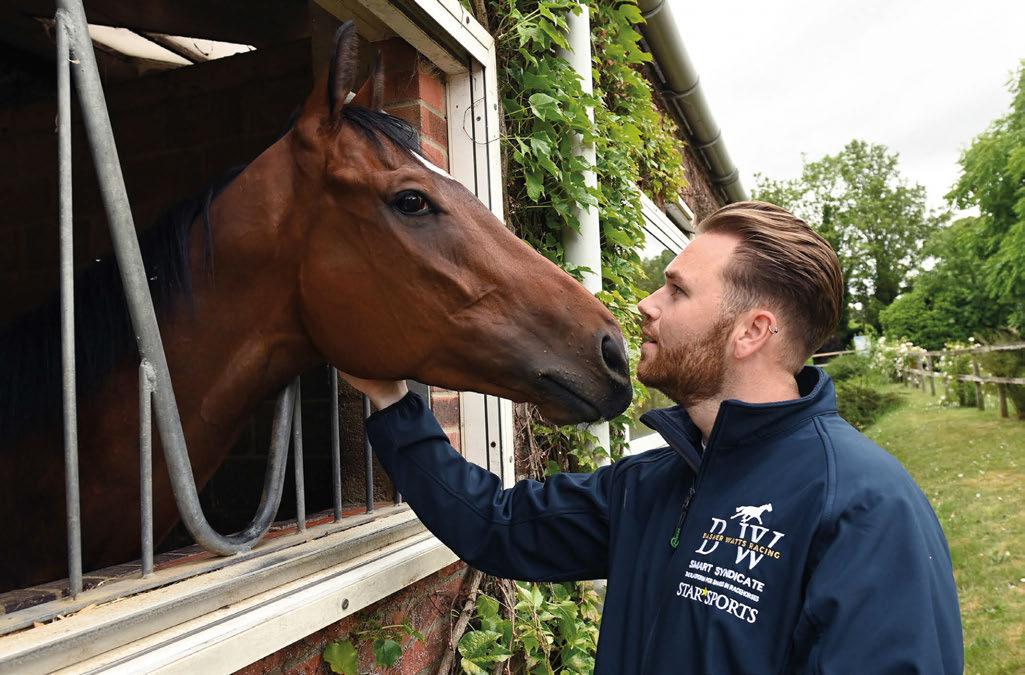
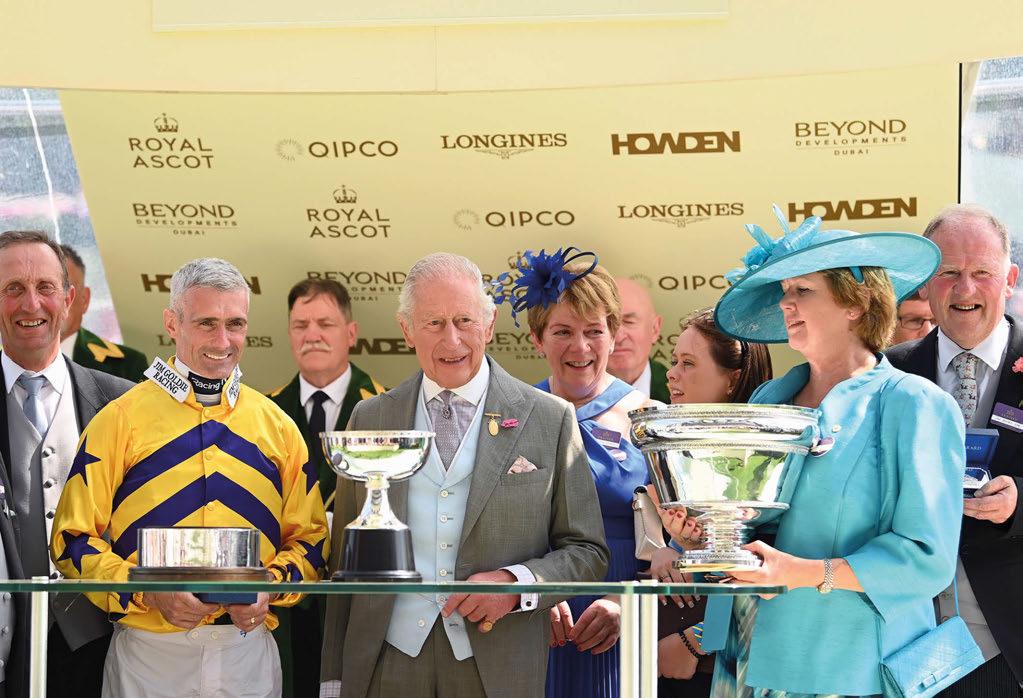

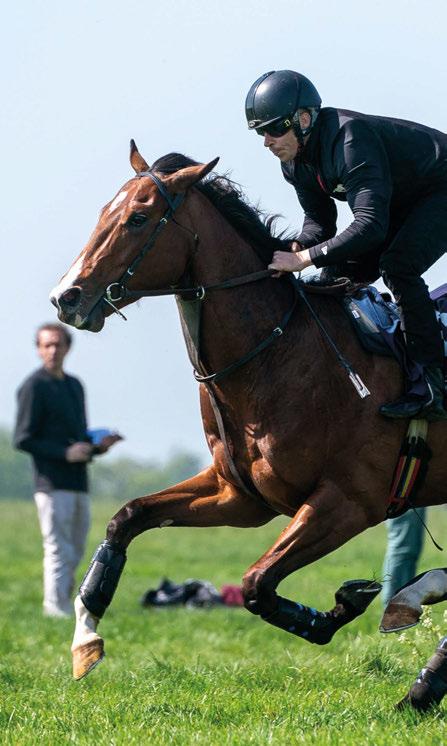

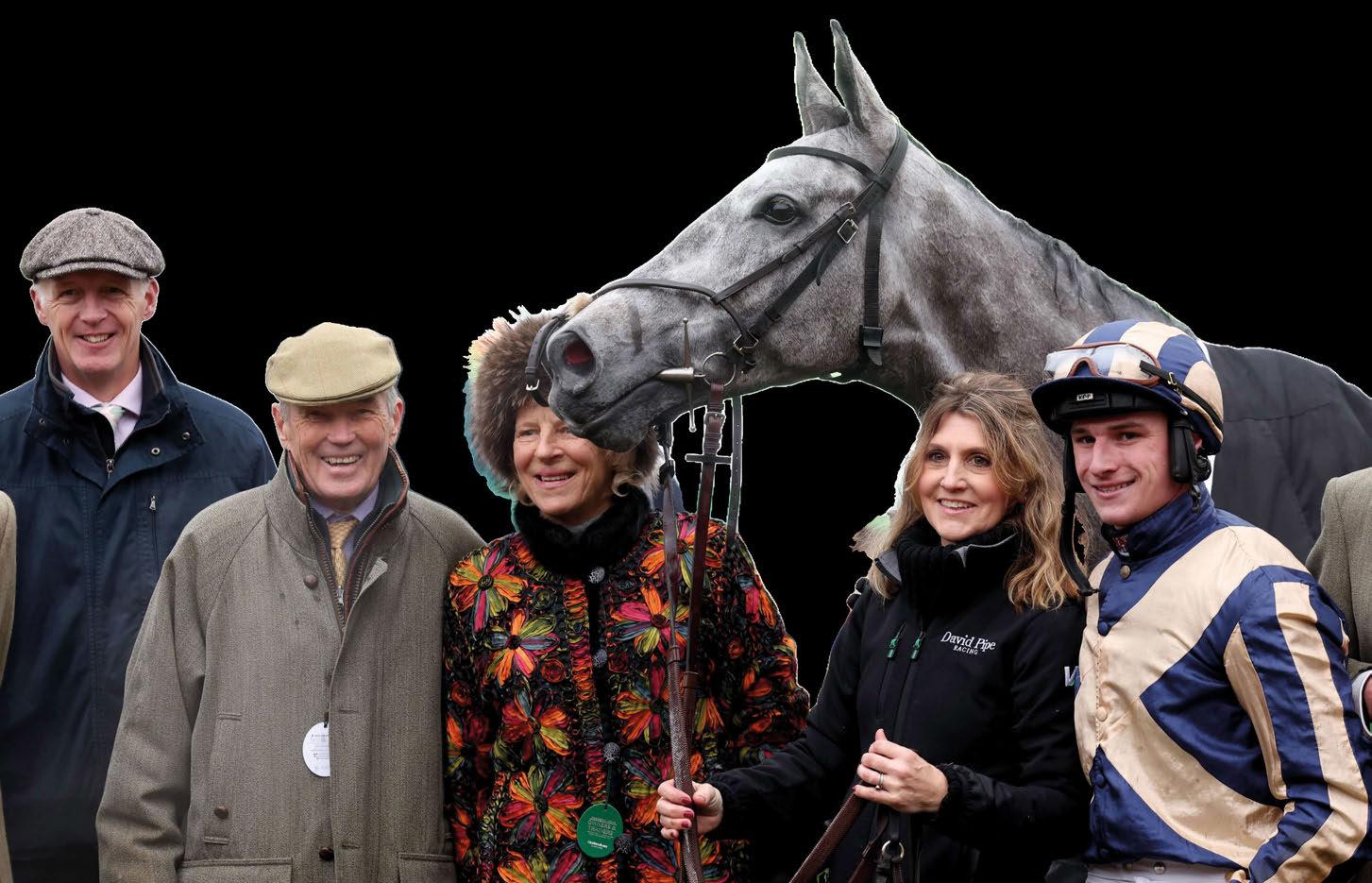

Royal Ascot once again highlighted what a fantastic international sporting event it truly is, with attendance up by almost 5%, betting revenues hugely encouraging and the quality of action on the track world-beating.
The winners over the five days were spread across a number of stables whose ammunition does not rival the big powerhouses, and many were by less well-known stallions. The victory of Havana Gold’s son Havana Hurricane in the Windsor Castle was a case in point, being one of a few produced from the late stallion’s last crop – he cost less than £10,000 and stormed home to win the Listed contest.
The whole experience at Ascot has been well thought out and was delivered with great professionalism and skill. There appears to be real value in some of the enclosures further down the course, with entry costing as little as £25. There is also a really encouraging demographic, with Saturday full of younger racegoers, some of whom stayed to party until very late after racing had finished. Add to that the action in the car parks after racing and you have a superb event, one that showcases the best of our industry.
The start of Ascot week saw the launch of the report produced by the All-Party Parliamentary Racing Group (APPRG), highlighting many of the concerns facing the industry, including the ongoing consultation on the harmonisation of tax rates levied on bookmakers on their sports bets, including those placed on racing. The financial hit for racing could total over £45 million per annum if the current rate was moved from 15% to 21% – this is an immediate threat, and we need strong leadership from the BHA to help coordinate our efforts to lobby against this potentially catastrophic tax raid.
Another focus of the report is the dangers of increased use of the black market as punters are put off by intrusive affordability checks, as well as the use of anti-moneylaundering checks that can be used to ask for personal and private information. The black-market operators are, by definition, not regulated, do not pay the levy, and are outside of any legal checks and balances that protect punters. This issue has not been tackled by the Gambling Commission, who appear blind to the consequences of their actions, driving people they should be protecting away from the legal betting operators.
The original gambling white paper – published several years ago – explicitly referenced that racing would suffer a loss in revenues because of affordability checks and stated that the drop off would and could be mitigated by a review of the levy. We obviously have been suffering the pain without
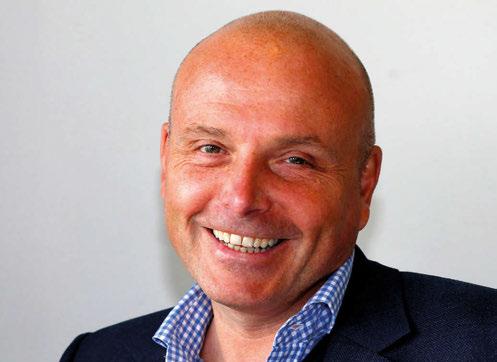
the mitigation, and this must be resolved at some stage. More than 12 months on from the collapse of the levy review, there seems little willingness politically to help sort the mess out. Racing needs to support the APPRG and have a reset around these issues, starting with the consultation on the harmonisation proposal. Importantly, the industry also needs to continue to look to help itself with the development of the next stage of the industry strategy. A lot of good work has been carried out on Projects Pace and Beacon. A set of achievable deliverables now need to be agreed and put into action.
Ascot has shown what can be achieved both through
“Ascot has shown what can be achieved through clever marketing and tapping into other jurisdictions’ pools”
clever marketing to engage with a domestic crowd, but also internationally by tapping into other jurisdictions’ betting pools. We may have to lower our sights slightly at this stage, but a strategy to attract new investment is top priority.
We also need to work together with the racecourses to drive the on-course experience and widen the domestic investor base. We have recently completed the first owners’ survey for several years; the results will be published in due course. The engagement with the survey was very encouraging with interesting feedback across several issues. You will not be surprised to hear that both prize-money and on-course experiences feature! Whilst we face tough times from tax and regulation, there are encouraging signs, especially after such a successful week in Berkshire.

In several previous columns I have referred to the importance of horseracing remaining relevant to its audience, with the most important sector being the betting industry and betting public –this is where the money comes from that keeps the industry going. You might not like it, but this truth applies to all racing jurisdictions. In short, the betting person is the piper that calls the tune!
Looking in the Collins Dictionary that sits by my desk, ‘relevance’ means ‘the quality or state of being closely connected or appropriate’ – so how does racing then fit to our audience? Betting requires racing to deliver a compelling, attractive, competitive product that engages interest and offers opportunity. Twenty-five years ago, horseracing had almost the entire field to itself, with no real competition and a betting industry that relied upon the sport as its key product line.
Today is a vastly different landscape with almost every sport offering a betting option, where the customer and the betting industry has choice around where the betting pound is directed. In those 25 years, football has come from almost nowhere to lead the market with 45% of total UK betting turnover. Horseracing lies in second place on a fast-diminishing 35% with golf, tennis and boxing sharing 25% of the rest. Losing 60% of market share in that period is catastrophic.
Football continues to grow its market share, as does golf, tennis and boxing, yet racing continues to lose appeal and turnover. One reason given is the curse of affordability checks, but don’t other sports have those same restrictions and shouldn’t racing be looking elsewhere for the reason of its demise?
Complacency might be at the head of that list; racing hasn’t offered anything significantly different to its customer for years, whilst other sports have innovated in product, developed interactive platforms, and most importantly provided clarity of the offer that the consumer understands. In that time, racing has done its best to disaffect and confuse by increasing fixtures, overlapping race meetings, and delivering increasing uncompetitive racing with field sizes falling and value consequently disappearing from the offer.
Racing’s customer is making it clear that an unattractive product is at the heart of the issue. To illustrate this, the levy is generated in the main by small-ticket punters. This is and always has been the most profitable sector for betting, not the high rollers who tend to get things right often, so taking rather than giving.
Darts can deliver an audience of over three million to watch a world final, and this fanbase is the demographic that represents racing’s small-ticket punter, whereas less than a million people tuned in each day to watch ITV’s recent coverage of Royal Ascot. The racing customer is leaving the building as they have been taken for granted for too long.
Philip Newton Chairman
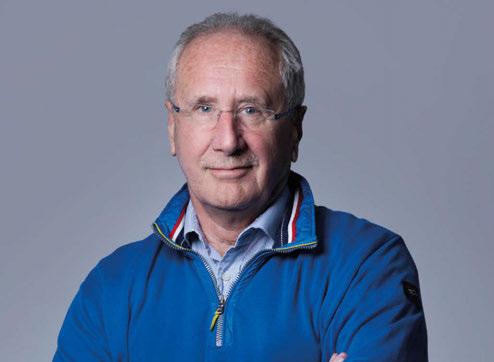
If racing continues to sit on its hands, the fast-diminishing income stream it relies upon for existence will dry up altogether and relevance will not be an issue as racing will have lost its audience.
So, restructure and repositioning is demanded as racing has one last chance to find a transformational funding solution through its 25-30 elite Flat fixtures. This is Project Pace, and it follows the examples of how football reinvented itself to become the sporting behemoth it is today via the Premier League, with an update on the progression of this project due imminently.
“Racing has one last chance to find a funding solution through its 25-30 elite Flat fixtures”
Pace can be the catalyst for change, but at the same time the core racing pyramid of the other 1,450 fixtures needs radical restructuring, providing a position where investment guarantees real return. The falling foal crop demands a significantly reduced fixture list anyway, and to suggest otherwise is fanciful.
Racing requires a strategy for all-weather racing, an aspirational developmental pathway through the pyramid to encourage the best horses and most importantly of all, a 20-year breeding strategy to incentivise and encourage production to meet the demands that a robust 21st-century industry so urgently requires.
A significantly reduced racing programme can then start the journey back to relevance by delivering a compelling and competitive product the customer can both understand and engage with. As its gathers momentum, Pace will provide the financial resource to build the interactive digital support and marketing that will encourage the betting customer to re-engage. We can’t wait any longer as we are already so far behind the competition. Put simply, we must not let the great legacy of the British thoroughbred become irrelevant.
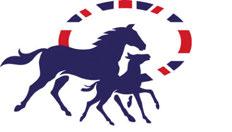

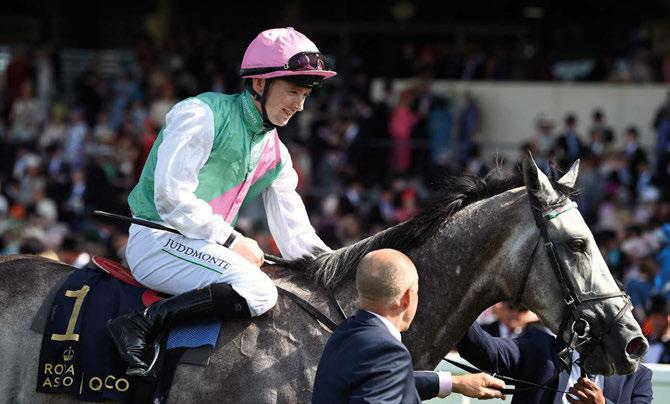
Colin Keane
Six-times champion jockey in Ireland is named as retained rider for the Juddmonte operation. He hits the bullseye at Royal Ascot on Field Of Gold.
Greg Fairley
Former champion apprentice, warned off for 12 years in 2011 having prevented a horse from running on its merits, is returning to race-riding aged 37.
Baroness Minette Batters
House of Lords peer, former President of the National Farmers Union, is announced as new Independent Chair of British racing’s Horse Welfare Board.
Gearoid Harney
Conditional jockey forced to retire aged 23 having sustained a head injury in a fall at Fakenham in January. The Irish-born rider had 21 winners in total.
James Cummings
Godolphin Australia’s head trainer for the past eight years will leave the role on July 31 ahead of his relocation to Hong Kong for the 2026/27 season.

David Egan
26-year-old’s contract as first rider for Kia Joorabchian’s Amo Racing is extended until the end of 2026.
Ryan Moore
Success on Garden Of Eden in the Ribblesdale Stakes – victory number 2,594 – moves the rider into tenth place on the list of winning-most jockeys in Britain.
Epsom attendance
Crowd drops by 4,500 to 22,312 on Derby day and by 3,000 to 15,133 on Oaks day as Jockey Club Racecourses vows to investigate the fall in spectators.
Roger Devlin
Appointed as Chair of the Horserace Betting Levy Board on a four-year term by the Secretary of State for Culture, Media and Sport.
Doug O’Neill
California-based trainer record his 3,000th winner with juvenile Hero Or Zero, bred and owned by Paul and Zillah Reddam, at Santa Anita on June 15.
Charlie Boss
The Jockey Club’s former interim Group Chief Executive is appointed new CEO of Jockey Club Racecourses and will start his new role in September.
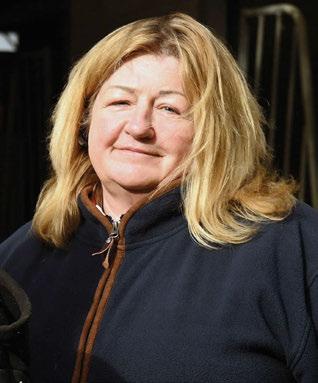
Grace Muir
Founder and CEO of charity HEROS, which retrains and re-homes exracehorses, is awarded an MBE in the King’s birthday honours list.
Ludlow
Racecourse is fined £1,750 by the BHA’s disciplinary panel for misleading participants when a fixture was cancelled after its scheduled start time in January.
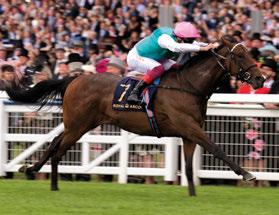
Juddmonte’s homebred Coventry Stakes winner was bought as a stallion by Coolmore, siring Group 2 winners Persian Dreamer and Classic Flower.
Harry’s Girl 2
Listed-placed daughter of Harry Angel trained by Richard Hannon suffers a fatal injury in the Queen Mary Stakes at Royal Ascot.
Snitzel 23
Son of Redoute’s Choice was a topclass sprinter who became multiple champion stallion in Australia at Arrowfield Stud, siring 23 Group 1 winners.
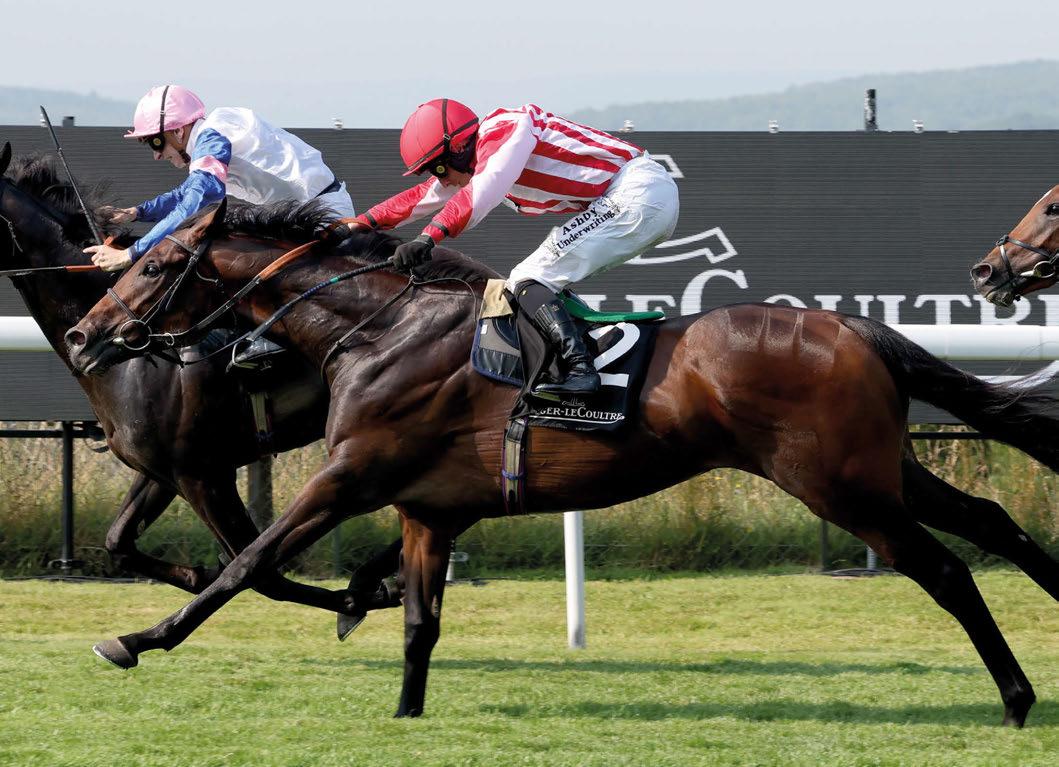
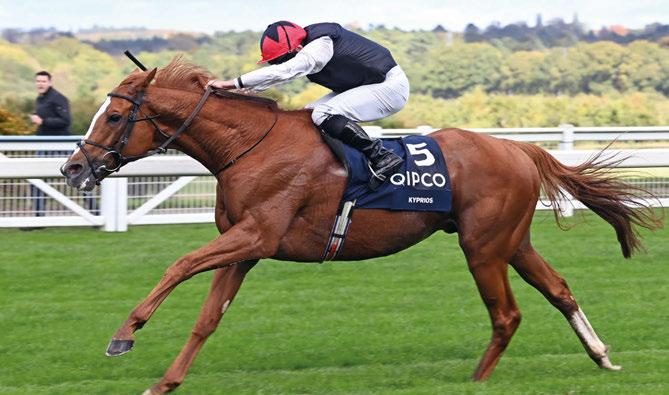
Kyprios
Outstanding stayer, dual winner of the Gold Cup, Goodwood Cup, Prix du Cadran and Irish St Leger, earning £2.7 million, is retired aged seven.
Mindframe
Claiborne Farm in Kentucky will stand the Grade 1-winning son of Constitution upon his retirement from racing.
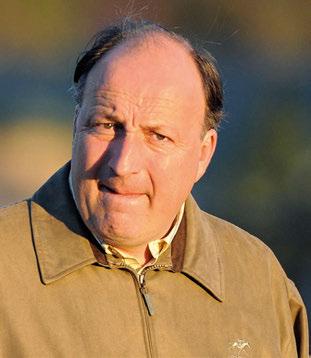
Peter Easterby 95
Yorkshire training legend saddled Night Nurse and Sea Pigeon to win two Champion Hurdles apiece, recording over 1,000 wins under each code.
Michael Wallace 47
Bloodstock agent spent eight years as Chief Operating Officer of China Horse Club and was part of the team that bought Justify as a yearling.
Clement 59
French-born trainer enjoyed over 2,500 winners in the US, handling champions Gio Ponti and Tonalist. His son Miguel is now managing the stable.
Robbie Laing 66
Australian trainer sent out five Group 1 winners, taking the 2006 Australian Cup with Roman Arch and 2013 Victoria Derby with Polanski.
Hugh Mulryan 25
County Galway native worked for Denis Hogan and Sir Mark Prescott and was about to start a new role with Adrian Keatley’s North Yorkshire stable.
Philip Arkwright 89
Mystik Dan
Son of Goldencents, winner of the 2024 Kentucky Derby, will retire to Airdrie Stud in Kentucky upon the conclusion of his racing career.
Storm Boy
Group 2-winning son of Justify, last seen running at Royal Ascot, is retired to join the Coolmore Australia roster with his opening fee set at A$16,500.
Humidity
Two-year-old son of Ulysses is bought privately by Wathnan Racing from Cheveley Park Stud and subsequently wins the Chesham Stakes at Royal Ascot.
Flora Of Bermuda
Wathnan Racing swoops for fouryear-old daughter of Dark Angel who produced a fine effort to finish third in Group 1 company at Royal Ascot.
Ghostwriter
Group 2-winning son of Invincible Spirit sells for £2 million at the Goffs London Sale, bought by Kia Joorabchian’s Amo Racing from Jeff Smith.
Kevin Prendergast 92
Legendary trainer sent out over 2,000 winners in his 60-plus-year career, taking eight Irish Classics and the 1977 2,000 Guineas with Nebbiolo.
Cheltenham’s Clerk of the Course between 1977 and 2000 acted in the same role at Haydock and in retirement owned horses with Kim Bailey.
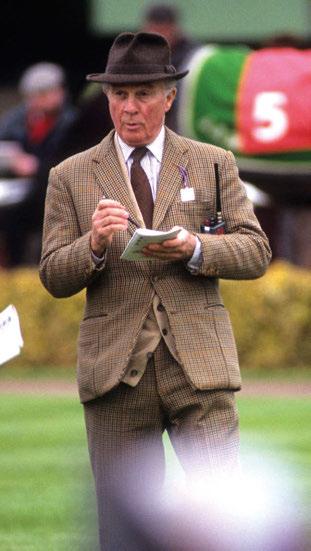

Horseracing lost two of its most distinguished elder statesmen in June following the deaths of training legends Peter Easterby and Kevin Prendergast.
Yorkshireman Easterby, who was 95, was an exceptional dual-purpose trainer and the first man to send out 1,000 winners under both codes.
Kicking off his career in 1950 aged 21 after an apprenticeship with his uncle Walter Easterby and then Frank Hartigan, it may have taken the young man three years to enter the winner’s enclosure, but he soon established himself as an outstanding talent with a keen eye at the sales.
It was Royal Ascot, not the Cheltenham Festival, where Easterby first made his mark, winning the 1963 Windsor Castle Stakes with Goldhill –two years later the son of Le Dieu D’Or returned to the royal meeting to take the King’s Stand Stakes (now the King Charles III Stakes).
Saucy Kit, bought for 720 guineas, took the 1967 Champion Hurdle –Easterby would go on to win the championship contest on four further occasions, with star duo Night Nurse and Sea Pigeon claiming two victories each during a golden period for the sport.
The versatile Sea Pigeon was also renowned for his exploits on the Flat, winning the Chester Cup twice plus the 1979 Ebor Handicap at York in which he carried top weight of ten stone and conceded three stone to runner-up Donegal Prince.
Easterby, champion jumps trainer for three successive seasons between 1978/79 and 1980/81, captured the Cheltenham Gold Cup in 1979 with Alverton and in 1981 courtesy of Little Owl, who beat stablemate Night Nurse under amateur Jim Wilson.
When he retired from the training ranks in 1996, handing over to son Tim at Habton Grange in Malton, Easterby had amassed 2,513 winners over 46 years. One of the few omissions on his CV was a Classic winner, although brother Mick did the family proud when sending out Mrs McArdy to win the 1,000 Guineas in 1977.
Jonjo O’Neill, who partnered both Alverton and Sea Pigeon to big-race glory, told the Racing Post: “He was a genius – I couldn’t speak highly enough
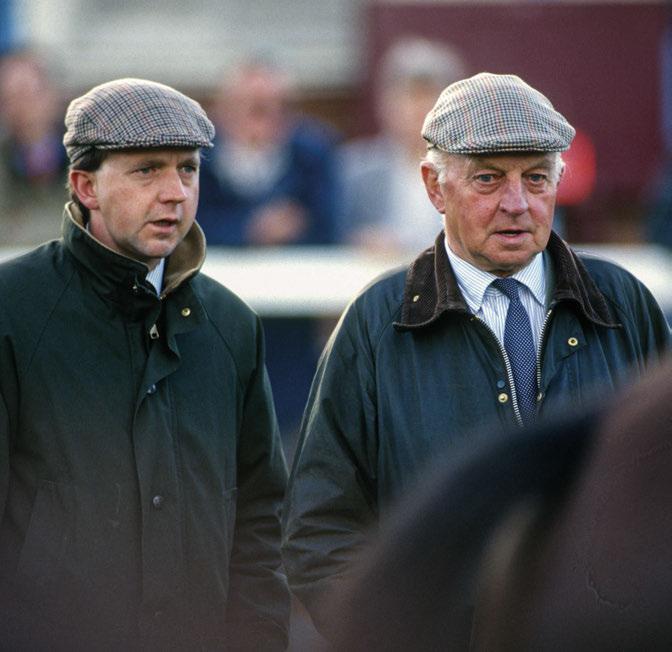
of him. He was a top man and a great person to ride for. He could train a five-furlong sprinter to a staying chaser – it didn’t make any difference. Flat or jumps, he could train them all and was a great all-rounder.
“He was a relaxed and placid man to work for, which would only give you confidence. He was a great man and a good friend who will be sadly missed.”
Prendergast, who has died aged 92, was destined for a career in the sport as the son of Paddy Prendergast, six times champion Flat trainer in Ireland between 1950 and 1965 who was also champion Flat trainer in Britain for three successive years in the 1960s.
Following a career as an amateur rider and having assisted his father for six years, Prendergast took out his own licence in 1963 on the Curragh.
His first Irish Classic success arrived in 1972 when Pidget captured the Irish 1,000 Guineas – the filly went on to win the Pretty Polly Stakes before beating the colts in the Irish St Leger.
Northern Treasure took the 1976 Irish 2,000 Guineas and a year later
Prendergast enjoyed his maiden British Classic triumph when Nebbiolo took the 2,000 Guineas at Newmarket, with future Derby victor The Minstrel beaten into third.
A superb trainer of two-year-olds – he won both the Phoenix Stakes and Moyglare Stud Stakes four times –Prendergast was equally adept with older horses, saddling Oscar Schindler to successive victories in the Irish St Leger, a contest he also took with Conor Pass. Oscar Schindler was also victorious in the Ormonde Stakes and Hardwicke Stakes.
Prendergast enjoyed a successful partnership with Sheikh Hamdan Al Maktoum and sent out the owner’s Awtaad to land the Irish 2,000 Guineas in 2016. He came close to supplying a Derby winner when Madhmoon found only Anthony Van Dyck half a length too good in 2019.
In total Prendergast sent out more
than 2,000 winners – including over jumps – in his 60-plus-year career, winning nine Irish and British Classics along the way. He had downsized his operation in recent years, selling his yard in 2023, but was still training a reduced string at the time of his death.
Shadwell’s racing manager Angus Gold, quoted in the Racing Post, said: “Before I started with Sheikh Hamdan, Kevin was already training for him. Sheikh Hamdan loved him, and they had a great relationship.
“He was a wonderful horseman and his horses always looked immaculate. He was a huge character, full of stories for every occasion – some printable, but most not!
“Kevin knew his horses backwards. He used to walk out with them every day on the gallops and walk back with them. I struggled to keep up with him even when he was 88, 89. He was a good age and lived a great life.
“I went to see him about six weeks ago and he was still asking questions, full of the whole thing and as enthusiastic as ever. We’ll miss him enormously.”

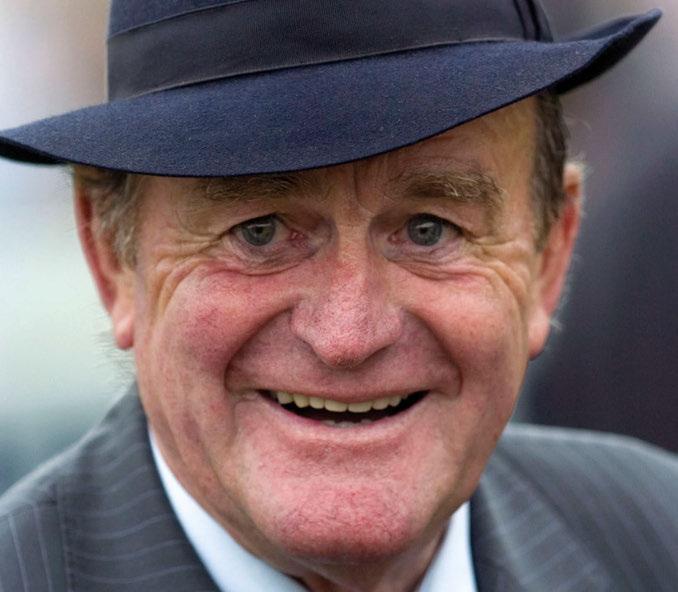
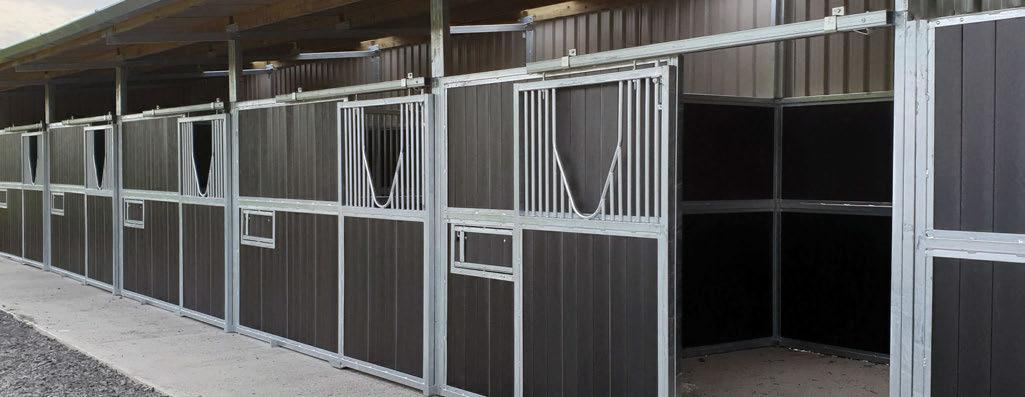

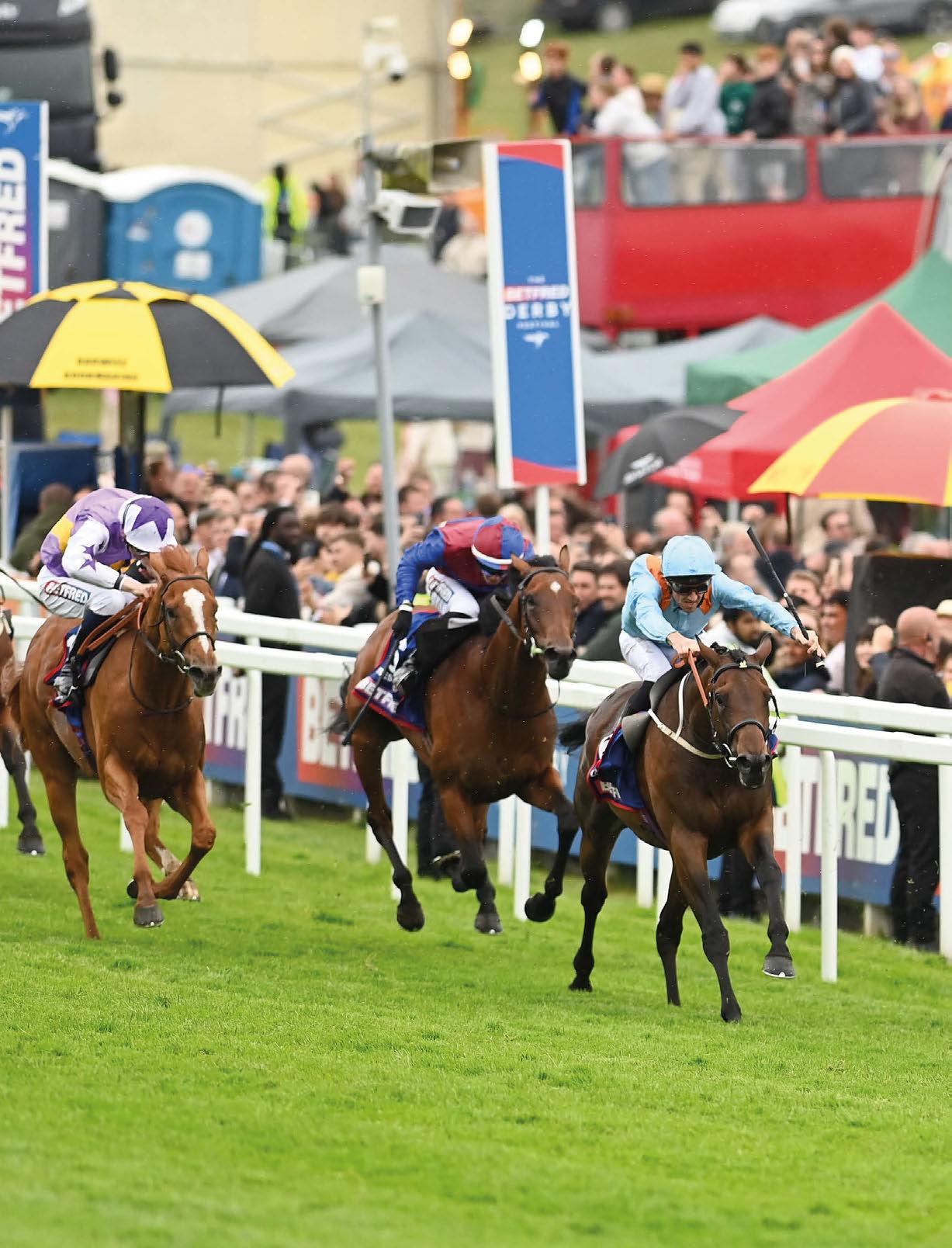
Wayne Lordan enjoyed the ride of his life in the Betfred Derby aboard Lambourn, making virtually every yard of the running on the son of Australia to record a comfortable three-length success over Lazy Griff, running a career-best for his Middleham Park Racing syndicate. Trainer Aidan O’Brien was winning the Epsom Classic for the 11th time while it was a 12th victory for the Coolmore partners. Lambourn emulated his sire by taking the Irish Derby under Ryan Moore on June 29.
Photos Bill Selwyn
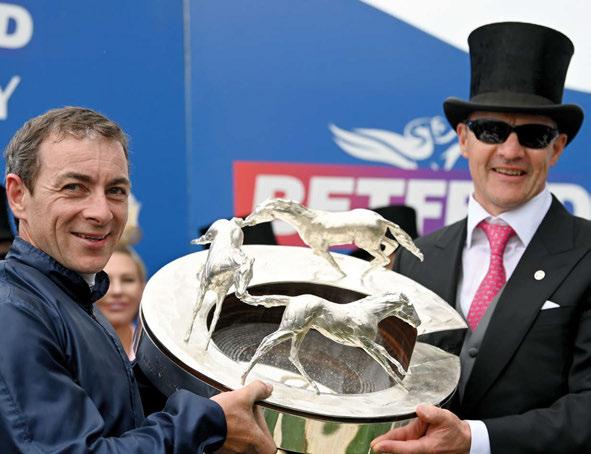



Temperatures of 30C and above made Royal Ascot 2025 one of the warmest on record. Yet the incessant heat didn’t stop more than 286,000 racegoers enjoying the high-class action over the five days. Humidity (noseband) was the aptlynamed victor in the Chesham Stakes on the Saturday under James Doyle, who ended the week with four victories for Wathnan Racing, the Emir of Qatar’s outfit, which enjoyed five winners overall.
Photo Bill Selwyn



Colin Keane kicked off his role as retained rider for Juddmonte with a breathtaking success in the St James’s Palace Stakes on Field Of Gold. The Irish 2,000 Guineas victor, trained by John and Thady Gosden, showcased his exceptional turn of foot when asked to put the race to bed with two furlongs to run, dispatching French and Newmarket Guineas winners Henri Matisse and Ruling Court with ease.
Photos Bill Selwyn
Godolphin enjoyed a superb week in Berkshire with a quartet of winners headed by Trawlerman, who didn’t have old rival Kyprios to worry about in this year’s Gold Cup. William Buick sent the Golden Horn gelding to the front and gradually increased the pace in the 2m4f prize as one by one his rivals came under pressure – the result could be called a fair way from home as Trawlerman galloped on relentlessly to defeat Illinois by seven lengths. For John Gosden this was his fifth success in the historic contest, having saddled Stradivarius to three straight victories (2018, 2019 and 2020) and trained Courage Mon Ami (2023) in partnership with son Thady.
Photos Bill Selwyn
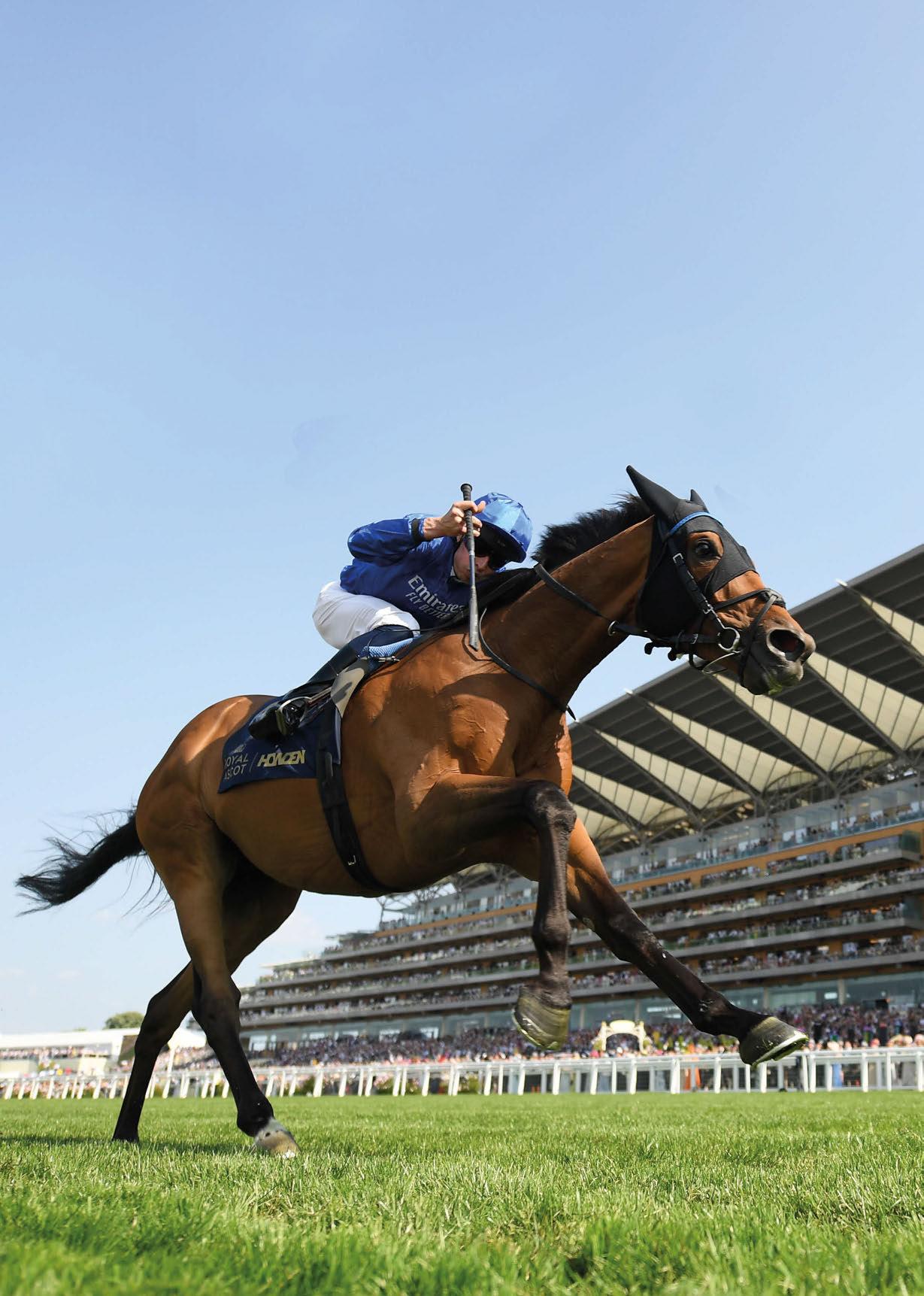
The Charlie Appleby-trained Rebel’s Romance captured the Hardwicke Stakes (right) while Ombudsman (below), also trained by the Gosdens, produced a devastating late run to take the Prince of Wales’s Stakes having been denied a clear passage repeatedly in the straight –a fourth triumph for the boys in blue came courtesy of the Saeed bin Suroor-trained Arabian Story in the Britannia Handicap

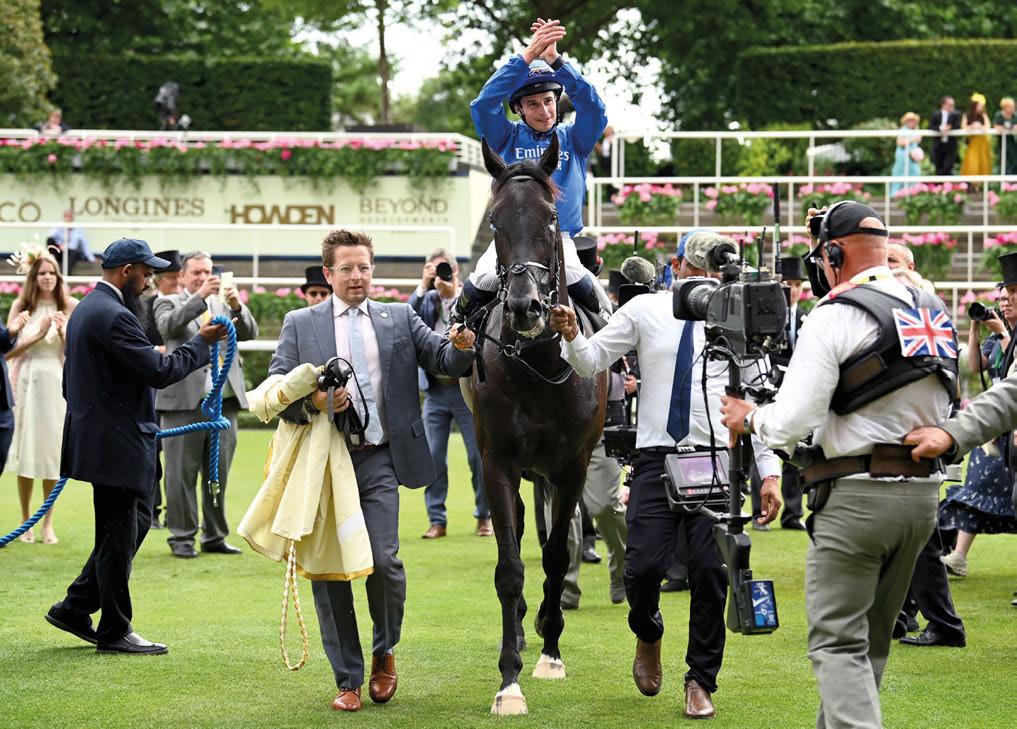
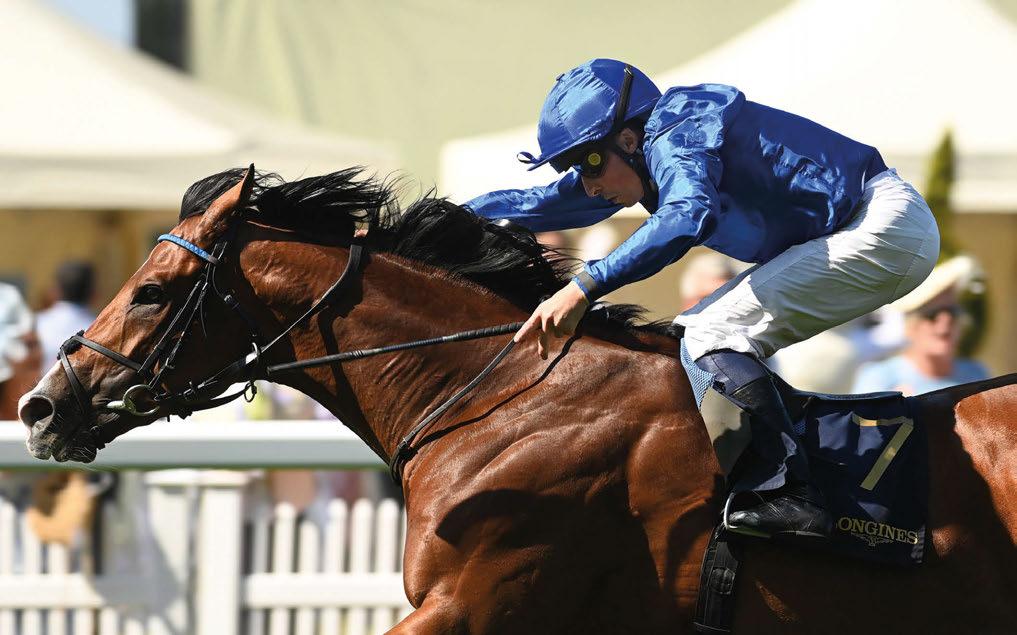

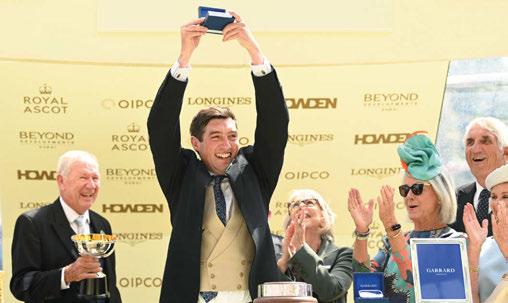
What a week it was for Harry Eustace (above) who became a dual Group 1-winning trainer. O T I Racing’s Docklands (white cap) denied Rosallion by a nose in the Queen Anne Stakes while Time For Sandals, owned by the Bevans, edged out Arizona Blaze in the Commonwealth Cup.
Photos Bill Selwyn
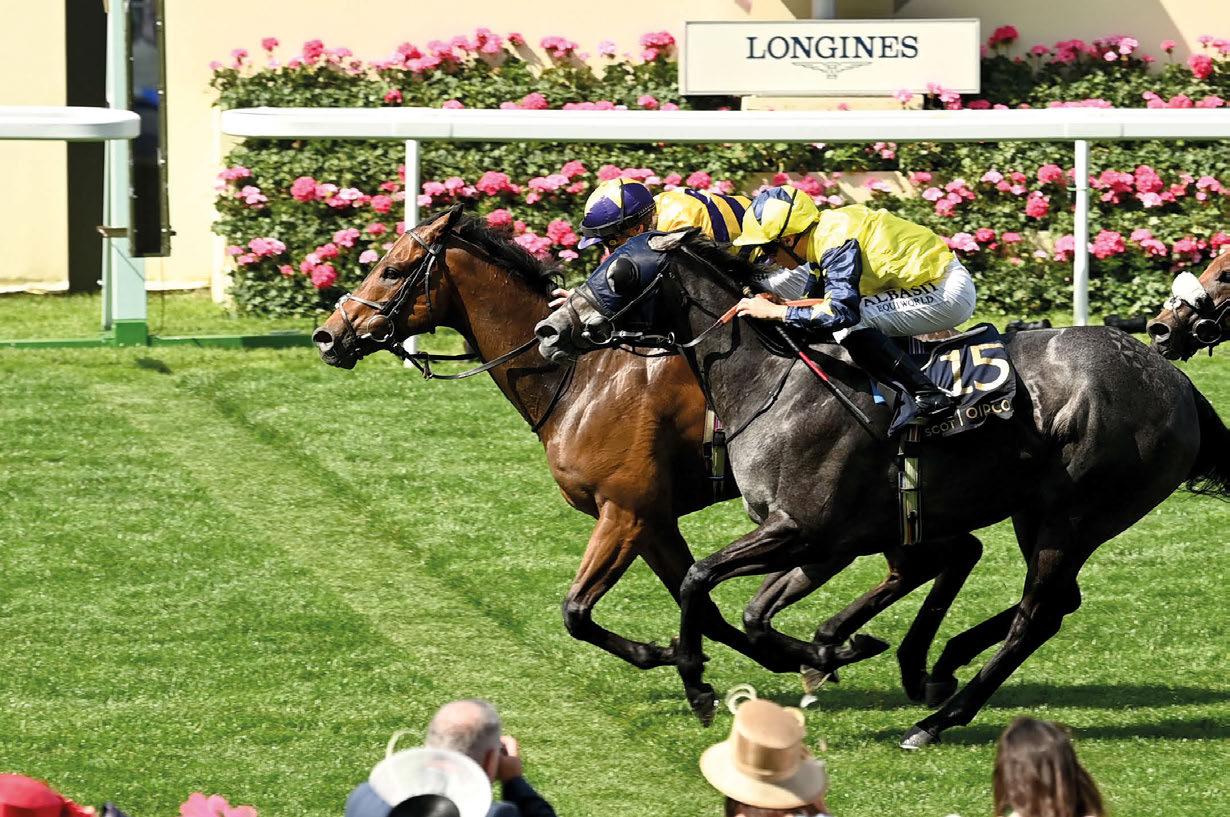
Jim Goldie was another trainer enjoying his first Group 1 and Royal Ascot success thanks to American Affair (far side), who he also part owns with Barraston Racing. The gelding defeated filly Frost At Dawn by a neck in the King Charles III Stakes under Paul Mulrennan (right)
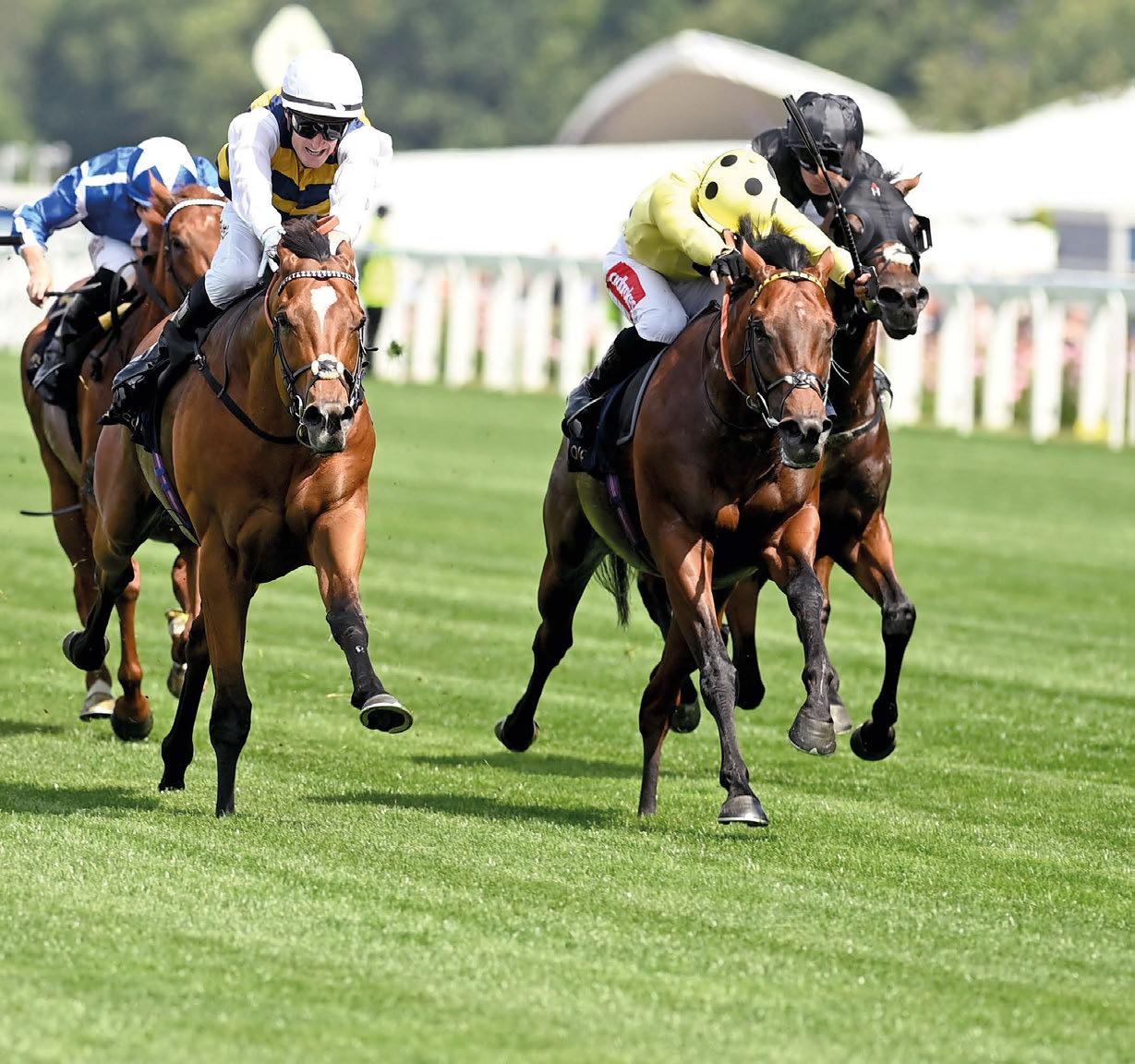
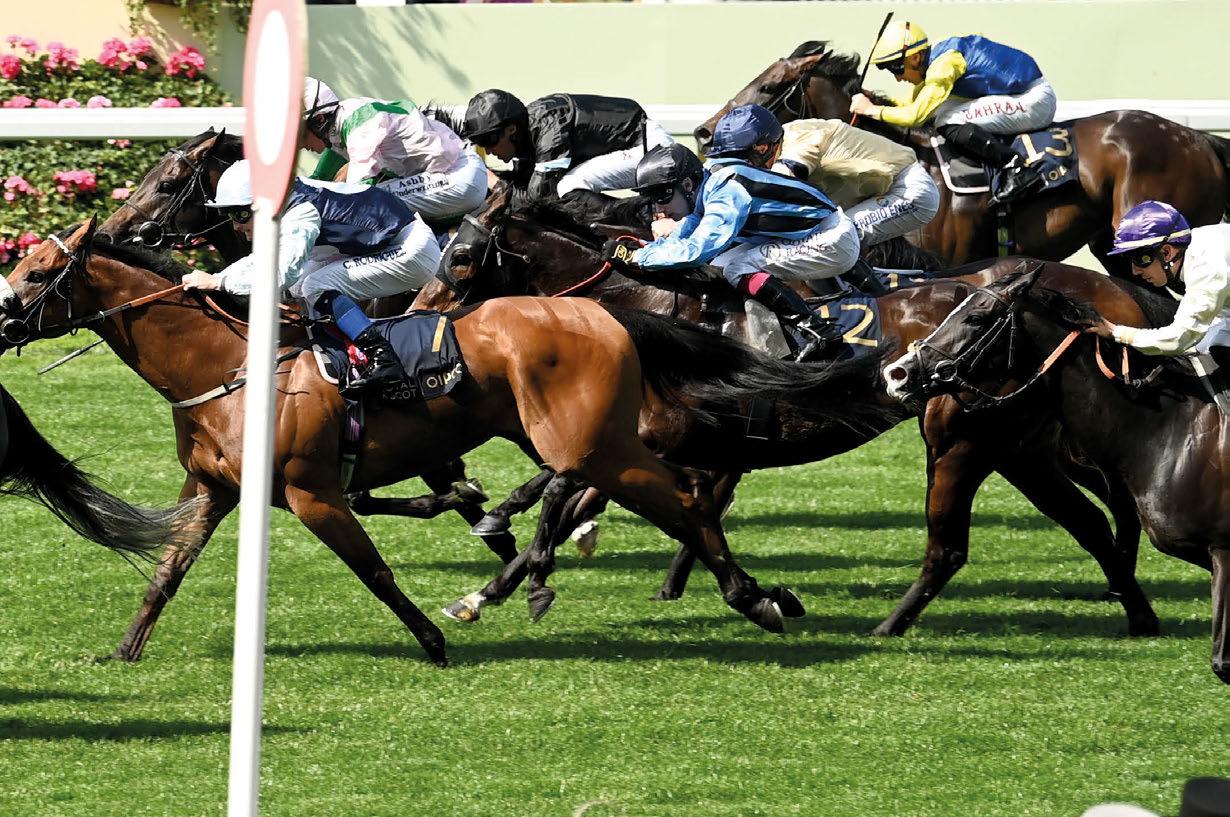

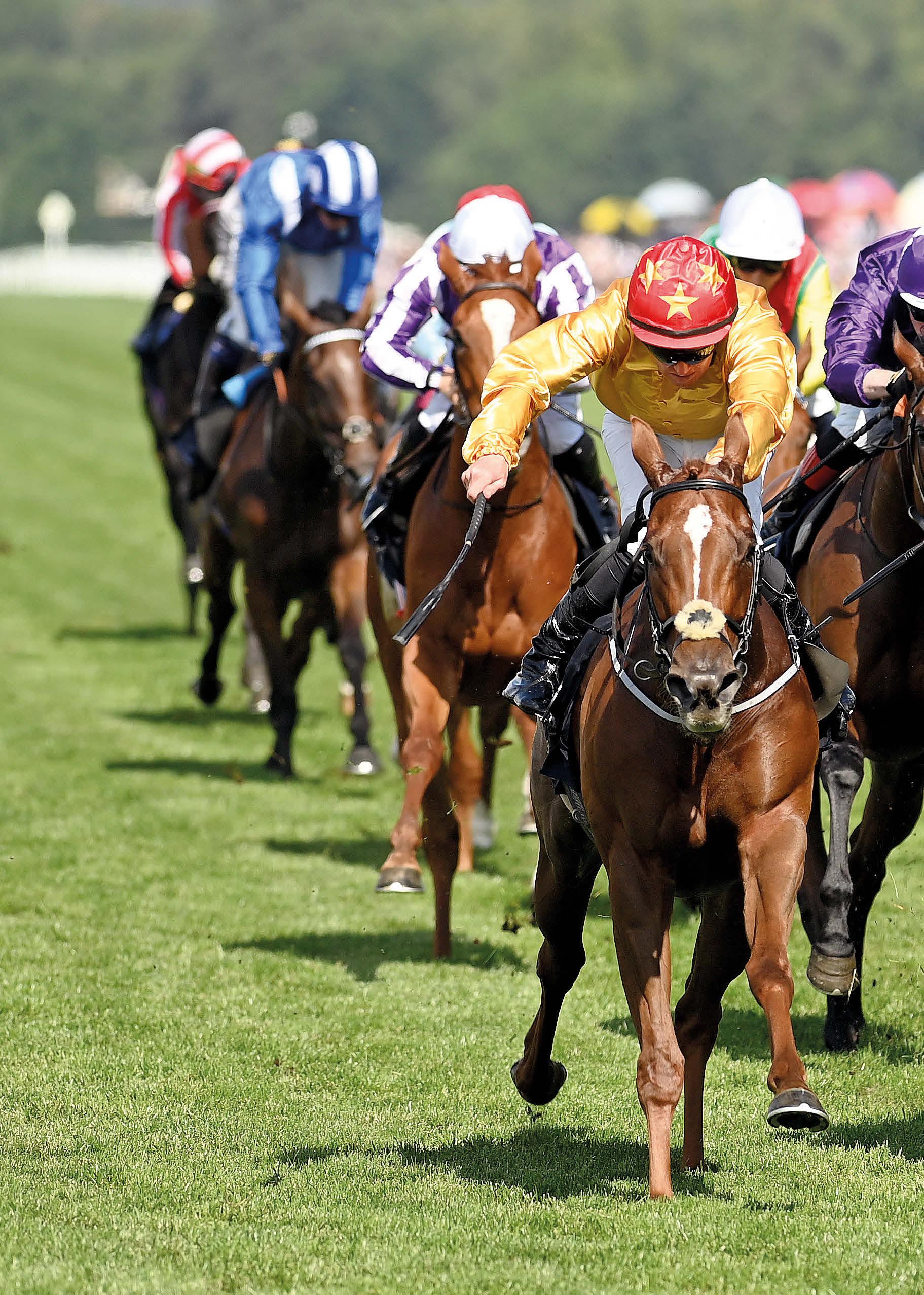
Clockwise from below: the King and Queen were a popular presence throughout the week; James Doyle enjoys Lazzat’s victory in the Queen Elizabeth II Jubilee Stakes; Ed Walker embraces Kieran Shoemark after Noble Champion’s Jersey Stakes triumph; Get It enjoys a well-earned drink from trainer George Baker after his Wokingham success; Coolmore’s Gstaad proves too good in the Coventry Stakes; Merchant is welcomed back by his Highclere Thoroughbred Racing owners after taking the King George V Stakes
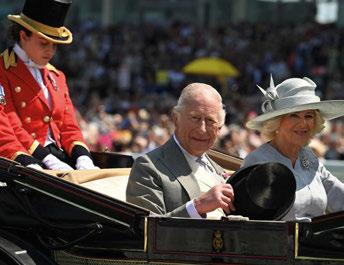

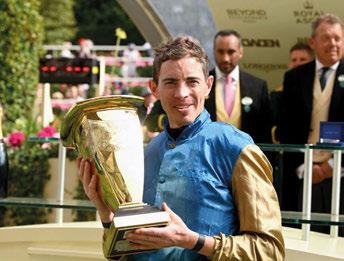
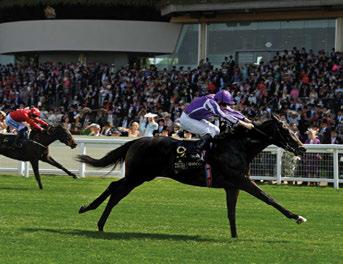

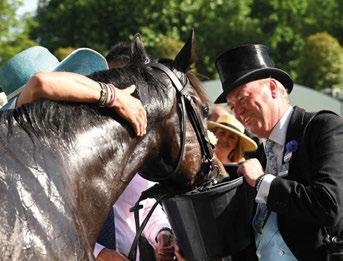
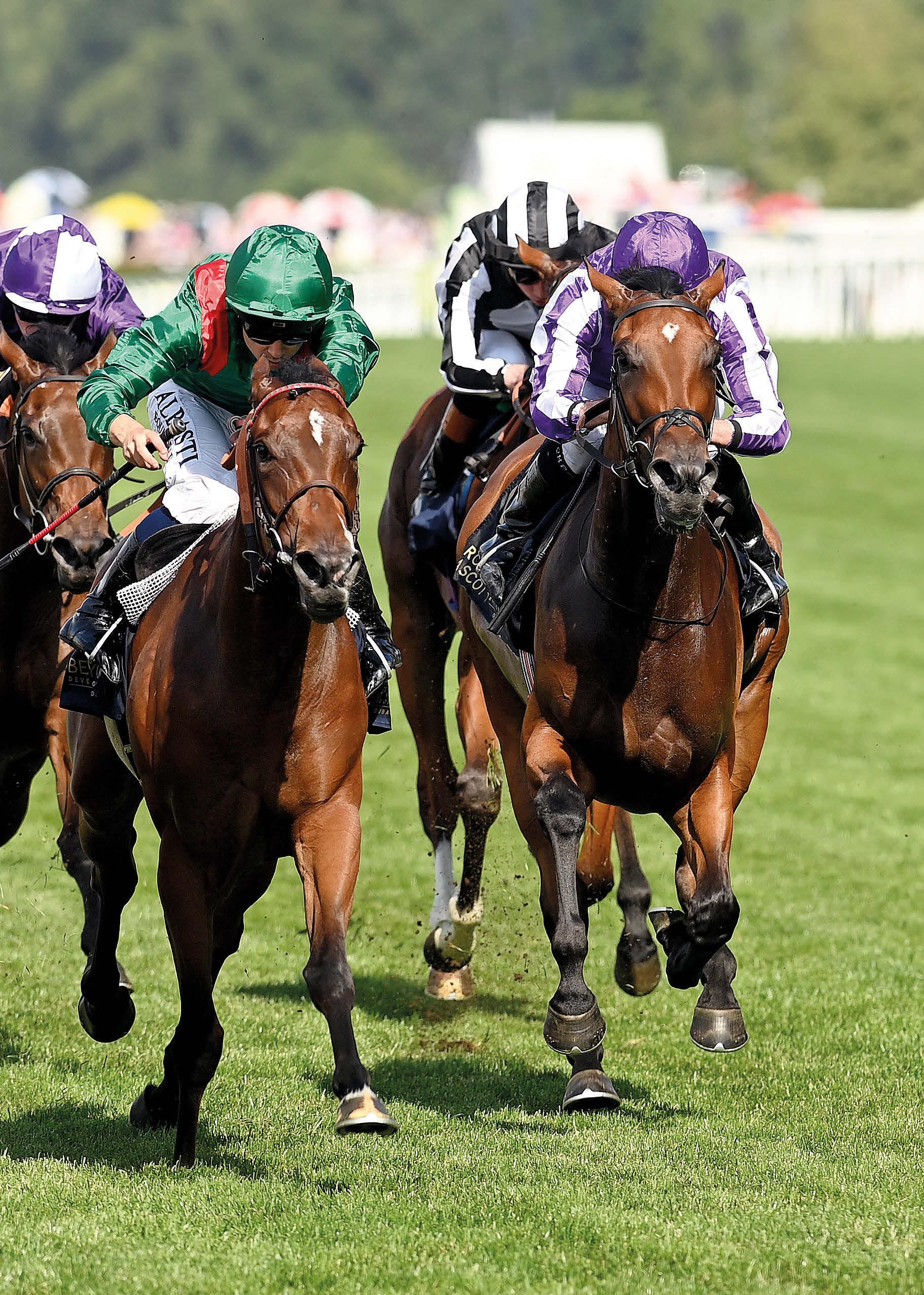

Trainer Joseph Murphy and jockey Gary Carroll (above) enjoyed their biggest success together when Cercene (main image, left) fought off French raider Zarigana to win the Coronation Stakes. However, there was a sting in the tail for Carroll, who was later handed a 14-day ban and fined £5,800 for whip misuse in the Group 1 contest.
Photos Bill Selwyn

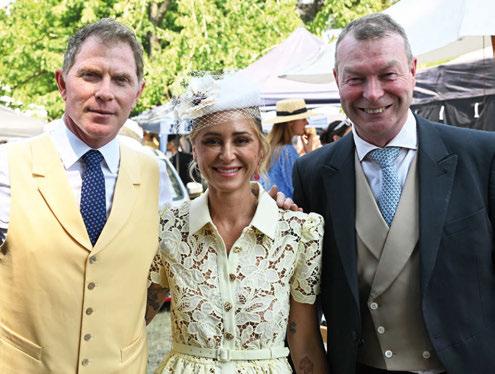
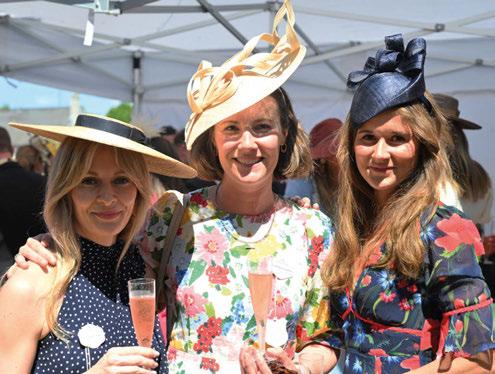

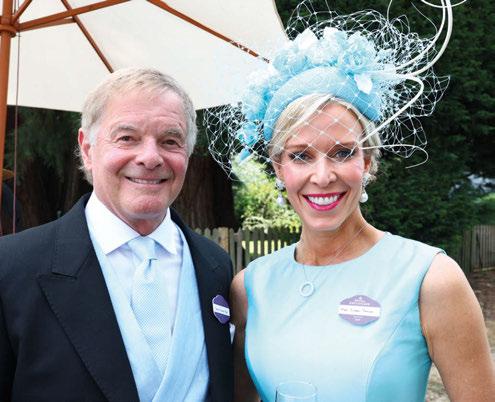
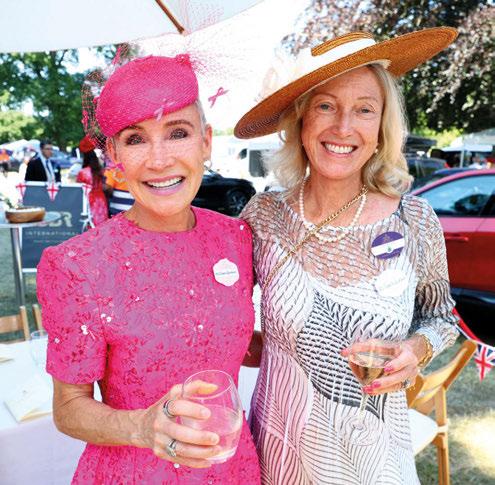


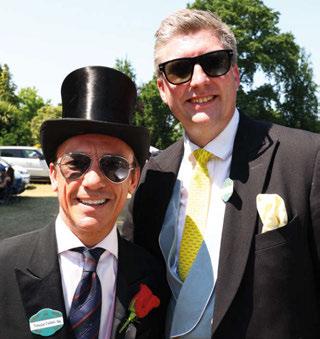
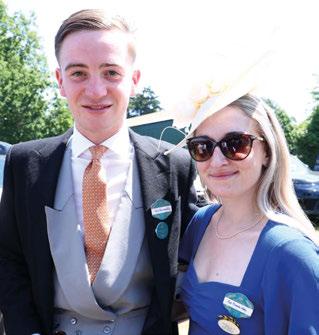
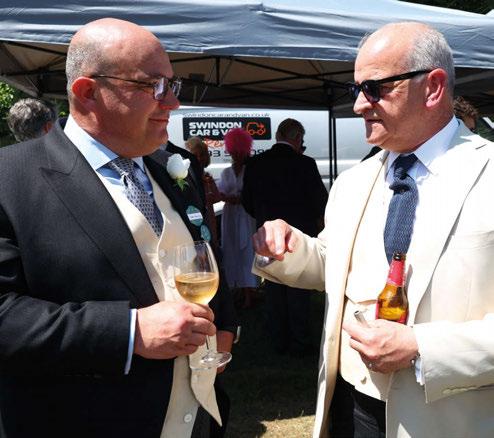
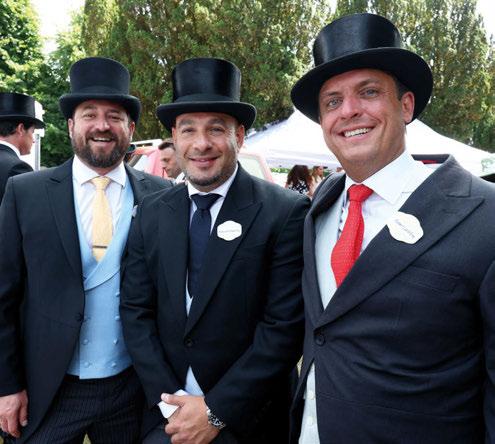
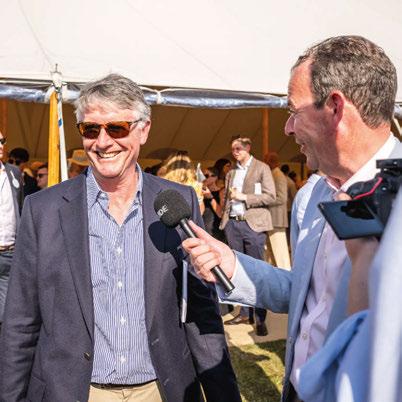
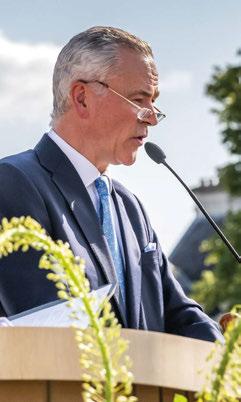

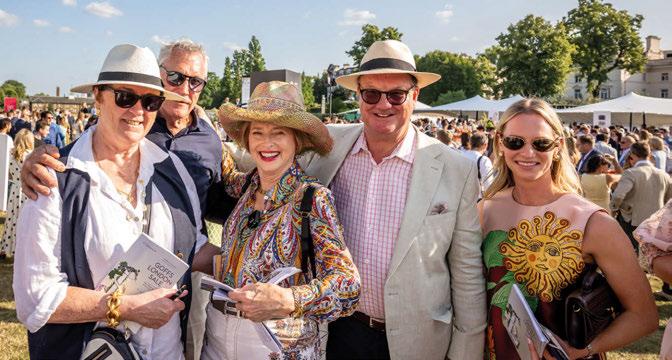

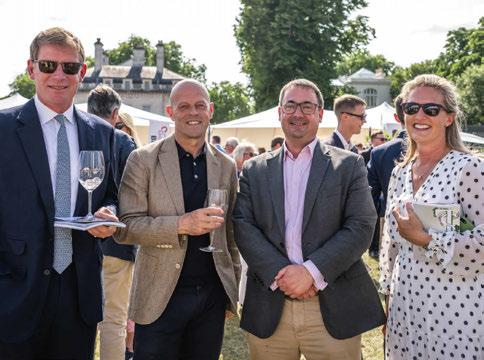
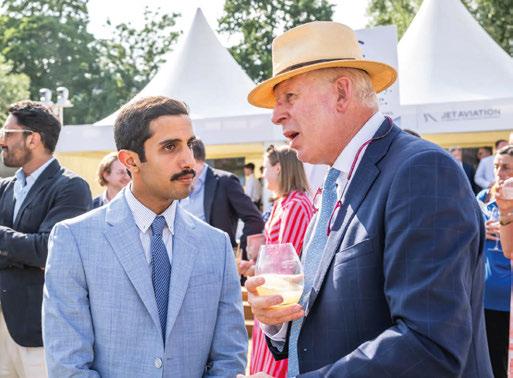

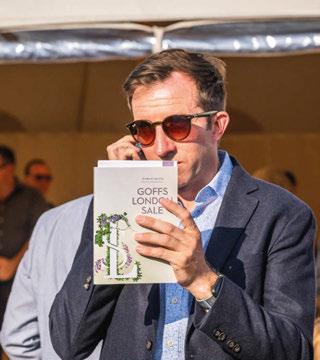

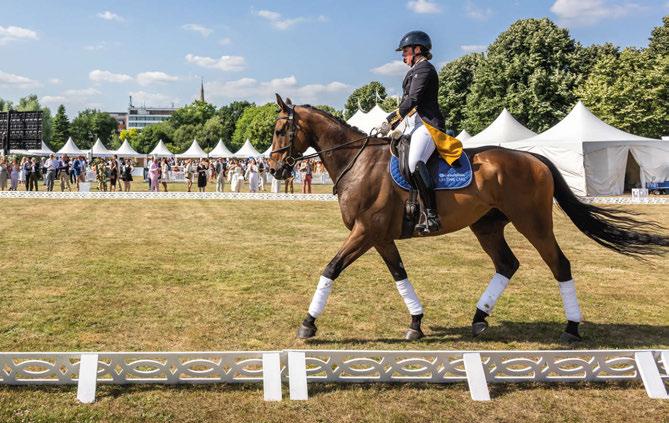

BY JAMES BURN
Jannik Sinner, the world’s highest-ranked men’s tennis player, might be doing his bit for Italian sport, but the national football team, which unites the country like nothing else, is on a downturn that might make the racing industry feel positively optimistic about its own health.
Only Brazil have won more World Cups than the Azzurri, which have humiliatingly missed the last two editions of that particular jamboree and recently fell to a chastening 3-0 defeat at the hands of Norway – a result that meant manager Luciano Spalletti was heading for the exit door.
His experience in dealing with that crisis may have made him an ideal candidate to cross over into racing in Italy, which has been in a sorry state in recent years but is showing some signs of recovery.
Indeed, Remo Chiodi, the government minister in charge of things, is on the front foot, insisting “an intense renewal process is underway”.
Luca Cumani, the celebrated Italian trainer who made his name in Newmarket, does not go quite so far, but reckons “it’s a bit better than five years ago, although there’s still a long way to go”, while Marco Botti, who is also based in Suffolk, was encouraged by the crowd at Capannelle racecourse in Rome for June’s Derby Italiano, which he landed with Molveno.
“It looked packed and that was nice to see,” says the trainer whose raider trousered just over £240,000.
In 2009, when the Milan-born Frankie Dettori – arguably the sport’s most recognisable face worldwide – captured the race on the Saeed bin Suroor-trained Mastery for Godolphin it offered nearly £360,000 to the winner despite it being staged as a Group 2 for the first time.
That is around the period things spiralled into decline in a nation that boasts a proud racing history through the likes of legendary owner-breeder Federico Tesio, whose masterpiece Ribot’s unblemished 16-from-16 career included two triumphs in the Prix de l’Arc de Triomphe alongside success in the
King George VI and Queen Elizabeth Stakes.
Tesio, unique among owner-breeders in that he trained his horses, was also responsible for Nearco, one of the most influential stallions of all time whose son Nearctic was the sire of Northern Dancer, who, in turn, fathered Sadler’s Wells (among many other game-shapers), which, of course, led to the similarly exalted Galileo.
However, by 2019, the country had lost all of its Group 1 contests when the Premio Lydia Tesio, named in memory of the wife of the greatest single figure in the history of Italian racing, was demoted to Group 2 status.
The reasons why Italy is now regarded a second-tier racing jurisdiction, despite still regularly producing proficient horsemen, are manifold.
Poor administration and lack of confidence in governance is something Botti, who hails from one of the foremost racing dynasties in his homeland, identifies as a contributing factor.
Cumani, experienced in industry politics through his time on the BHA Board, backs a recent reduction in betting tax to bring it into line with other sports. “A gambler is a gambler, but a gambler is also smart enough to know
where he can make the most money,” he reasons.
For bloodstock agent Valfredo Valiani, the legalisation of sports betting has lured racing punters elsewhere. He has worn many hats during his career and saddled Electrocutionist to win the Juddmonte International in 2005. He says: “Some thought that would be better for racing because it would bring in new people who’d gamble on it, but I was President of the trainers’ federation and thought, like many, it was very dangerous.
“I thought they would bet more on other sports and less on racing, which is what happened.”
A reduction in foal numbers and image problem – “we’re perceived to have a dirty face but the face is actually pretty good; it’s just got some dust on it,” according to Valiani – are other roots of the problem, but, unsurprisingly, slow payments of prize-money have played a crucial, crippling part too.
“I can’t imagine us recommending any of our owners to take a horse to Italy,” Gill Headley, financial director for Mick Channon when he trained, said in 2014.
Something is being done, though.
“Talking to different people on Derby day, it sounds like the issue they had with slow payments is speeding up,” explains Botti. “That would be a positive thing for sure and the most important thing for overseas owners and trainers.
“There is no doubt they look after owners at the track, but everyone was concerned about when they’d get paid. As far as I know, they’re paying much quicker. Even if it’s up to 90 days and you know you’ll get paid, that’s fine because
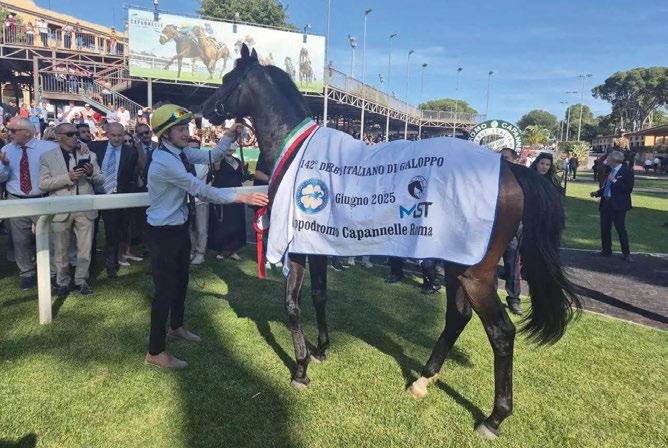
you didn’t have a clue before.”
Cumani senses that upswing too and Chiodi, an engineer by trade who oversees the sport through his role as General Manager of the Italian Ministry of Agriculture, Food Sovereignty and Forests (Masaf), is committed to improving the problem along with everything else.
“The reason for the Italian decline is due to a combination of factors,” he says. “First of all, especially in the past, the lack of a strategic long-term vision for the industry to address the changing of society and deal with animal welfare issues. This meant an absence of marketing strategy and campaigns, downgraded black-type races, a sharp reduction in foal crops, especially long delays in prize-money payments, and lack of generational turnover within the stakeholders and racegoers.
“But there is a clear and genuine effort by Masaf to drive meaningful reform across the sector and there’s strong political support for it.
“There is a goal for an average prize-money increase of 15% next year”
“In 2023 the Italian government began a structural reform to make horseracing an economic resource for the country, considering the relevant role that this sector can play in the development of an advanced nation.”
Detailing some of the progress that has been made, he continues: “Prizemoney payments are becoming faster, regulations are being modernised, betting taxes have been reduced, a two per cent additional tax on virtual betting has been introduced, a VAT reduction on the purchase of yearlings has been approved, and important investments are being made in racetracks. Last but not least, the extra resources ensured to horseracing in the government financial law for year 2025 were approved by parliament at the end of December 2024.”
Chiodi’s agency took over governance of Italian racing in 2011, replacing Unire (Union Nazionale Incremento Razze Equine), which was then the national
authority and something resembling a traditional Jockey Club.
Botti acknowledges bureaucratic delays back home are not limited to racing and is generally “an Italian thing”, while Valiani feels stepping away from government rule is needed.
“Now, to change the rules of racing, you almost have to make a law, which takes ages – if you want to know if your horse is qualified for a race you might never get an answer if you ask the ministry,” he half-jokes, but Chiodi does recognise “significant challenges” to the existing system.
He too notes the “bureaucratic constraints and limited flexibility compared to privately run models in other countries”, issues he seeks to “overcome through a major reform toward establishing a semi-private company or agency, as seen in France or the UK”.
While reducing prize-money payment delays to fewer than 75-90 days, increasing transparency, and updating welfare and doping rules are “short-term” aims, raising average prize-money, stimulating Italian breeding and sales, and creating a new organisational body are “medium-term” goals, for Chiodi, who believes its implementation “would allow for independent, professional governance with clear accountability and operational efficiency”.
He adds: “It could attract private investment, enhance credibility with international partners and adapt more quickly to industry trends - something Italy’s ministry-led system currently struggles with,” revealing upcoming networking events are planned in London and at Newmarket’s July meeting.
Longer term, restoring Group 1 races in Italy is, in Chiodi’s words, realistic but only with sustained progress – something that would also assist the objective of regaining Italian racing’s reputation abroad.
Compared to football, racing in Italy “pales into insignificance”, Cumani opines, while Valiani bemoans the diminished media coverage.
Chiodi feels the launch of streaming service Grande Ippica Italiana has been a useful addition for those wanting to follow the action but agrees the link between the sport and public has been lost.
“Racing retains a cultural and historical presence, particularly in local communities through traditional events and strongly rooted races, but its mainstream popularity has declined,” he goes on. “The government’s aim is to
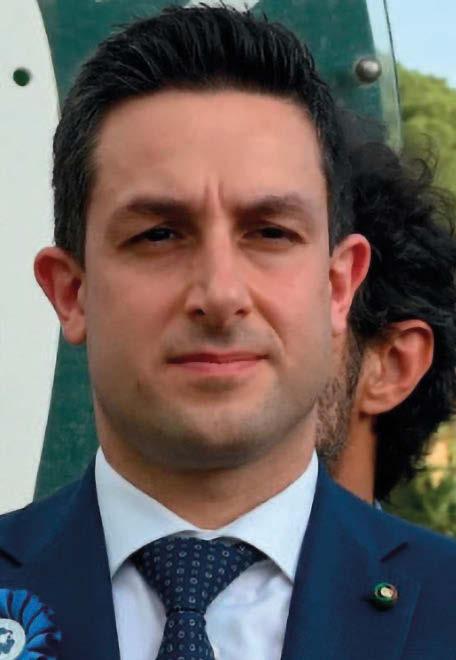
reconnect racing with the public through transparency, communication and modernisation.”
Buoyed by the 15,000-strong crowd for the Derby Italiano – “a remarkable result for an Italian racecourse” – Chiodi believes other metrics can illustrate the darkest days might be in the past.
“Some indicators show early recovery,” he says. “For example, foal numbers rose from a low of 422 in 2018 to 556 in 2023, and an additional 130 foals were bred abroad by Italian breeders.”
VAT on yearlings, meanwhile, was reduced from 22 per cent to five per cent, €10–12 million in additional prizemoney is expected from the new virtual betting tax, and there is a goal for an average prize-money increase of 15 per cent next year.
Some of those improvements for Valiani, a former amateur jockey who trained for 25 years, are “too small” but he stresses: “I’m an optimistic person and I’m optimistic for racing because I know the potential of racing in Italy.
“I hope people in Italian racing can get together and look for the day after tomorrow and not just today.”
That outlook might be welcomed by Chiodi, who maintains “one of the greatest challenges is the mindset within the racing community” because “many insiders lack optimism and resist change”.
For those in Italian racing, there have been many reasons to lack optimism, but – if Chiodi’s plans come off – further change in the sport’s fortunes could easily be in the offing.

Basher Watts
Losing a Classic in the stewards’ room would test the resolve of most owners, yet for Basher Watts, who manages the syndicate behind Shes Perfect, the desire to reach the top of the sport remains as strong as ever
Words: Marcus Townend • Photos: Bill Selwyn
What a difference a year can make. Basher Watts spent part of the Derby weekend in the Jockey Club box at Epsom chatting to fellow guests Princess Zahra Aga Khan and her trainer Francis Graffard about the controversial stewards’ enquiry involving their respective fillies in the French 1,000 Guineas at Longchamp.
Skip back 12 months and the only chance of the trio exchanging words on a racecourse would have been if the Princess and Graffard had made the unlikely choice to order a crepe or waffle from Watts’ mobile catering unit.
It was only in June last year that Watts took the plunge and abandoned a job which he didn’t like too much – but which paid the bills – to follow his horseracing passion.
It was a calculated gamble, a ‘’leap of faith’’ as Watts describes it, but he emphatically backed a winner as a dizzying sequence of events testify.
In August last year, Watts had the first runner in his syndicate’s colours when Shes Perfect won a fillies’ maiden at an evening meeting at Haydock.
That daughter of Sioux Nation, the apple of Watts’ eye, was recently the subject of an unsuccessful offer of £2.2 million from a Japanese breeder after finishing first past the post in the French Classic in May, only to have the prize taken from her in the stewards’ room.
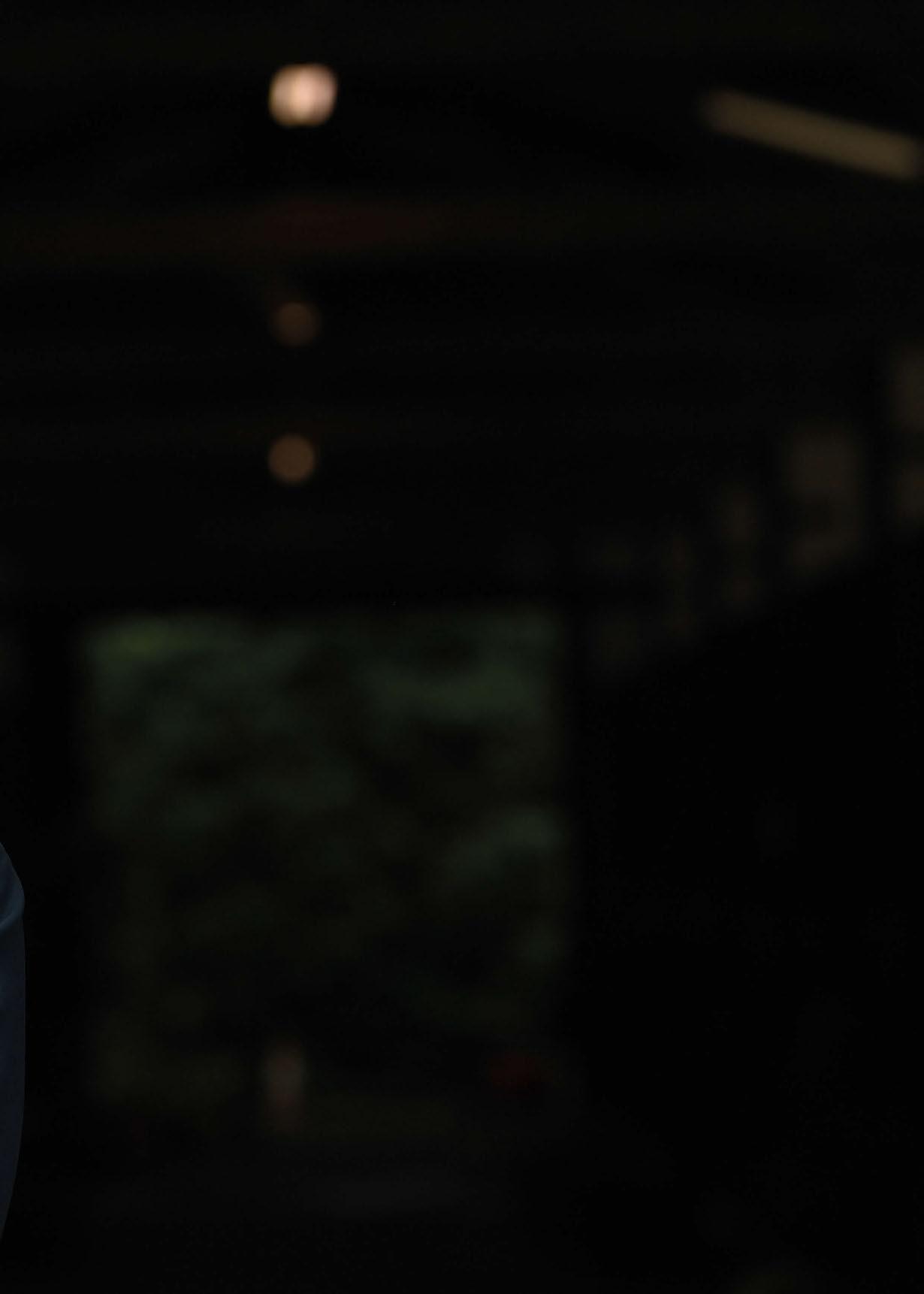
on marketing has often struggled to do in the past in this sport –engage and bring people into racehorse ownership who would not have known how to become involved or, even worse, felt intimidated and unwelcome by what can seem an alien world.
Quite simply, Basher Watts has shown what can be done when racing and social media work harmoniously in tandem.
As we meet in the owners’ room at Bedford Lodge stables in Newmarket, the base of trainer Charlie Fellowes, the man entrusted with seven of the nine horses in his string, Watts outlines how one of racing’s most iconic moments lured this novice into the sport.
Watts, who has just added Rebecca Menzies to his trainer roster and has a National Hunt prospect in the Ben Pauling stable, says: ‘‘None of my family have been brought up around horses and I wasn’t taken racing when I was younger. I was around 17 or 18 when I saw my first thoroughbred up close.
“The roar at the Cheltenham Festival – that’s what got me hooked”
It was drama that was first joyously, and then agonisingly, captured on camera and played out in the social media world which Watts inhabits so infectiously that many of his followers have now become clients.
The situation has snowballed so successfully that Watts – or Bash to his friends – now has nine horses spread among three trainers and between 600 and 700 clients split between his syndicates and the Basher Watts Racing Club, which has no horses but from as little as £17.50 a month organises days at the races and trips to stables for like-minded racing fans who, just like Bash used to be, are looking for friends to enjoy their hobby with.
Watts is seriously guilty of understatement when he says: ‘‘It could not be going any better.’’
The 31-year-old has also done what fortunes previously spent
‘‘I went to the 2011 Guineas meeting at Newmarket with a friend and we saw Frankel win the 2,000 Guineas on the Saturday. Then, the first bet I ever placed was £10 on Blue Bunting to win the 1,000 Guineas at 22-1. That weekend is the first memory I have of racing. It was fantastic and I just got the bug from there.
‘’I had no idea what was going on, but I am a bit of an adrenaline-seeker. I love those exciting moments and the buzz. The big turning point was the first time I went to the Cheltenham Festival. The roar when a horse jumps the last, that’s what got me hooked.’’
Watts, who graduated from Buckinghamshire New University with a business degree, expanded his racing education when taking on a marketing role at Huntingdon racecourse, but when the desire to work for himself became too hard to resist and Watts left to launch his mobile catering business as The Food Dude, it was as a syndicate owner that he started to learn more about the sport.
As a member of the Millennium Racing Club, which supplied Watts with his first winner courtesy of the Fergal O’Brien-trained Une De La Seniere, and then with small shares in syndicates run by Nick Brown, Watts began to wonder if he might be able to set ››
up on his own.
However, it still seemed a far-fetched concept until Watts started chronicling his days at the races on social media videos called ‘An Honest Day’s Punting’.
Watts recalls: ‘‘For 18 months it was in the back of my mind that I would love to start my own syndicate, so I used being part of them to learn and see whether I could make it work. But it wasn’t until I started posting content on social media that it was ever going to be a possibility.
‘‘I was just an average racegoer, as I am now, but people seemed to enjoy my content.
“It can be hard for someone in their 20s to find mates to talk racing with”
‘‘With ‘An Honest Day’s Punting’, I was showing my stakes and the winners and losers so people could see I was just like them. Often, I would not back a single winner. It was not fabricated to make it look better. I think a lot of people related to that and I built up quite a lot of trust.
‘‘I started it just to find other people who loved the sport. It can be hard for someone in their 20s to find mates who you can talk racing with and also go racing with.
‘‘For me, horseracing is the best sport in the world, but it is also one of the most niche sports.
‘‘If you stop 100 lads in the street and ask them who won the Premier League last season, 90 to 95 would tell you it was Liverpool. But if you stop 100 lads and ask them who won the Cheltenham Gold Cup, you would be lucky if five could tell you.’’
Watts also began posting on social media about his owning experiences.
He recalls: ‘‘I did ‘An Honest Day as a Racehorse Owner’ following the horses I had a one per cent share in. It was the stuff you normally don’t see, from the horse being saddled to the jockey talking prior to the race.
‘‘I had loads of people ask me, ‘Who do you recommend for a syndicate and where do I find good one?’ and saying, ‘I would love to get involved but don’t know how’.
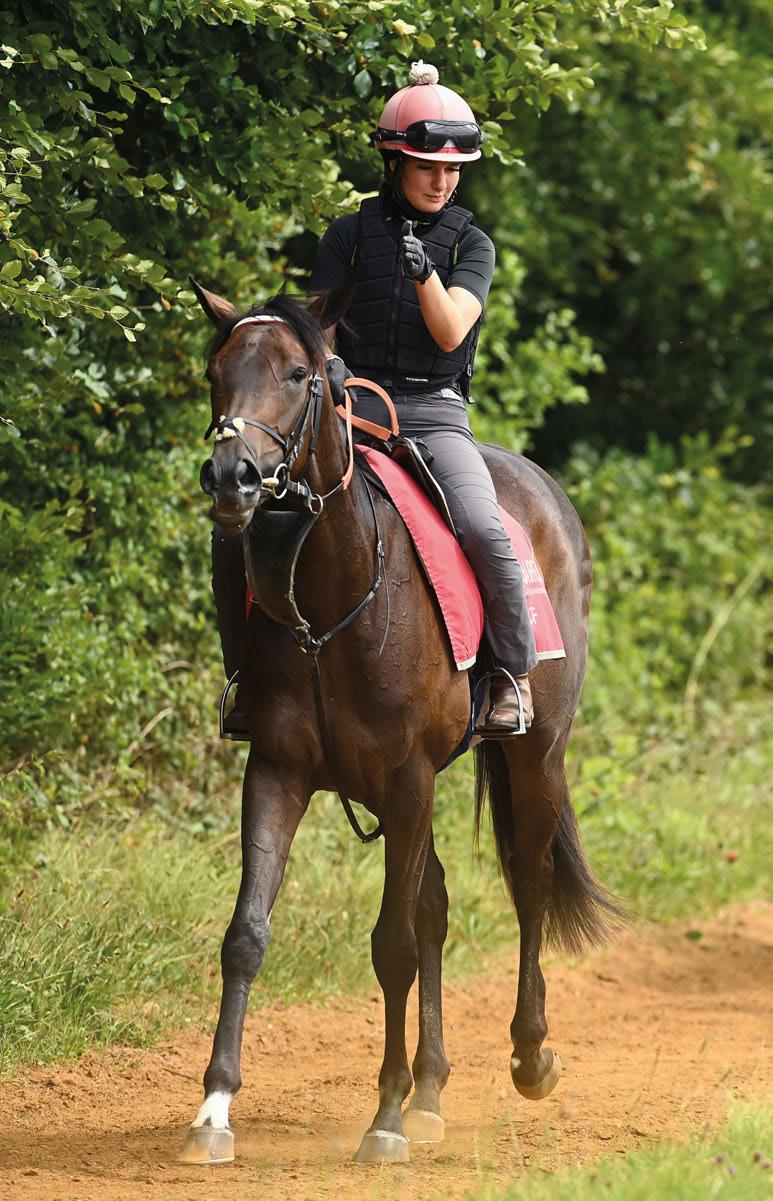
‘‘One day, just as I was about to serve at an event with my catering company, I put a quick video up saying it had always been my dream to have my own horse and telling people to let me know in the comments if they would be interested in joining me. Luckily
enough, I had loads of people interested.
‘‘All the owners are through social media, with the older demographic more through YouTube. The older ones send me a nice email whereas the youngsters drop me a WhatsApp. I
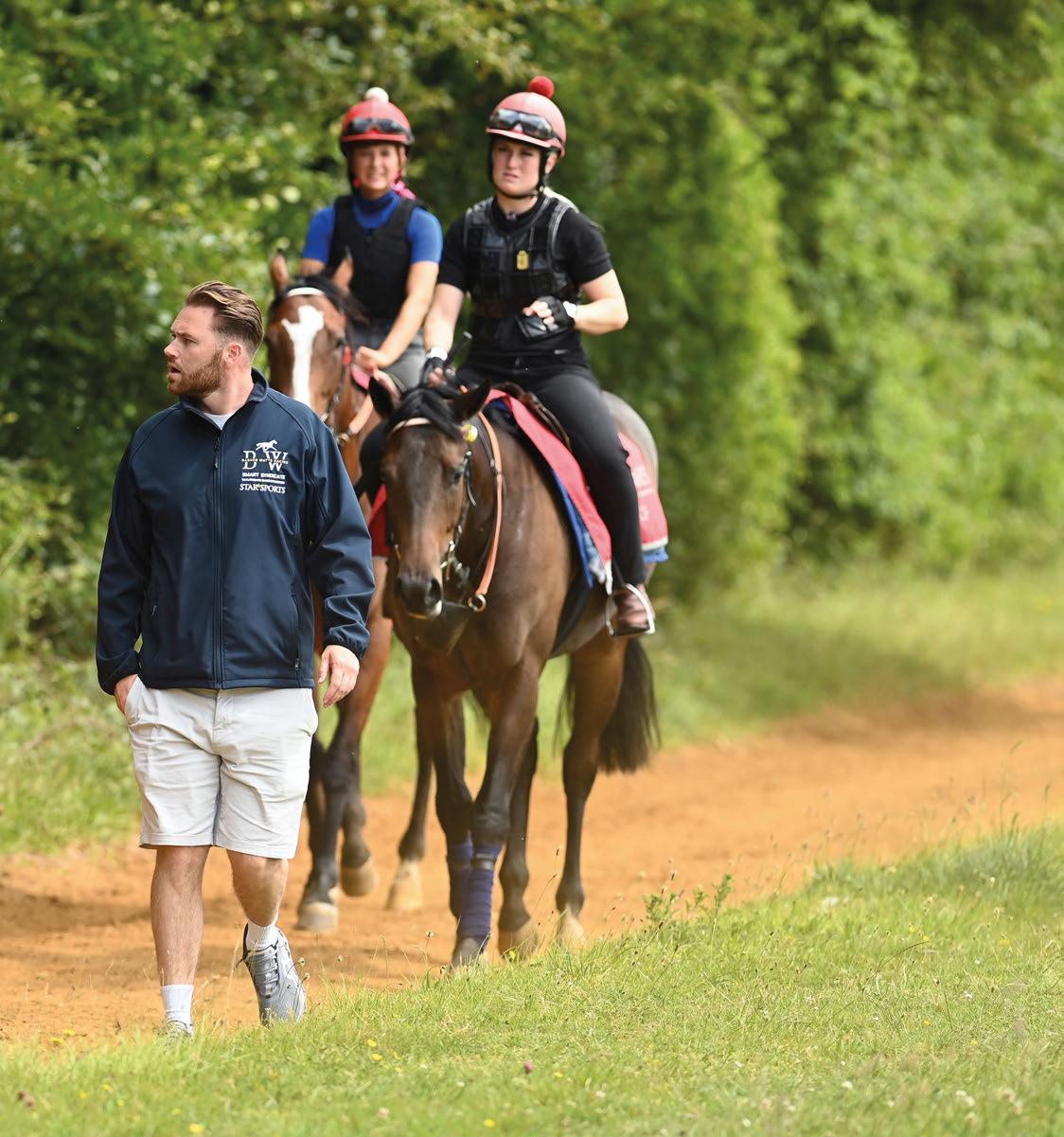
absolutely love having a wide variety of people involved.
‘‘When you see some syndicates, they all seem to be similar ages, but the amazing thing about ours is you have an 18-year-old sat next to a 30-year-old who has just started a family next to ››
Basher Watts chats to work rider Lily Waites after morning exercise and below, with fellow syndicate members, trainer Charlie Fellowes (cap) and Kelly Cochrane, who manages the stable’s owner communications
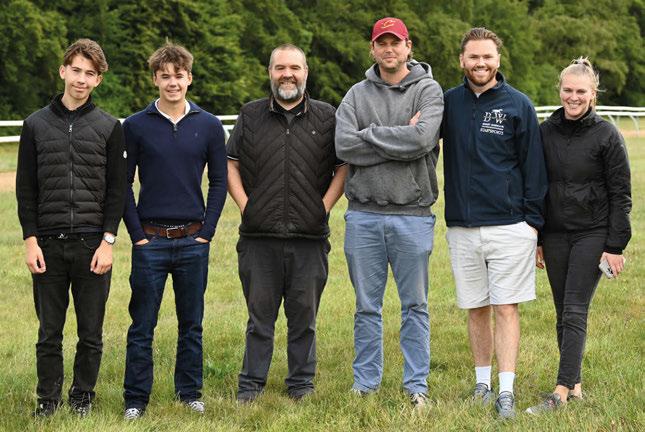
‘The feeling we had was worth more than money’
The exploits of Shes Perfect, who cost €50,000 at the 2024 Arqana Breeze-up Sale, thrust Watts into the spotlight. The filly passed the post first in the French 1,000 Guineas in May, only to lose the prize when the Longchamp stewards deemed Kieran Shoemark’s mount had hampered Zarigana, who was promoted to first place.
A subsequent appeal by Watts and trainer Charlie Fellowes was dismissed by France Galop.
Watts says. ‘‘The thing that made it so painful was that initially we didn’t know there was a stewards’ enquiry. It wasn’t until after the winning photographs and Charlie had been interviewed that the TV presenter said, ‘You do know there is an stewards’ enquiry?’
‘‘We are not a massive organisation who can spend half a million quid. We spent €50,000 on Shes Perfect and hoped to get lucky. I could be doing this for 40 years and might never get that again. That was the bit that got me.
‘‘I didn’t think she had done anything wrong and still don’t, especially when you look at the drone footage and rear-camera footage.
‘‘It was extremely tough to take but I felt responsible for the mood of the whole syndicate. I said to them that if someone had said we would be second in a Classic at the start of the day we would have bitten their hand off and that we have one of the
someone who is 50 and someone who is retired. I don’t think you would get these people in the same room unless they were sharing one passion. We are all just there for the love of our horse.’’
Unsurprisingly, Watts did not follow a conventional path in the purchase for €30,000 of his first horse Believe The Storm; he contacted someone he had met during a tour of the Irish National stud while on a friend’s stag weekend!
He explains: ‘‘I realise now how naive that sounds, saying to a random Irishman who I had only met once that I wanted to spend €30,000 on a horse, but I feel I am a very good judge of character, and you have to make mistakes to not get things wrong in the future.
‘‘I did everything wrong with Believe The Storm. He cost me hundreds of pounds every month because I charged way too little, but I learnt that for my next horse.’’
Watts chose Fellowes to train the son of Make Believe – who didn’t make his debut for 18 months but has won once and finished second twice in three runs – partly because he used to drive past the trainer’s Bury Road stable on the journey to Newmarket from his home in Dereham in Norfolk. But there was also logic behind the choice.
‘‘It was the best decision I ever made. I now consider Charlie one of my best friends,’’ Watts says. ‘‘If I had gone
best fillies in the world.’’
Clearly, someone agreed, with a £2.2m bid for Shes Perfect received from a Japanese breeder before she was ninth to Gezora in the last month’s Prix de Diane at Chantilly, her stamina running out on the step up to a mile and a quarter.
The offer was overwhelmingly rejected after Watts put it to syndicate members.
He says: ‘‘Only one out of her 38 owners said yes. Everyone else said absolutely no chance. You get involved with horseracing with a tiny dream that you could potentially get one like her. That feeling we had for 15 minutes at Longchamp was worth more than money.’’
Shes Perfect’s defeat in the Prix de Diane has not altered Watts’ view. The filly has an entry in the Group 1 Falmouth Stakes at Newmarket’s July meeting and Watts is looking forward with trademark positivity.
He adds: ‘‘The overwhelming feeling was a sense of pride to have a runner in the Diane. You really got an understanding of how huge the occasion was. The race didn’t go how we wanted and you always hope to be more involved than we were, but we all had an absolute blast.
‘‘She has come out the race safe and sound and we now know to stick to a mile. She has an entry in the Falmouth. I would love to see her there – but we will see how she is.’’
to a yard with 150-200 horses, I might not have got the one-to-one time that I get here with Charlie. Also, some of the old-school trainers might not want an owner who pushes a camera in their face. I am also learning as I go and sometimes ask stupid questions.
‘‘Charlie embraced that – now I run his social media. He’s young, enthusiastic, ambitious and a fantastic trainer.’’
“The amount of red tape and admin to get a syndicate going is ridiculous”
For every horse in his syndicates, Watts has two WhatsApp groups, one for formal news updates and one to facilitate chats and discussions between fellow owners so they don’t feel like strangers when they meet at the track.
His background means Watts can view racing with objectivity and he admits he has experienced some frustrations. It annoys him that he
cannot always gain paddock access for all his syndicate members, especially on days when some paddocks clearly have capacity.
‘’There is nothing more depressing than an empty parade ring. Tracks should be encouraging owners to go in there,’’ Watts says.
‘’We are in a tough spot and it has not been helped from within – there is a lot of resistance to change. I just know from becoming an owner the amount of red tape and administration to get a syndicate going is ridiculous.
‘’It took me six weeks to get a bank account open with Weatherbys. I remember saying to them on the phone I can get a Monzo account in five minutes. Things are so stuck; racing needs a new vision moving forward.’’
Great British Racing recently launched its latest marketing campaign for the sport, backed by £3.6m of Levy Board funding. What impact it will have remains to be seen, yet Watts understands there is a way forward if you hit a sweet spot.
“To get anyone to really connect with what you are doing, you have to communicate the feeling and that is why so many people have got on board with what I do. I am a very emotional character. When a horse wins, I am in tears,’’ Watts says.
‘‘People feel that emotion. I feel a lot of the marketing campaigns are very
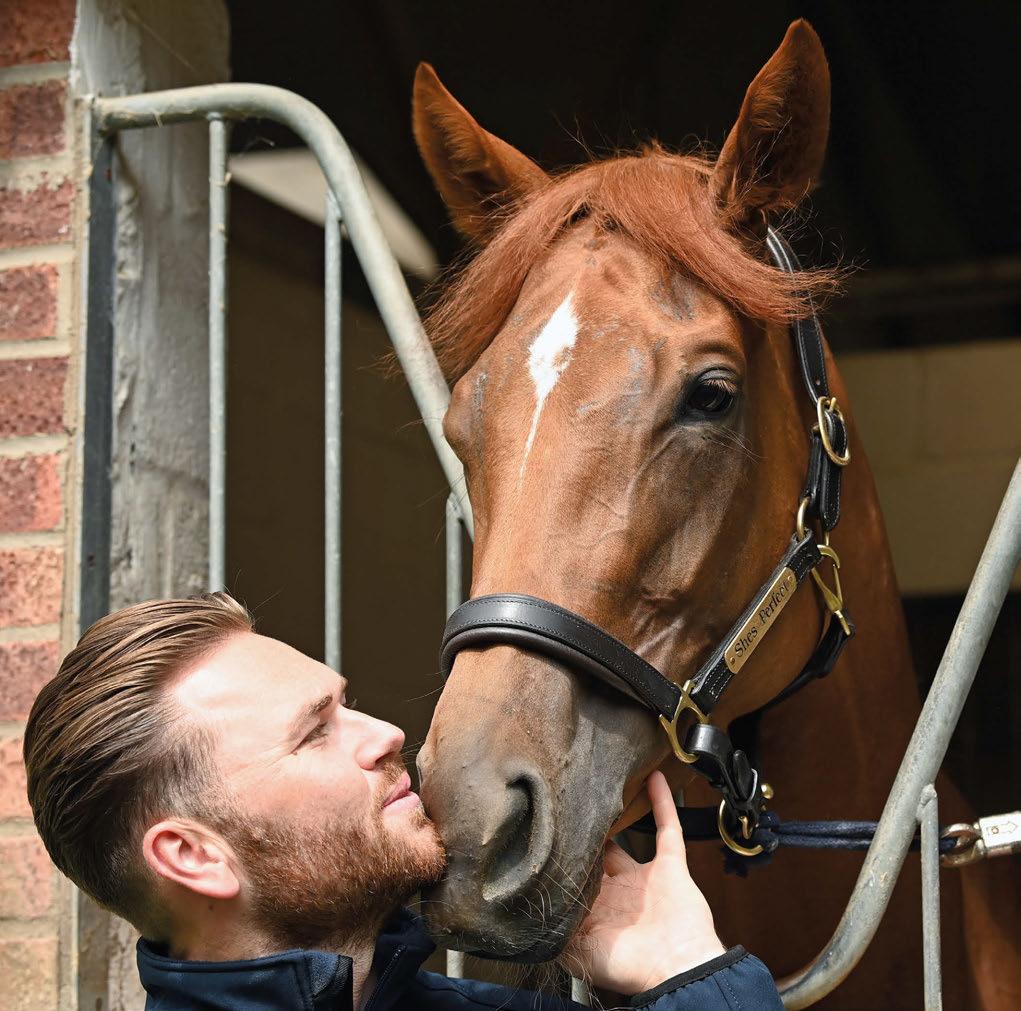
boring. It is tick-box and doesn’t communicate the feeling of racing.
‘‘I know friends who have gone to an Olly Murs show at Newmarket and when I ask them about the racing, they’ll say they had a picnic in the car park until it finished and then went in to see the concert!
‘‘We are getting people through the doors and spending at the bars but not really interested in the sport. Yet the majority of people I speak to will be in their twenties and I see their enthusiasm.
‘’Racing always seems to be reactive
rather than proactive. It got to the point where attendances fell so badly at the Cheltenham Festival they had to do something. It shouldn’t be like that. It should be attendances are good, how can we grow them or maintain them rather than waiting for it to get so bad you have no choice.’’
There is little doubt the success of Basher Watts Racing is built around Watts’ personality. He is an engaging character. His personal touch is his big selling point, something he is aware he needs to maintain as he considers how big his operation ultimately might
become in the future.
Of course, he wasn’t named ‘Basher.’
His real name is James, but Basher stuck after his great grandfather gave him the nickname when he was loud and bullish as a toddler. It has worked in his favour as he makes an impact on the world of racing.
‘‘You don’t forget Bash; you’d forget James quite easily,’’ Watts says with a smile.
‘‘Everything I do I am just being myself. Take me or leave me, hopefully you’ll like me. People are watching me live my dream and I love it.’’
Strength at the top end of the breeze-up market yielded some record returns and memorable pinhooking triumphs, but it wasn’t all plain sailing, with a polarised trade also presenting its share of challenges
Words: Ronan Breslin
This analysis will look at the major sales during the 2025 European breeze-up season, namely the Tattersalls Craven, Goffs UK, Tattersalls Guineas, Arqana May and Tattersalls Ireland Sales.
I will start by giving an overview of the broader market performance before delving into the relationship between breeze time and sales performance, stallion performance, pinhooking sources, how cheaply purchased yearlings performed vs more costly purchases, and then finally looking at sales performance by month foaled.
Before beginning, a few minor housekeeping points to note.
All financial figures have been converted to GBP using constant exchange rates (€1 = £0.85, $1 = £0.75, 1gn = £1.05).
Average prices, unless explicitly stated, only look at those lots that did sell (be it in the ring or privately, in line with how the sales companies typically
report these figures).
Pinhooking multiple is defined as sales price as a breezer divided by yearling purchase cost (i.e. a £25,000 yearling purchase sold for £100,000 =
“The 2025 breeze-up season delivered notable gains”
100/25 = 4x pinhooking multiple).
Gross profit is defined as sales price as a breezer less yearling purchase cost (i.e. a £25,000 yearling purchase that sold for £100,000 = 100 – 25 = £75,000 gross profit).
Any horse that was vendored or not sold as a yearling is not included in any pinhooking data or calculations.
The 2025 European breeze-up season delivered notable gains despite a reduction in volume. A total of 875 lots were offered, representing a yearon-year decline of 6.5 per cent, yet overall turnover increased significantly to £70.5 million, compared with £57.9 million in 2024, with this growth driven by increases in average price, which reached £97,000 up from £77,000 the previous year.
The clearance rate also improved, rising to 84.9 per cent from 80.1 per cent, benefitting from the reduction in lots offered.
One of the most striking features of the season was the strength at the top of the market, following on from an incredibly strong top end at last autumn’s yearling sales.
Celestial King: record 1,750,000gns colt was one of four seven-figure lots sold during the breeze-up season
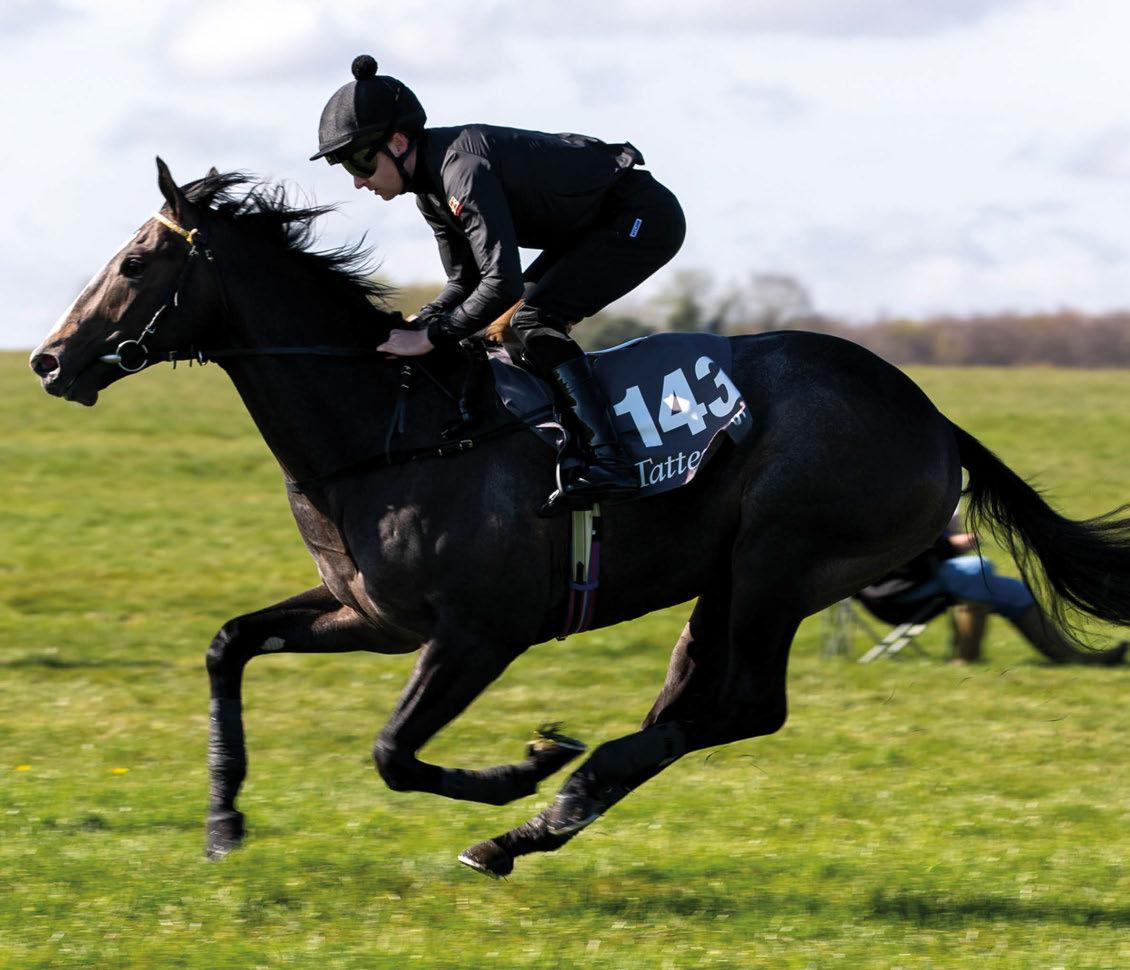
A total of 56 horses achieved sale prices of £250,000 or more, compared with 38 last year. The mid-market also showed resilience at the premier sales, namely the Arqana May and Tattersalls Craven auctions where the average price – excluding the top 20 lots –approached £100,000.
In contrast, the lower end of the market remained under pressure.
At the Tattersalls Ireland and Guineas Sales, average prices (again excluding the top 20 lots) increased only marginally to £33,000 and £30,000 respectively, with medians of £26,000 and £24,000. These figures suggest limited profitability for many vendors once acquisition and keep costs are
factored in.
The clock plays an important role in breeze-up purchase decisions, and one would expect there to be a relationship between how fast a horse breezes and how it performs in the sales ring. The correlation coefficient is a statistical measure that quantifies the strength and direction of a relationship between two variables.
We examine how a horse’s breeze rank (according to a set of published times seen by the author) relates to its sale price rank. A coefficient of 0 indicates no relationship, while 1 indicates a perfect positive relationship,
where the fastest breezer always achieves the highest price.
Looking only at lots that sold, the correlation between breeze rank and sale rank ranged from 0.57 to 0.63 across the five major sales, indicating a moderately strong relationship. That it’s not perfectly correlated is expected since buyers also consider factors such as style, gallop-out and stride analysis during the breeze, alongside your traditional variables such as pedigree and conformation.
What is also notable is the narrow range, suggesting the clock carries largely consistent weight/value across all sales.
Of the top 100 selling horses, 73 ››
clocked within the top 60 of their respective sale. At the lower end, among the bottom 200 sold lots, nearly 55% recorded times in the slowest 60.
Offspring of 152 different stallions went through the ring across the five sales, with Sioux Nation leading by volume (47 offered) and posting a strong 85 per cent clearance rate. Mehmas (41/80%), Havana Grey (38/87%), Starman (34/92%), and Cotai Glory (26/81%) rounded out the top five. Kodi Bear deserves mention as all 22 of his offered progeny sold while he also posted the third-highest average pinhooking multiple (7.4x), behind only Cotai Glory (9.3x) and Coulsty (8.7x).
Looking at the highest average sales prices for stallions with five or more offerings, the top end was dominated by elite sires commanding premium fees, namely Night Of Thunder (average of £484,000), Too Darn Hot (£283,000), Siyouni (£229,000), Wootton Bassett (£219,000) and St Mark’s Basilica (£218,000). Just behind was Havana Grey, whose 38 sold averaged £193,000, an exceptional return for a stallion who stood for just £6,000 when this crop was conceived, and justified by his strong record on both the track and the breeze-up circuit in recent seasons.
Of the breeze-up horses offered, 632 (72%) were purchased as yearlings, with another 111 having failed to sell as yearlings before being offered at the breeze-ups. Part 1 of the Tattersalls Ireland September Sale was the leading
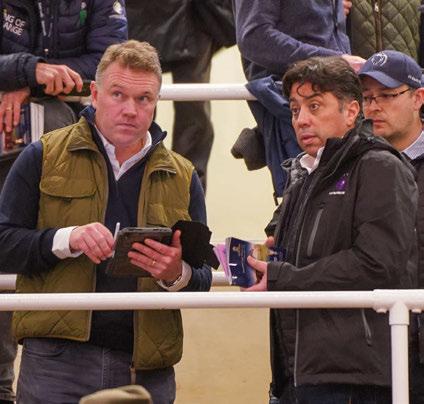

Anthony Stroud: key player
source of yearling pinhooks (87 lots), followed by Tattersalls October Book 2 (74) and the Keeneland September Sale in Kentucky (68), the latter highlighting a willingness to travel for stock.
Tattersalls October Book 1 (£291,000) and the Arqana August Sale (£224,000) came out on top by average sales price, but both would have carried high yearling investments given their premier status.
The best average pinhooking multiples (for sources with five or more lots) came from the Fasig-Tipton October (5.0x), Goffs February (4.7x), and Tattersalls Ireland September Part 2 Sales (4.6x), reaffirming that the cheaper yearlings who can be sourced at these lesser sales can provide stronger upside potential from a multiples perspective.
Operating leverage is a commonly used term in financial analysis, referring to the relationship between a company’s cost base and its revenue. A business with a high proportion of fixed costs is said to have high operating leverage, meaning profits can grow significantly as revenue increases because many costs remain constant. This concept is highly relevant to pinhooking: it costs roughly the same to keep a good (or expensive) horse as it does a moderate one.
Of the 632 yearlings reoffered at the breeze-ups, 66 per cent were classified as inexpensive (£40,000 or less), 25 per cent medium (£40,000–£80,000), and nine per cent expensive (over £80,000).
In terms of multiples, inexpensive
yearlings outperformed (4.2x) compared with both medium and expensive, which were both broadly similar at 2.5x and 2.6x respectively. However, gross profits rose with yearling cost: £39,000 (inexpensive), £81,000 (medium), and £173,000 (expensive).
When you factor in keep costs, and being cognisant of the aforementioned point that it costs the same to keep an expensive horse as a cheap one, the profit gap would only widen further in favour of the expensively bought yearlings.
The Tattersalls Guineas Sale illustrated the risks associated with high levels operating leverage, with 103 of 107 pinhooks at that sale falling in the inexpensive bracket, yet yielding an average gross profit of just £22,000 –marginally above preparation costs and thus leaving little or no actual profits.
Given that the breeze-up season takes place early in a horse’s twoyear-old campaign, many consignors select stock they believe are early enough types for each sale. What may be surprising is that January foals recorded the lowest average sales price (£79,000) and gross profit (£43,000) while May foals posted the highest overall figures (£114,000 and £87,000 respectively); it must be noted, however, that January and May foals provided the smallest sample size, with 85 per cent of horses offered at the breeze-ups foaled between February and April.
At the Tattersalls Craven Sale, only four of the 11 May foals catalogued were offered, highlighting the difficulty of presenting later-foaled horses early. One exception was Mocklershill’s Acclamation colt, which sold to Godolphin for 1.4 million guineas.
At the Goffs Breeze-Up Sale in Doncaster, earlier foals excelled, with January and February foals fielding average sales prices of £116,000 and £97,000. May foals lagged at £36,000.
Later sales showed stronger performance for May foals. At the Arqana May Sale, May-borns held up well with an average of £156,000, though still trailed behind February (£234,000) and March (£168,000). At Tattersalls Ireland, May foals were the best-performing group (£84,000), followed by February foals (£73,000), suggesting that later-season sales offer a more favourable window for laterborn horses to realise their potential.
• 72% of breezers this year (632) were successfully purchased as yearlings, with a further 111 having failed to sell as yearlings before being reoffered as two-year-olds.
• The most popular sources of pinhooks were Tattersalls Ireland September Part 1 (87) and Tattersalls October Book 2 (74), with Keeneland September accounting for 68 lots, highlighting the international scope of sourcing.
• Tattersalls October Book 1 (£291k) and Arqana August (£224k) led on average sales prices, which is not surprising given they are premier European sales and thus both would have required significant up-front investment.
• The best average pinhooking multiples came from Fasig-Tipton Oct (5.0x), Gotts Feb (4.7x), and Tatts Ire Sept Part 2 (4.6x), demonstrating the upside potential of more value-focused yearling sales.
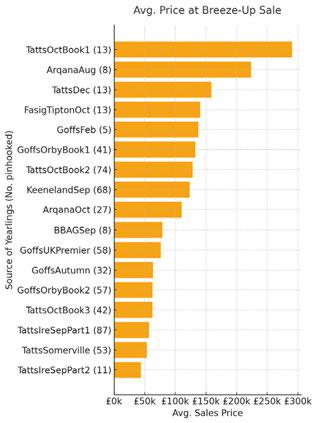
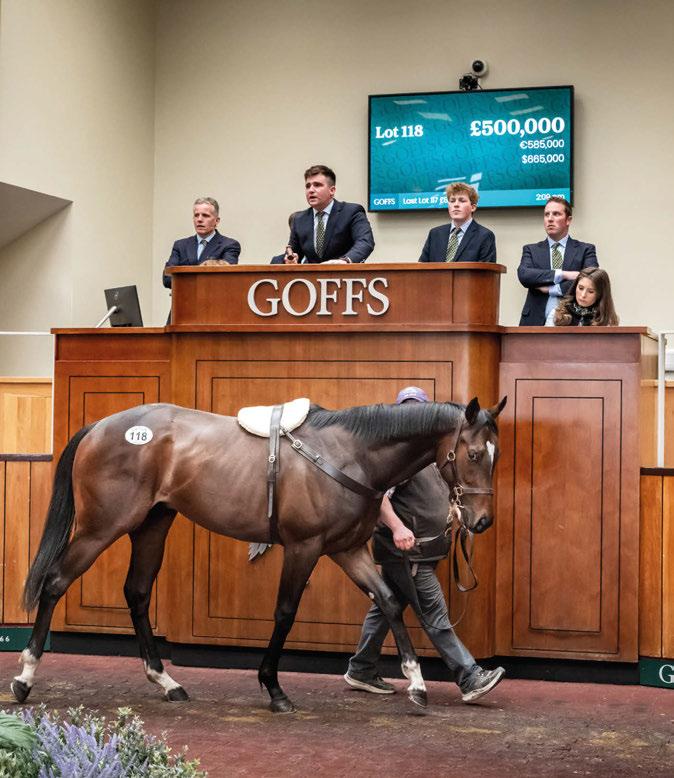
This £500,000 Kodi Bear colt, a €9,000 yearling, was one of the big pinhooking triumphs
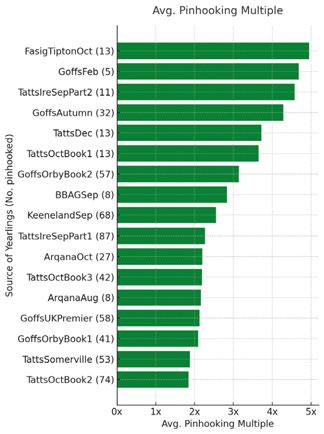
Overall, the 2025 European breeze-up season was strong with positive trends seen across most sales, largely driven by the continued strength at the top of the market, while the mid-to-lower tiers remained more challenging.
The analysis above touches on several data points that I think are relevant, but it represents only a portion of the wider picture. Given the significant number of variables that influence a horse’s performance in the sales ring, and the good levels of data now available, the data set can be tailored to provide more specific insights.
Ultimately, while I firmly believe horsemanship and the ability to judge a horse’s physical remain the most critical factors in achieving sustained profitability in bloodstock, I have strong conviction that data can serve as a valuable tool to support decisionmaking, particularly in areas such as sourcing of stock or which sale to target.
Ronan Breslin is an experienced banking and finance professional, having worked in both Dublin and London. A UCD Bachelor of Commerce graduate and fully qualified Chartered Accountant, he is also a lifelong horseracing enthusiast. He can be contacted through email at ronantbreslin@gmail.com.
A big believer in the power of female families, Ben Sangster’s acquisition of the well-related
Multilingual has paid off in the form of her daughter, last month’s Oaks heroine Minnie Hauk
Words: Martin Stevens
Minnie Hauk, the brave winner of this year’s Oaks, joins a long list of top-class horses bred by Ben Sangster that includes other Classic scorers Dancing Rain and Roderic O’Connor, champion Luxembourg and smart performers Changingoftheguard, Forgotten Voice and Nayef Road.
The man himself deflects any credit for those achievements, though.
“Don’t make me sound like a cocky so-and-so or a know-it-all, because I’m neither,” says Sangster with a chuckle. “It’s all luck. Sometimes it goes your way and sometimes it doesn’t. Everyone needs a little luck in their life.”
Fellow breeders will sympathise with that sentiment. Good fortune is indeed required at every stage of production: from purchasing the right mare to choosing the best stallion for her, to hoping that she becomes pregnant without fuss, to safely foaling her offspring and to keeping all the stock free of injury and infection.
Then it is up to divine providence whether the prized foal has inherited the optimum combination of traits from its parents, and up to the even more capricious commercial market whether it enters training with a handler who will have the skill and patience to get the best out of it.
Sangster has, however, probably marshalled the odds a little more in his favour through his appreciation and understanding of pedigrees.
“Blood will out: always has, always
will,” he says. “That’s what I think, anyhow. It all comes down to pedigree. Some people are lucky enough to make their own families, but it’s a long, drawn-out process.
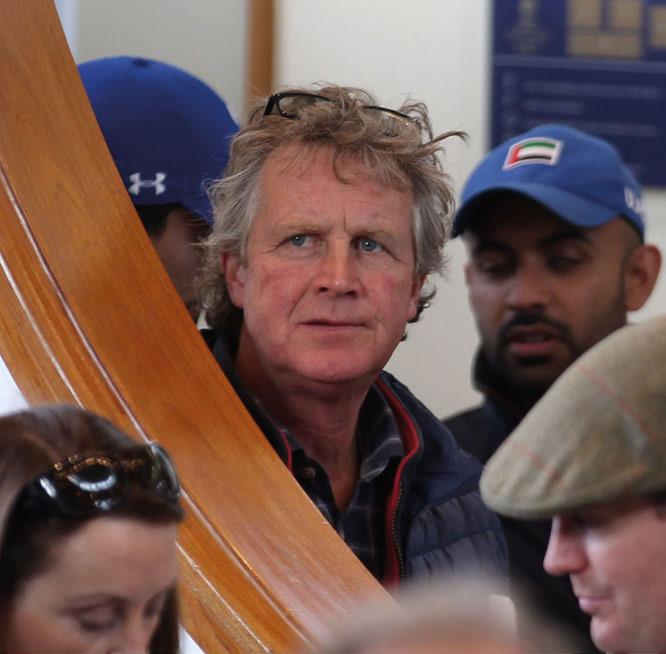
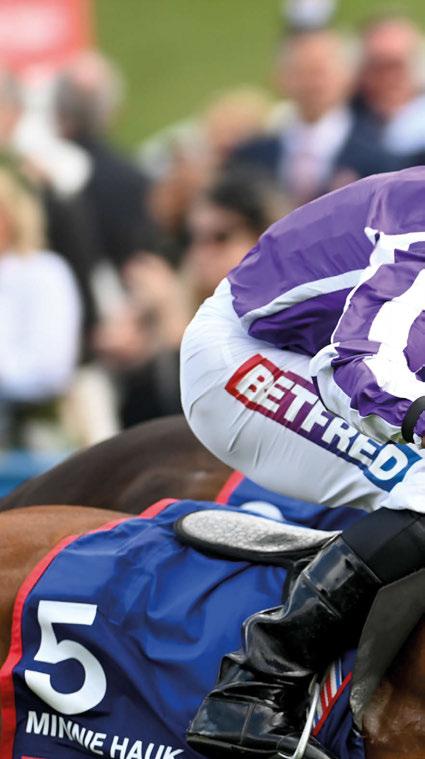
Hauk defeats Whirl to become the latest big-race winner bred by Ben Sangster
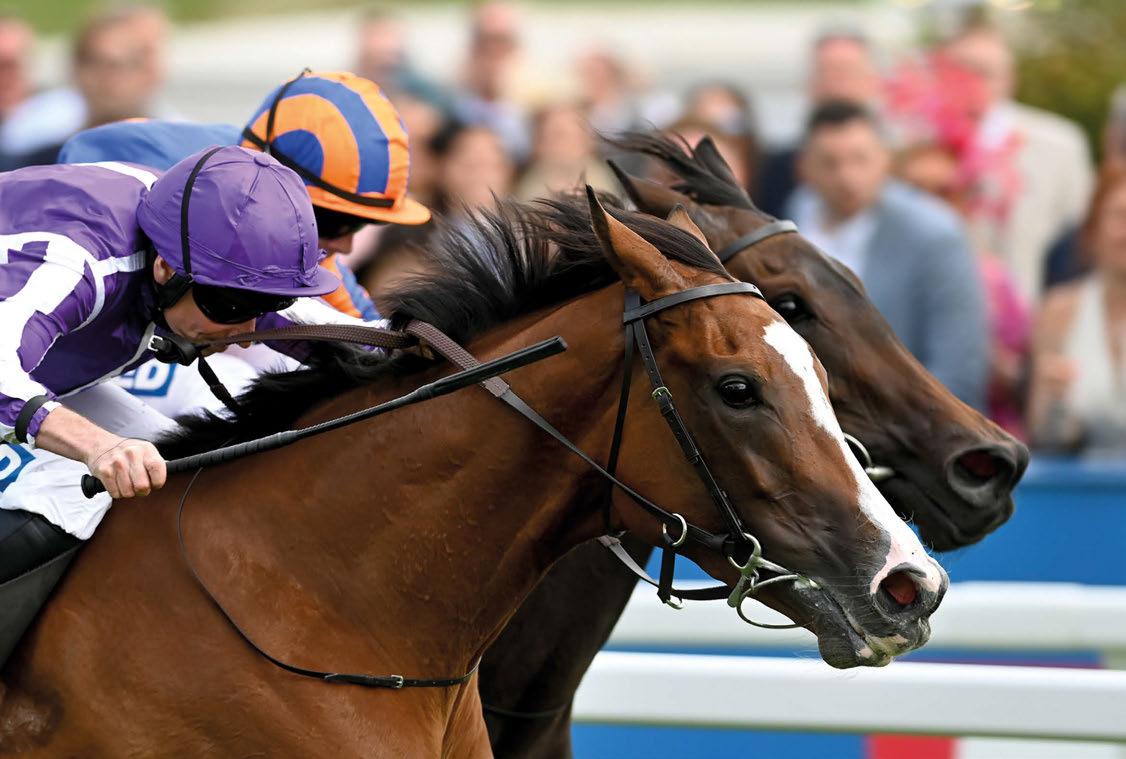
“Otherwise you have to hope to be able to get into some of those outstanding families that have been cultivated for decades by the great breeders like Juddmonte, the Aga Khan, the Wildensteins or John Magnier.
“I love going through those pedigrees. Look at the Irish 2,000 Guineas winner this year [Field Of Gold]. He goes back to the wonderful family of Serena’s Song and Sophisticat. It’s those deep families that seem to be the ones that come back time and time again.”
Minnie Hauk is proof positive of Sangster’s fondness for a big pedigree. The Frankel filly is out of the Dansili mare Multilingual, who didn’t show an awful lot on her sole start for her owner and breeder Juddmonte, but hailed from one of that operation’s finest families, being a half-sister to the exceptional Kingman out of Poule d’Essai des Pouliches heroine Zenda, a Zamindar half-sister to champion twoyear-old and sprinter Oasis Dream.
Moreover, Zenda was out of Hope, a Dancing Brave full-sister to Irish Oaks
victress Wemyss Bight, later the dam of multiple US Grade 1 winner Beat Hollow. Prix du Jockey Club scorer New Bay, whose classy daughter Saffron Beach was co-owned by Sangster, is another member of this dynasty, which must be considered one of the most important of recent times.
Sangster’s son Ollie, now an accomplished trainer based at the family’s part of the Manton estate, paid $525,000 for Multilingual on behalf of his father when she was sold by Juddmonte, through Mill Ridge Sales, at the Keeneland November Breeding Stock Sale of 2019.
“Her page caught the eye because it’s a seriously strong European family,” says Sangster. “It was actually even better than it looked at the time as her two-year-old, Tilsit, was with Charlie Hills but unraced at that point.
“She had that lovely pedigree and she was also a big, tall, scopey, correct model, so we thought we’d have a go and see if we can buy her – and we got her, which was wonderful.
“In the following year Tilsit came
out and won the Thoroughbred Stakes, and in the season after that he was just touched off in the Prix d’Ispahan, so he was a pretty good horse. Charlie did an excellent job with him.”
The Noble Mission filly that was carried by Multilingual in the ring in Kentucky was named Decipher and raced by Sangster and partners with Jane Chapple-Hyam, but failed to reach a winner’s enclosure. She was sent to Starspangledbanner for her first cover last year.
The No Nay Never filly who was the result of Sangster’s own first choice of mating for Multilingual was so attractive that she caused a bit of a stir at Book 1 of the Tattersalls October Yearling Sale of 2022. She was bought by Tina Rau on behalf of Gestüt Schlenderhan for a cool 780,000gns.
“I thought No Nay Never would suit the mare and luckily the result was the most beautiful filly,” says Sangster. “She was bought for good money but wasn’t that great on the track. She ended up winning a maiden in the French provinces earlier this year, and I assume
›› she’s gone to stud now.”
Multilingual’s next offspring was Minnie Hauk, who was sold to Coolmore for the top price of €1.85 million at the Goffs Orby Yearling Sale.
MV Magnier paid tribute to Sangster after he signed the docket for the filly at Kildare Paddocks, saying, “I’m
“We go back a long way and I’m very fond of MV and the Magnier family”
delighted for Ben. We’ve had a long history with the Sangster family and we’ve been very lucky buying from them in the past, most recently with Luxembourg.”
Fortunately for her new owners she has turned out to have a great deal of ability as well as good looks. “The real McCoy,” sums up Sangster.
Reflecting on how Minnie Hauk has continued the rich association between the Sangster family and Coolmore, which goes all the way back to when his father Robert teamed up with John Magnier and Vincent O’Brien to raid the Kentucky yearling sales for the most attractive stallion prospects, fuelling the boom in the Bluegrass in the late
1970s and early 1980s, he adds: “We go back a long way and I’m very fond of MV and the Magnier family.
“We know each other well, and they’re very supportive. They send horses to Manton for Ollie to train, and I have a few mares boarded at Coolmore. It’s a very amicable arrangement.
“I worked there for a short period of time, and I’ve got a lot of friends in the whole organisation. They’re still there because the team is incredibly loyal, it means more than just work to many of the people there.
“Coolmore is a top operation with wonderful farms and staff, and Ballydoyle is arguably as good a situation as there is for training horses anywhere in the world. If you sell a horse and it ends up going there, you know you’ve got a good chance that it will be a good one.”
Multilingual, now 13, is still going strong and has been on her travels in recent years.
“After she foaled Minnie Hauk she went back to No Nay Never on the strength of the earlier filly by him,” says Sangster. “We’ve got the two-year-old filly here with Ollie. She’s been named Voice Coach.
“She wasn’t a physical standout like the first one, but she’s still a nice, strong, good-moving filly who should be capable of winning. We don’t know how far up the ladder she’ll go, as she hasn’t been asked any questions yet.
“Multilingual went back to Frankel after that, and she was nicely in foal,

but sadly lost the pregnancy in the November of her covering year. That would have been a yearling this year, and if it had been a handsome beast it would have been highly desirable to go into training or be sold, but there we are, these things happen.
“The mare was barren after that so we sent her to America and she went to Justify. She has a filly foal who I’ve seen photos of, and the guys on the farm tell me is very, very nice. She went back to Justify on the back of that, and she’s safely in foal, touch wood.
“All being well we’ll bring her back over here. I suppose Frankel would be
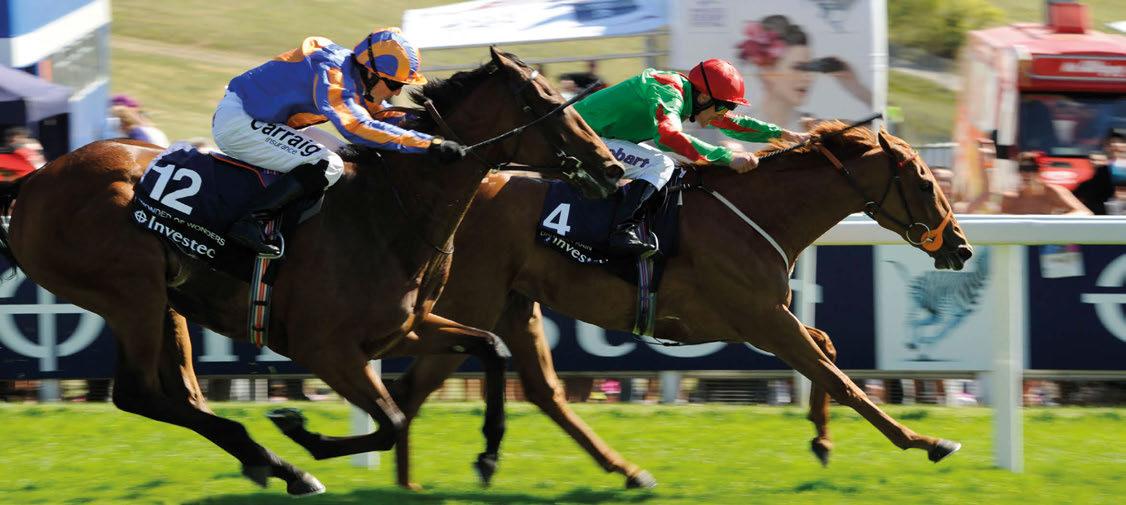
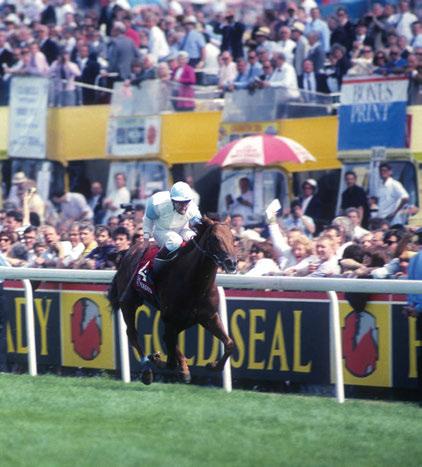
the obvious choice for her if they’re both in good health, as they should be.”
Multilingual is one of around a dozen mares owned by Sangster, who says he has made a concerted effort to keep numbers down and quality up in light of the market seemingly becoming ever more polarised.
Attire, the dam of Luxembourg, is the other star name in the fold. The 16-year-old is by Danehill Dancer and is a full-sister to Group 3 winner Forgotten Voice, out of Asnieres, a winning Spend A Buck half-sister to Breeders’ Cup Classic hero Arcangues and to the dams of brilliant racemares Aquarelliste and Cape Verdi.
She has produced four other winners including Mooresbridge Stakes scorer Leo De Fury (by Australia) and the Group 3-placed pair Hiawatha (by Camelot, so a full-brother to

Luxembourg) and Sense Of Style (by Zoffany).
“Attire is alive and well, thankfully,” says Sangster. “She’s got a Frankel yearling filly and then she missed to Frankel last year, but she’s in foal to City Of Troy now.
“We also have Sense Of Style. She’s a really good-looking mare, and was just short of being a Group-race winner. She was touched off once or twice. Her first offspring, a Camelot filly, was very nice, and sold well at Book 1 last year [made 2,900,000gns]. She was bought by Amo Racing and has gone into training in Newmarket.
“The mare has another Camelot yearling filly this year. She’s exciting. If all goes well, big things could happen with her.”
Returning to his favourite topic of blue-chip breeding, he adds: “I
bought Attire’s dam Asnieres in the late 1990s. It’s wonderful blood, the famous Wildenstein ‘A’ family. The page features lots of champions in England, Ireland, France and the US, where it’s not easy to be a champion.”
Sangster’s broodmare band also features relations to some of his past successes. He owns two unraced halfsisters to Dancing Rain in Rock Orchid (by Fastnet Rock, and already the dam of Curragh Cup third Amusement) and Monsoon Lady (by Zoffany).
“It’s a great family through and through, there are champions going all the way down the page,” says Sangster. “It’s just a question of getting lucky with the right mare who’ll produce the next one. Rock Orchid and Monsoon Lady have been well mated so we’ll have to see if they can do it.”
Dancing Rain was out of Rain Flower, ››
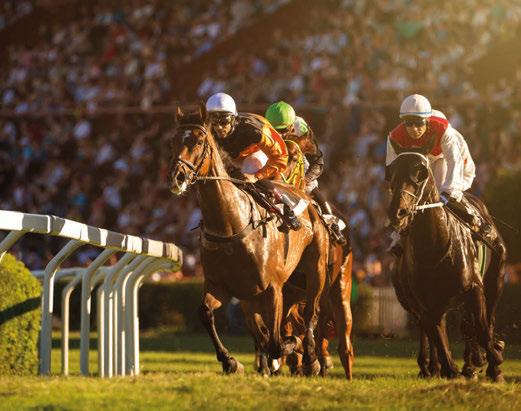
an Indian Ridge three-parts sister to Dr Devious, the Derby hero who was bought as a foal by Sangster and his good friend Paul Shanahan in their salad days.
“Paul reared him and we sold him, but no profit was taken,” recalls Sangster. “He ended up coming to Peter Chapple-Hyam at Manton, of course.
“I was in my late 20s when I got stuck in and got my feet wet. The best
“My father would always preach the virtues of speed on the dam’s side”
way to learn about the business is to invest yourself, and then you find out pretty quickly what’s right and what’s wrong. You never stop learning, though.”
Sangster had accompanied his father and the Coolmore partners on some of their legendary buying trips to Kentucky to pick out the prime yearlings by Northern Dancer and his sire sons, and says the main lesson he learned was an exceedingly basic one.
“I would have been in my late teens when all those enormous prices were being paid,” he continues. “It was heavy stuff, but it was hard to conceive what was going on in the moment, and I was probably too young to comprehend the importance of it, to be honest.
“It was the start of my fascination with pedigrees, though, and being in the company of such a formidable team I did at least realise that the main thing I needed to do was to keep my mouth shut and my ears open.”
Sangster’s admiration for elite breeding resulted in him adding a particularly blueblooded mare to his team recently. He gave, with Norelands Stud, 170,000gns for the then 15-yearold Very Good News, an Empire Maker half-sister to top-level winners Banks Hill, Cacique, Champs Elysees, Heat Haze and Intercontinental and leading sire Dansili, at the Tattersalls December Mares Sale of 2023.
Very Good News had already produced the smart pair Media Stream and Weekender for Juddmonte when
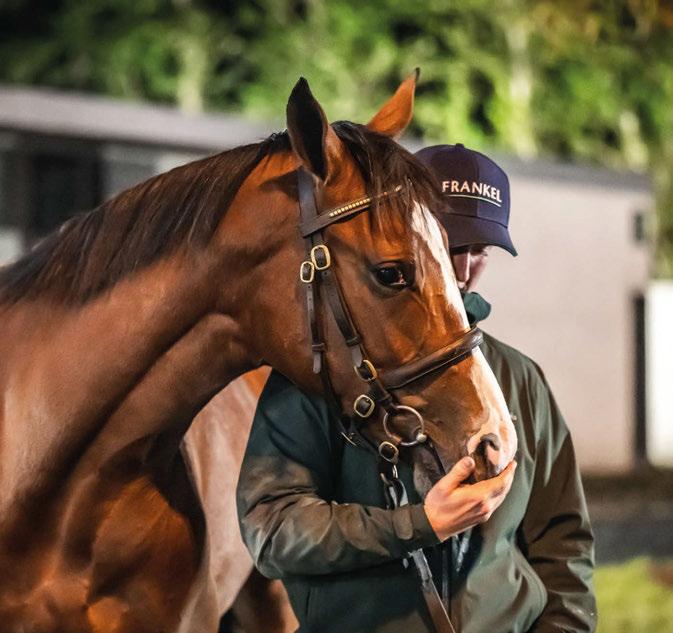
she became the first ever progeny of the operation’s exceptional matriarch Hasili to be offered at auction.
“I bought her with Harry McCalmont, a good pal of mine, and she’s in Ireland,” says Sangster. “We’ve got a New Bay yearling colt and a Teofilo colt foal out of her, but we’re really looking for a filly because, again, that blood is just about the best in the stud book.
“She’s gone to Australia, who’s a highly underrated sire for what he’s achieved and is still doing. But then a lot of people are more interested in speed than those types of horses now.
“When you’re breeding commercially you have to respect what the market wants, but it does seem quite harsh on those classy staying horses sometimes.
“That’s not to say that sprinting isn’t important. My father got all his good luck from fast mares. He loved fillies who had run in the Queen Mary or Cheveley Park Stakes, and then breeding them up to the mile and mileand-a-quarter sires. He would always preach the virtues of speed on the dam’s side. If they had placed in those juvenile speed contests, he loved them.”
Robert Sangster would surely have approved of Lambourn, who completed the Epsom-Irish Derby double for Coolmore last month. He is by Australia
and out of Gossamer Wings, a daughter of Scat Daddy who finished a shorthead second in the Queen Mary Stakes in her racing pomp.
“There you go,” exclaims Ben Sangster. “Coolmore have been incredibly successful breeding along those lines, it’s been a tried and tested formula for years. That’s why they keep pursuing those quick fillies, like Believing [Group 1 winner] now.”
Sangster might not enjoy talking about his own achievements, but he clearly relishes chatting about pedigrees and the mysteries of breeding. He is as much an enthusiast as an entrepreneur when it comes to keeping mares.
“It’s a privilege to have them,” he agrees. “I love sitting down and working out the matings, and then waiting for the foals, hoping it will be a case of black cat, black kitten, and discussing all of it with friends.
“It really is all about luck, though, and that’s what’s made Minnie Hauk so special. I was lucky to be able to buy her dam, lucky to be able to send her dam to Frankel, and lucky to sell her for a nice price and for her to go to a good hotel.
“You’ve got to have luck on your side.”
Saturday 20 th September (Group 2) 6f
NEW £50,000 BONUS: Newbury Racecourse Executive are offering a £50,000 bonus*, for any horse who wins any two-year-old race at Newbury in 2025 (prior to the Mill Reef Stakes) & then goes onto win the Mill Reef Stakes in 2025.
*t&c apply. £40,000 will be paid to the winning owner & £10,000 to the racing staff of the winning trainer.
Entries Close: Tuesday 29th July (International entries close day before)
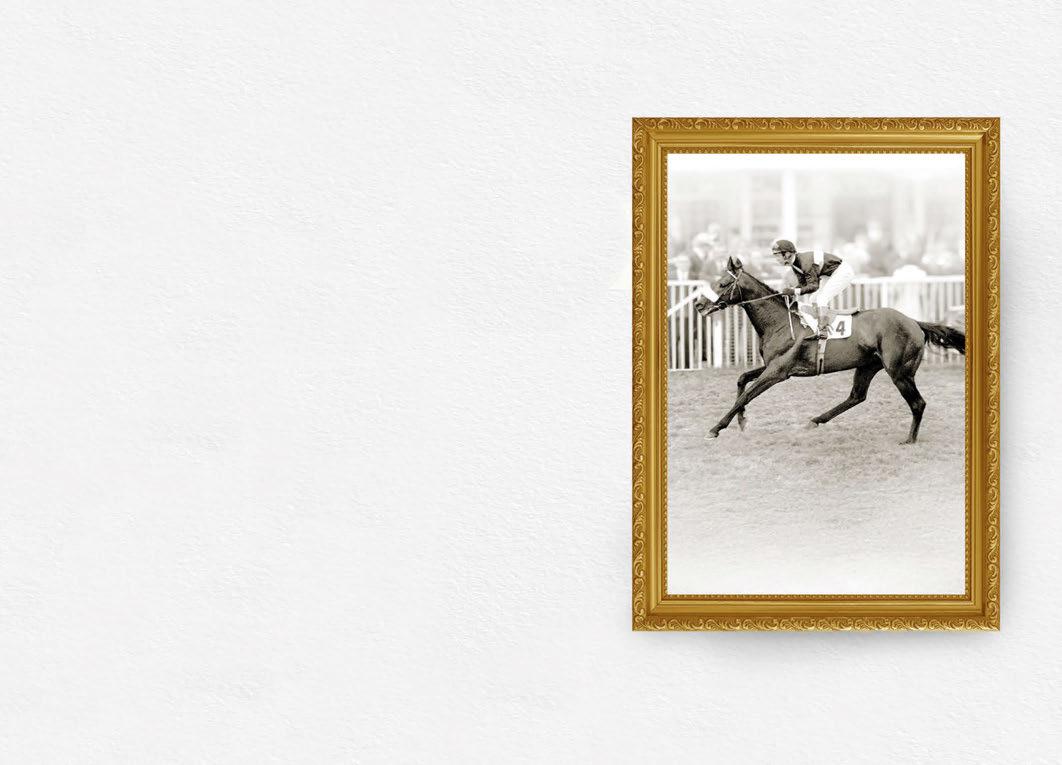


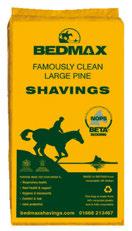
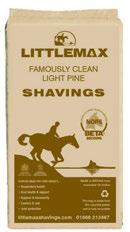



Total print readership exceeds 20,000 per month – Europe’s most widely read monthly horseracing magazine A proven, tried and trusted publication with advertising packages available from just £305 per month
Nancy Sexton Bloodstock Editor
Any owner would be forgiven for believing that deep pockets are needed to play at Royal Ascot given the number of runners who changed hands privately in the weeks leading up to the meeting, culminating in the very public £2 million acquisition of Ghostwriter by Kia Joorabchian’s Amo Racing at the Goffs London Sale. Yet when it came down to it, the meeting happily lent itself again to a melting pot of winners, with independent ownerbreeders, bargain hunters and smaller stallion farms revelling in success alongside the traditional heavyweights.
Docklands immediately set the scene when nosing out Rosallion to secure his Group 1 breakthrough in the first race of the meeting, the Queen Anne Stakes. Whether on account of his £16,000 yearling price tag, when bought by Blandford Bloodstock, the fact he’s by a £3,500 sire in Massaat or is yet another durable product of Richard Kent’s Mickley Stud, Docklands embodies the notion that with a bit of luck and hard work, success can still come the way of anyone regardless of the level at which they operate.
King Charles III Stakes winner American Affair and his connections are cut from a similar cloth. A homebred for John and Wendy McGrandles, he is the first Group 1 winner for Washington DC, a fast, tough horse for the Coolmore partners who struck at the royal meeting in 2015 in the Windsor Castle Stakes and now stands for £3,500 at Bearstone Stud in Shropshire (also the breeders of Palace of Holyroodhouse Handicap winner Adrestia). It was also a popular first Group 1 for trainer Jim Goldie, who most likely took real satisfaction in the fact American Affair is out of a mare by his former talented sprinter Orientor, who held his own at a high level over 79 starts in his eight-year career.
As for Joseph Murphy, he has been a stalwart of the Irish training ranks for the best part of 50 years, his Tipperary yard making the most of the opportunities that come its way. By Murphy’s own admission, it was Cercene’s diminutive stature that allowed him to pick her up from her breeder China Horse Club for €50,000 as a Tattersalls Ireland September yearling. But this relation to
Mohaather and Prize Exhibit wouldn’t be the first from her family to be on the smaller side and the stockman in Murphy obviously saw something in the daughter of Australia; nearly two years on and connections are in possession of a Coronation Stakes winner.
And what about those breeders who took advantage of Australia’s cut in fee this season? By all accounts, the Coolmore stallion has had a busy spring at his new career low of €10,000. That figure was already pretty enticing for a proven Group 1 stallion but it will likely be back on the rise following a June that yielded dual Derby winner Lambourn in addition to Cercene. There is also his burgeoning broodmare sire record
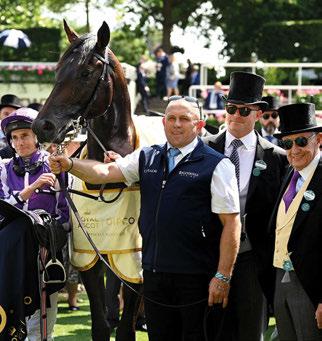
to consider, an aspect that was also showcased at Royal Ascot by the Queen Elizabeth II Jubilee Stakes winner Lazzat.
Commonwealth Cup heroine Time For Sandals, meanwhile, was sourced by her trainer Harry Eustace and DPA Racing, aka David Appleton, for €35,000 on behalf of owners David and Laurie Bevan from her breeder Ballyhane Stud at the same Tattersalls Ireland September Sale as Cercene.
The filly is a major flagbearer for her sire Sands Of Mali, but she isn’t the only member of his first crop to advertise his merits, with last year’s Windsor Castle Stakes winner Ain’t Nobody and recent Ballycorus Stakes heroine Copacabana Sands among those to suggest that he was a steal this season at €5,000 at Ballyhane Stud.

Sands Of Mali has been among the news recently for the wrong reasons as the centre of a High Court dispute. Away from the drama, his background as a son of the obscure Miswaki stallion Panis from an Indian Rocket mare means that he has the potential to become a valuable outcross. Having said that, Time For Sandals is inbred 3x3 to Miswaki; interestingly, one of Panis’ best horses, the fast Group 3 winner Out Of Time, was also closely inbred to the stallion.
Other inexpensive purchases to score at the meeting included Wolferton Stakes winner Haatem, now a Wathnan Racing colour-bearer having once been a 27,000gns yearling, and Windsor Castle Stakes victor Havana Hurricane, a 9,000gns Tattersalls Somerville yearling bred by Lady Cobham who is another showcase for the shrewd eyes of trainer Eve Johnson Houghton and Highflyer Bloodstock’s Anthony Bromley.
And while Coventry Stakes winner Gstaad was one of the highlights of the 2023 Tattersalls December Foal Sale at 450,000gns, he is out of a mare, Mosa Mine, who was bought by his breeder Kelly Thomas for just £800. Gstaad’s valuation was partly reflective of a page dominated by the Group 1 achievements of his half-brother Vandeek and judging by his Coventry win, Gstaad won’t be long in emulating his sibling’s success at the top level. Regardless of the future, he is another feather in the cap for Kelly Thomas and her Maywood Stud.
Nor would it have cost the earth to produce Amiloc. From the fourth crop of Postponed, David and Vimy Aykroyd’s likeable homebred maintained his unbeaten record in the King Edward VII Stakes to continue a remarkable season for the owner-breeders that also covers Dante Stakes winner Pride Of Arras and classy handicapper Old Cock.
There was also homebred success for Fiona Carmichael with her Queen’s Vase winner Carmers. It took a stretch to €1.1 million for the owner to secure his dam Signe as a yearling but in return she gained access to the Green Room family represented to such good effect recently by City Of Troy. Carmichael is relatively new to the breeding side of the game and in the unbeaten Carmers, she couldn’t have made a much better start.
By Carl Evans
Goffs Spring Horses in Training & Point to Point Sale
Held two days after Goffs’ annual store sale, this double-session auction draws together numerous faces from the world of jump racing at the conclusion of the season.
Despite challenges to the sport, a desire to own good horses, to pit your training skills against ambitious rivals and to source runners for the big occasion were underlying themes which resulted in a set of figures that improved upon those achieved the previous year.
A smaller catalogue, whose size was squarely blamed on a recordsetting dry spring and fast going, resulted in 465 lots (103 fewer than in 2024) being offered for sale. Yet despite that reduction, and some caution among buyers in the section dedicated to point-to-pointers, there was a mere one per cent dip in turnover to £8,860,500, the average price gained 12 per cent at £26,371 and the median was up 30 per cent at £16,250. An eight-point rise in the clearance rate to 89 per cent was another cheerful outcome.
Nourishing tales of small or relatively small operations gaining handsome payouts are not uncommon in jump racing, and that is invariably the case at this annual gathering in Doncaster, where on this occasion top-lot honours were taken by the £300,000 four-year-old filly Poetisa from the Lambourn yard of Toby and Nicola Bulgin. They bought the daughter of Poet’s Word for £42,000 at Goffs’ store sale at Doncaster 12 months earlier, trained her to win a bumper at Cheltenham’s April
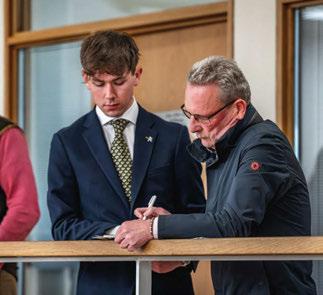
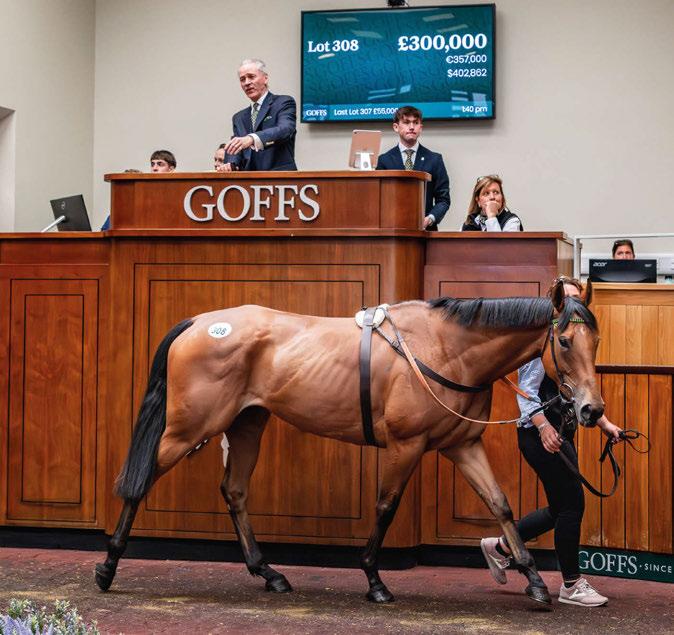
meeting, then returned her to the South Yorkshire venue where Willie Mullins’s ringside ally Harold Kirk was poised to purchase and duly fended off Nicky Henderson.
Poetisa, a half-sister to a Grade 2 novices’ hurdle winner, was foaled by a half-sister to top-class hurdler Macs Joy, so she had pedigree and a good performance to her name, qualities
which Mullins is well-equipped to expand upon.
Ambitious young trainers and the children of established trainers who take a position alongside their parents as joint licence holders, are adding vibrancy to racing on the track and in the ring. It is a role which Mullins will surely share with son Patrick before too long. At this sale it resulted in
• Low Kick’s sale for £170,000 was proof that a horse need not win impressively to sell well at a subsequent sale.
He also became another fine advertisement for young horses from Britain’s point-to-point circuit.
Four-year-old Low Kick had finished third on debut in a point-to-point, when trainer Jack Teal said the undulating course had found the gelding out, and second in a bumper – Teal, who rode the horse, blamed himself for challenging too late. However, he has the swaggering walk and size to suggest he will be winning before long.
Just a few years ago many involved in British pointing lamented that a horse who had won six point-to-points as a seven-year-old, and who would surely win handicap hurdles or chases, proved to be worth little money when sent to the sales, while a once- or twice-raced Irish four-year-old could make a jackpot. Those voices are rarely heard now
ambitious buying by Warwickshire’s Olly Murphy and Gloucestershirebased Willie Twiston-Davies, who has joined his father, Nigel, on the licence.
Murphy, who had bought the £120,000 Doctor Dino filly top lot at the preceding stores’ sale, added several horses to his string, notably when buying five-year-old gelding Kingston Pride out of Henderson’s stable. Henderson was keen to retain Kingston Pride for another owner, but Murphy’s bid of £285,000 closed out his rival.
He revealed he was acting for his yard’s sponsors, Diana and Grahame Whateley, and added that a novice chasing future was the logical next step for the grey. Calling trade “remarkably strong”, Murphy added: “I can say that from selling a draft of horses myself – there is a lot of competition and demand for horses in training.” Such a comment will have pleased the vendors of horses who trade earlier in the chain.
Willy Twiston-Davies has added a youthful element to the superb training achievements of his father, and he appears nothing if not determined to maintain the stable’s position among leading yards of jumpers. With agent Ian Ferguson’s guidance the father-and-son team unleashed successful bids to the value of £470,000 for a trio of four-year-old
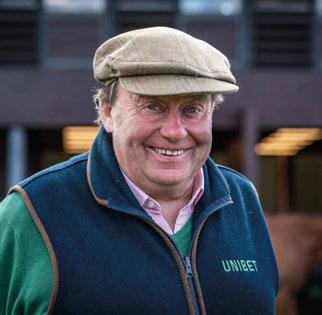

Irish point-to-pointers, parting with £160,000 for Leader Crik from Matty Flynn O’Connor’s stable, and £155,000 for both Shotgun Rider and Big Ticket, who were sold by Colin Bowe and Johnny Fogarty respectively.
From a commercial point of view, British point-to-pointing is dwarfed by the Irish model, but green shoots have emerged in recent years and their roots are becoming established. Licensed trainers have cottoned on and most no longer dismiss British pointers out of hand.
From a section of the catalogue dedicated to the best point-topointers – and dominated numerically by Irish pointers – the top price was gained by Low Kick from the Yorkshire stable of Jack Teal. A loose-moving grey, he scored on looks and promise rather than a stellar performance having finished third in a maiden point-to-point and then runner-up in a
point-to-point bumper at Aintree. Teal blamed himself for each defeat, and the market was prepared to listen and forgive, for agents Aiden Murphy and Tom Malone each had a good go at securing the four-year-old only to be trumped by a £170,000 bid from Mags O’Toole, who was presumably buying for a client of Gordon Elliott. The result was a triumph for Teal’s fellow Yorkshireman Roger Marley, who had bought the son of Montmartre for €28,000 as a yearling, failed to sell him as a store, but hit the target via the point-topoint route.
Statistics
Sold: 336 (89% clearance)
Aggregate: £8,860,500 (-1%) Average: £26,371 (+12%) Median: £16,250 (+30%)
During a season of breeze-up sales that have resulted in improved figures, Tattersalls Ireland must have been hopeful of breaking €10m turnover at this one-day auction.
In fact, the company slam-dunked that figure when racing to a new high of €11,658,300, up 21 per cent, and there were healthy improvements in the average and median figures, too. With 31 lots making a six-figure sum, the average was dragged up to just under €55,000, while strength through the middle market saw a 14 per cent gain in the median to a mark of €32,000. They were record figures, achieved despite a two points fall in the clearance rate. Despite that small reverse the occasion was all very pleasing for Tattersalls Ireland, which put its name to the auction as recently as 2019 following a deal with founders Goresbridge Bloodstock Sales.
As at preceding breeze-up sales this year the best horses with looks, pedigree and fast times made big
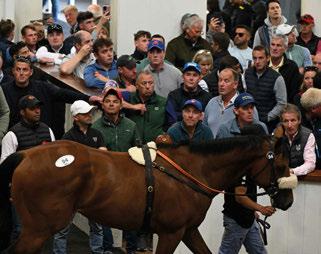
A busy ring watches on as C.A.J. Stables’ Starspangledbanner colt makes €475,000
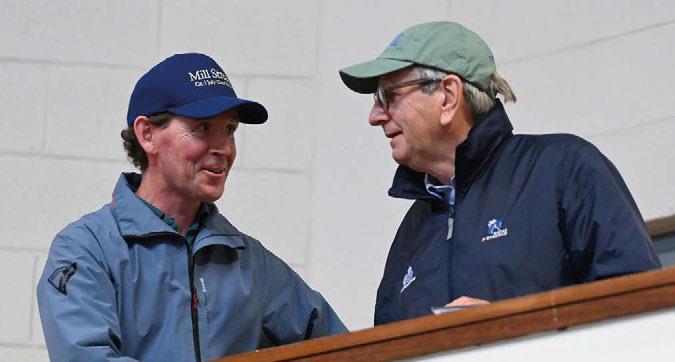
money, and it was not a surprise that the record price for a breezer sold in Ireland was beaten. That honour, formerly held by a €520,000 Saxon Warrior filly, now rests with a €580,000 Night Of Thunder colt from the O’Callaghan family’s Yeomanstown Stud. Anthony Stroud, who had bought a number of top-end breezers
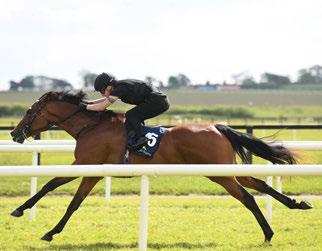
Kilminfoyle House Stud’s Street Sense filly turned a good profit at €340,000
• On the subject of remarkable pinhooks, how about the filly bought for €1,200 at Goffs in November and who was resold six months later at the Tattersalls Ireland Breeze-Up Sale for €165,000.
Thoroughbred yearlings sold that cheaply usually have a flaw or two, but given that this daughter of Cotai Glory was bought by Brown Island Stables’ canny Johnny Collins it should have been no great surprise that she breezed like a good ’un.
Collins modestly muttered that he had been in the right place at the right time to buy her at the yearling stage, yet she wasn’t a first or final lot into the ring on a day of storms which prevented rival buyers attending. In fact she was the 18th horse to be offered on day two of the Goffs Autumn Sale as trade was getting into full swing.
Plenty of other horses at that yearling sale made similar sums and may never reach the racecourse or trouble the judge if they do, but Collins has a natural talent for spotting a horse that, while cheap, is likely to out-run its auction price.
Anthony Stroud will be hoping so, for it was his bid that bought the filly on behalf of Bahrain’s Sheikh Duaij Al Khalifa.
for Sheikh Mohammed at earlier sales, brought the hammer down once again, but on this occasion he was acting for Bahrain’s KHK Racing, which is headed by Sheikh Khalid bin Hamad Al Khalifa.
The colt’s sale generated a handsome profit for the O’Callaghans, although they had invested 100,000gns to buy him at yearling stage, an illustration that this is rarely a game for novices.
However, it is not essential to spend a six-figure sum on a foal or yearling which it is hoped can be sold at a profit later, as witnessed on a number of occasions at this auction. The next horse on the top-ten list, a €475,000 son of Starspangledbanner, had been bought for a more affordable 37,000gns at the Tattersalls December Yearling Sale. Consigned by Cristiano Martins’ C.A.J. Stables, he too was sold to Stroud on behalf of KHK Racing, while another freespending agent, Richard Brown of Blandford Bloodstock, added €340,000 to the pot when buying a Street Sense filly offered by Michael Fitzpatrick’s Kilminfoyle House Stud.
Fitzpatrick, who paid $40,000 for her as a yearling, said he had opted to sell her late in the breeze-up sale season as she was a scopey type who benefited from the additional time, and Brown, who was acting for Wathnan Racing, said he recognised she was one for late summer.
Another horse who will not be rushed was a son of Wootton Bassett, consigned by Katie McGivern under her Derryconnor Stud brand, and sold for €320,000, a sweet rise in his €70,000 valuation when traded as a yearling at the Goffs Orby Sale. Richard Hughes will train this one for
Sean Mulryan.
Simon Kerins, Tattersalls Ireland’s CEO, was understandably delighted with the sale’s outcome and the way in which it has developed appeal to international buyers, an absolute must for any current auction revolving
C Night Of Thunder - Mambo Light
C Starspangledbanner – Guavia
around Flat-bred horses. Kerins said his company’s collaboration with Irish Thoroughbred Marketing had played a key role in giving the event global appeal, adding: “It is hugely rewarding to see horses now heading to all corners of the world.”
Stables
F Street Sense - Conquest Sweetride Kilminfoyle House Stud
C Wootton Bassett - Thai Haku Derryconnor Stud
C No Nay Never – Single
Tattersalls Ireland
May PtP & HIT Sale
This sale was given a complete overhaul for its latest edition.
Created in 2018 as a sale of unbroken jumping stores, it had a slight revamp last year when introducing a 25-strong group of point-to-pointers and in-training horses. The two sections combined added €3m to Tattersalls Ireland’s annual turnover. Roll forward another year and the store section, which had turned over nearly €2.2m on its own last year, was dropped – apparently due to advice from vendors – and the point-to-point and in-training section beefed up to create a catalogue of 109 lots.
Of those, 65 found a buyer at a clearance rate of 73 per cent, generating turnover of €2,423,500, an average price of just over €37,000
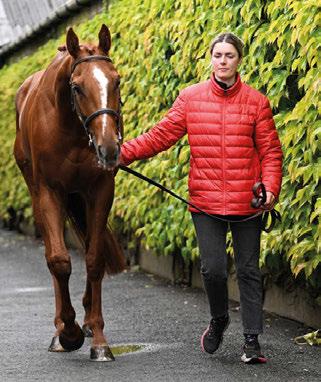
Statistics
Sold: 212 (88% clearance)
Aggregate: €11,658,300 (+21%)
Average: €54,992 (+26%)
Median: €32,000 (+14%)
Stroud Coleman BS
Blandford Bloodstock
Grandeville Racing
Bloodstock
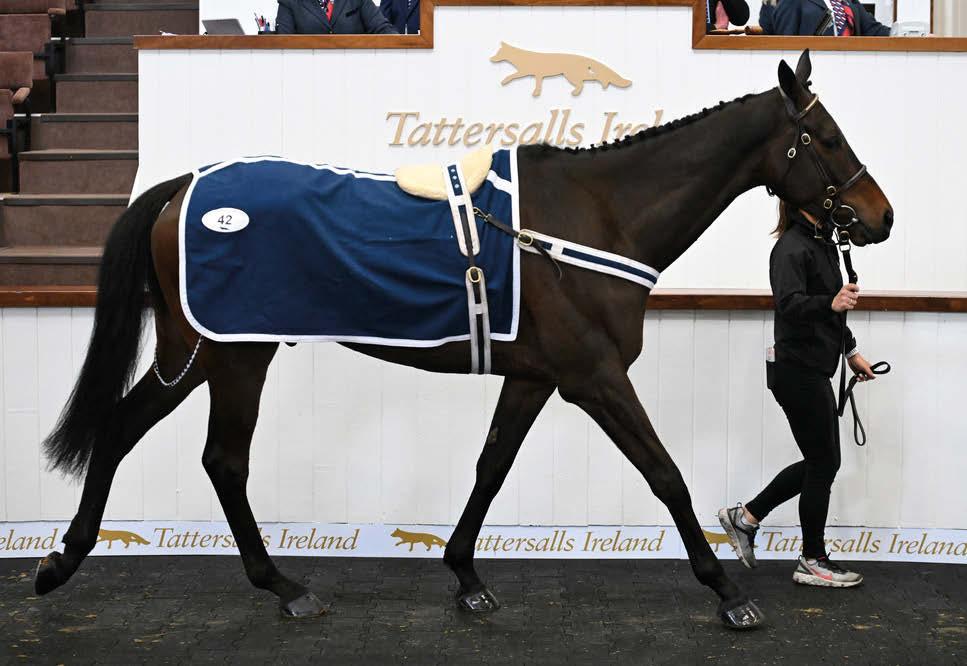
and a median of €30,000.
A ‘middle-of-the road auction’ might be a fair description, but the sales company was happy enough with the figures, and in a wetter spring with easier ground it might attract a stronger catalogue. Plenty of talented, but unraced four- and five-year-old pointers will have been held back for later in the year due to the prevailing fast ground in April and May.
Tattersalls Ireland made no reference to rival companies, but by switching from stores to pointers and horses in training, any aspirations Goresbridge might have had to add to its April Sale by putting on another in May or June will have been checked. Two four-year-old point-to-pointers sold for €150,000 to head trade.
Stables’ Cormac Doyle gained that sum for his easy Ballindenisk winner Jewel Hope, a son of Derby winner and new dualpurpose sire Masar and from the immediate family of Ascot Gold Cup winner Subjectivist and the talented Sir Ron Priestley. Hamish Macauley bought this one.
Harold Kirk and Willie Mullins claimed the joint-topper, Bentraghhill, sold by owner Wilson Dennison having finished third on debut for trainer Cormac Abernethy. A very tall horse, he had done well to run so promisingly for one of his age; Kirk said his purchase would be given plenty of time.
Bloodstock agent Tom Malone revealed in a recent Racing Post ››

sold to Highflyer Bloodstock/Jet Bloodstock, a new venture involving Anthony Bromley and racehorse owners Simon Munir and Isaac Souede, two men who have decided to turn their knowledge of trading stocks and shares into equine commodities.
Bromley has been tasked by Munir and Souede to acquire stores who will be placed with Irish point-to-point handlers and then resold. They will race in double blue colours, rather than the double green carried by their owners’ runners under Rules.
Top lots
Age/sex/breeding
2 c Walk In The Park - Sparky May Glenwood Stud
3 g Nathaniel - Tinagoodnight Oaks Farm Stables
3 g Crystal Ocean - Whistle Dixie Ballintogher Stud
3 g No Risk At All - Garmerita Sluggara Farm
3 g It’s Gino - Faaa Le Dun Church Farm Stables
This quirky and unique event is part panto, wholly party, generously hosted and great fun – it is also a serious opportunity to buy or sell a horse, although that seems less important than at other bloodstock auctions.
It could even be designated an online sale, for while it has invariably been graced in person by a mare, foal or filly out of training, the bulk of the small, select catalogue involves horses in training who are all tucked up at home. Others will be ensconced in Ascot’s stables ahead of day one of the Royal meeting. That five-day fiesta of racing is the sun around which this event revolves. You want a runner at the meeting? This provides that opportunity.
All credit to the team at Goffs – of which Nick Nugent was a key player – who came up with the idea, for while it has often felt like a fantasy, it has now been staged for ten years and keeps pulling in vendors, buyers and the all-important ‘partners’ who
Statistics Part 1 – 3yos
Sold: 349 (84% clearance)
Aggregate: €18,752,000 (+13%)
Average: €53,731 (+11%)
Median: €45,000 (+7%)
Statistics – 2yos
Sold: 16 (70%)
Aggregate: €838,500
Average: €52,407
Median: €39,000
Statistics – Part 2
Sold: 176 (77% clearance)
Aggregate: €3,192,500 (+42%) Average: €18,140 (+20%)
€16,000 (+14%)
Gerry Aherne
Tom Malone/Owen Daley
200,000 Gordon Elliott
190,000 Coolmeen Farms
175,000 Harold Kirk/Willie Mullins

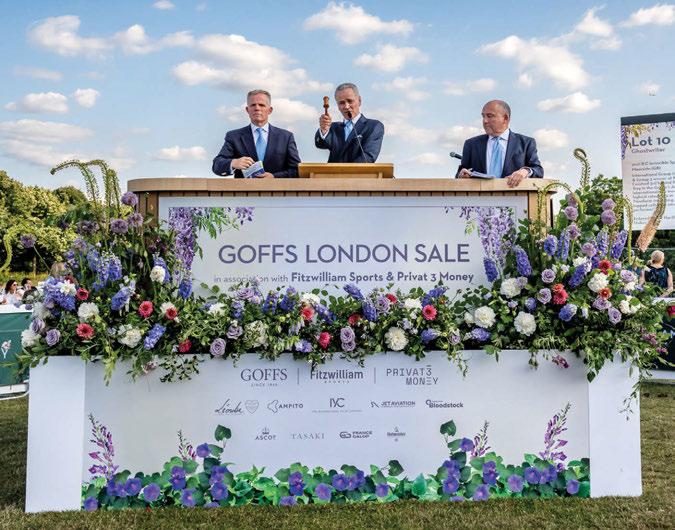
help fund the event.
And why regret the lack of horses to look at in the flesh when the people-watching opportunities are multitudinous? It is the hors d’oeuvres for Royal Ascot with a cross-section of the same crowd in a relaxed and colourful setting.
A £2m top lot is evidence of the serious side, and on this occasion was the valuation placed on four-year-old Ghostwriter, a Group 2 winner and Group 1 performer who has been a grand ally to owner Jeff Smith and trainer Clive Cox. A 100,000gns foal purchase by Smith, the son of Invincible Spirit has earned six times that sum on the track, a highlight being his third of 13 placing behind City Of Troy in last year’s Juddmonte International.
Kia Joorabchian – who else? – liked the colt’s profile and it was his bid which proved decisive. He admitted to not having met Cox, but said Ghostwriter would stay with the
trainer at least until after tackling the Hardwicke Stakes at Royal Ascot. He went on to run a fine race in third.
Joorabchian’s Amo Racing also acquired three-year-old colt Tycoon out of John and Thady Gosden’s yard for £600,000, but another apparent £2m ‘sale’ involving the Yann Barberot-trained Rafale Design, who had won the previous day’s Prix du Lys at Chantilly, proved to be a vendor buy-back.
When very rich racehorse owners – as opposed to very rich professional traders – put a horse on the market, especially those with a Royal Ascot entry, they need to feel very flattered about the price they are being offered. Otherwise they simply retain and race their precious beast. As a result some transactions involve an element of smoke and mirrors – not that there’s anything wrong in opting not to sell a horse – but that was not the case with Woodshauna, a son of Wooded consigned from Francis
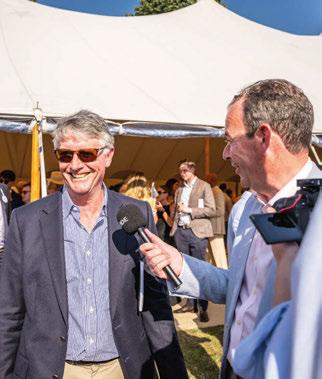
Graffard’s stable having won the previous day’s Prix Texanita at Chantilly.
Graffard was so keen to keep the horse he rang one of his owners, wealthy Kentuckian John Stewart, and urged him to buy Woodshauna. With a bid of £625,000 Stewart did just that, adding the three-year-old to his Graffard string which includes top-class Goliath, the winner of last year’s King George VI and Queen Elizabeth Stakes and set to head for that Ascot race again.
Of 28 offered lots, 19 were listed as being sold, creating turnover of £7.7m, down eight per cent, although last year’s figure was boosted by the £5m sale of Prix de Diane heroine Sparkling Plenty. The absence of a horse of her value also pulled the average price down to a mark of £406,000, a drop of 27 per cent, but the median gained 50 per cent at £300,000.
Statistics
Sold: 19 (68% clearance)
Aggregate: £7,700,000 (-8%)
Average: £406,316 (-27%) Median: £300,000 (+50%)
By 2021 Galileo’s illustrious career was starting to come to an end. The old horse was still getting a handful of mares in foal that would ultimately result in a final crop of 12 three-year-olds. But those using him also had to be alert to the other options available.
One of those mares slated to visit him that season was Gossamer Wings, a young member of Coolmore’s powerful broodmare band. She was exactly the type of mare who promised to suit Galileo well; a daughter of Scat Daddy, she was a typically fast and precocious representative of that stallion who had defied her mid-May foaling date by falling just a nose short in the 2018 Queen Mary Stakes at Royal Ascot. Coolmore, in particular, had long been well attuned to Galileo’s affinity with faster mares, an area in which he had the upper hand over his sire Sadler’s Wells. Gossamer Wings, therefore, was a naturally appealing candidate to take a slot in what turned out to be Galileo’s final book.
However, it was that thinking, along with the advice of Aidan O’Brien, that prompted the Coolmore team to turn to his Derby-winning son Australia when it became clear that an alternative might be needed. The result was Lambourn, last month’s front-running winner of the Derby who followed up in the Irish Derby.
“Galileo was on the decline at the time and we were looking for alternatives for Gossamer Wings,” recalls Mark Byrne of Coolmore. “They were Wootton Bassett, Frankel, Kingman and then Australia, and credit must go to Aidan O’Brien and [Coolmore Director of Sales] David O’Loughlin for suggesting Australia.
“Aidan’s a believer in the horse, especially when it comes to sending him those faster types of mares. He’s had a lot of success with Australia, be it training Group 1 horses by him or breeding the likes of Port Fairy. And credit to David as well. Those faster Queen Mary types of mares that Mr Magnier loves worked so well with Galileo, and Australia is very much in his mould. It made sense and Mr Magnier and MV [Magnier] were then very quick to row in behind that and use the horse.”
O’Brien has never hidden his regard for Australia. The 14-year-old has just completed his 11th season at Coolmore and so breeders know full well now where they stand with him, aware that while he is a

proven Group 1 sire, much of his influence lies over middle distances, which of course doesn’t always sit well within the constrictions of commercial breeding. That profile probably played its part in the horse attracting just 60 mares at €17,500 in 2024. Coolmore cut his fee to €10,000 for this season and by all accounts Australia has had a much busier spring. And deservedly so given June featured not only Lambourn but also Coronation Stakes heroine Cercene. Another three-year-old, Kiamba, won a Listed race in France.
When it comes to passing down soundness and steady temperament, Australia appears to have few peers. That much was neatly summed up by O’Brien’s daughter Ana in a feature on the family’s Whisperview Trading with Owner Breeder last summer. At the time, Port Fairy had just captured the Ribblesdale to join a list of accomplished Whisperview-bred progeny of Australia headed by the Breeders’ Cup Mile winner Order Of Australia. The O’Brien family also bred Wemightakedlongway, who ran fourth in last month’s Oaks for Joseph O’Brien.
“We’ve always really liked his progeny and we have some really gorgeous yearlings by him again this year,” she said. “I think he’s a stallion who is underrated. They also have great temperaments. From the minute they’re born, they’re very easy to have anything to do with. You’d nearly
know going into a field which is an Australia by its temperament. I remember in training that he was a gentleman of a horse, you couldn’t fault him and he was so straightforward.”
Those qualities have seemingly come to the fore in Lambourn. Uncomplicated like his sire, his win continued a Derby-winning sequence for the sire line after Galileo (2001) and Australia (2014), thereby emulating the Galileo - New ApproachMasar streak completed in 2018 and that of Mill Reef - Shirley Heights - Slip Anchor completed in 1985.
Ironically, Australia’s Classic milestone comes in the year that his fee sits at that €10,000 career low. There are a number of proven sires languishing within the under £15,000 bracket, but not one boasts the record compiled by Australia. Lambourn is one of seven Group/Grade 1 winners by the stallion and the second to win a British Classic after Galileo Chrome, successful in the 2020 St Leger. However, his Derby win broke a Group/Grade 1 drought for the sire that stretched back to Ocean Road’s win in the Gamely Stakes at Santa Anita in May 2022 (although Adelaide Road did come close to upsetting Auguste Rodin in the 2023 Irish Derby).
Much of the top-end quality is also weighted towards Australia’s first few crops. He was a leading light of the 2015 intake of new stallions, a multiple Group 1
Words: Laura Steley
Equine Gastric Ulcer Syndrome (EGUS) became a recognised term in the 1990s and is arguably one of the most widespread health challenges in thoroughbred racehorses and performance horses worldwide. Recent studies suggest that the prevalence of EGUS in thoroughbreds in training can be as high as 90%, between 25% and 50% in weanlings and yearlings, and up to 60% in broodmares and stallions. The condition poses a serious threat to both equine welfare and performance, on or off the racecourse.
Liz Bulbrook, Director of Nutrition at Baileys Horse Feeds, says: “In thoroughbred racehorses under intense training, over 90% show gastric ulceration, with severity peaking during the early training phases. Without effective intervention, ulcers can rapidly worsen, impacting performance and welfare.”
Although much research has been carried out and excellent progress made, the syndrome is still not fully understood. Understanding the latest research on EGUS and applying this to practical management approaches is essential for anyone involved in the care of thoroughbreds.
The two types of EGUS EGUS is the umbrella term for the two different categories of ulcers that horses can develop in either the glandular or non-glandular regions of the stomach. The differential between the two became apparent in 2015. The discovery of glandular ulcers largely came about due to the increase in length of the gastroscopes. Originally, veterinarians were using humanbased endoscopes of around 2.5m in length to diagnose EGUS. This provided a clear view of only the top half of the stomach (an average horse is 2m in length from nostril to stomach entrance).
As interest and prevalence grew, equine specific endoscopes became available with an increased length of 3.5m, thus allowing veterinarians a clear view of the glandular part of the stomach. It is important to mention that there is no definitive link between the two diseases – just because the upper part of the stomach looks healthy, it doesn’t mean the lower part will be too.
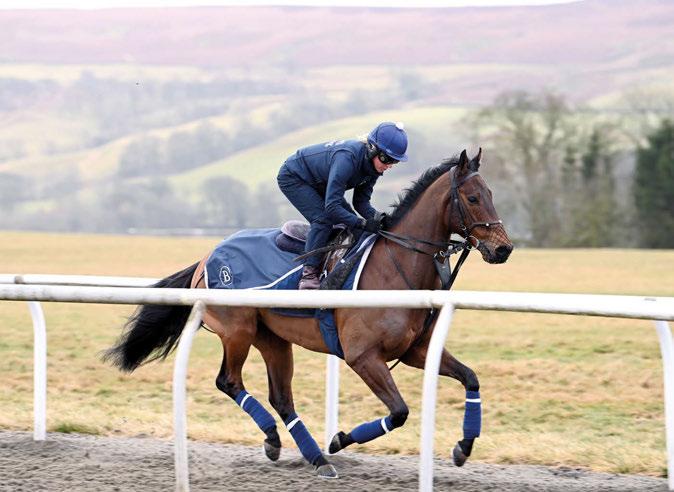
Racehorses are particularly affected by gastric splashing due to high-intensity exercise
Equine Squamous Gastric Disease (ESGD) is ulceration of the non-glandular squamous mucosa lining of the upper stomach. This can be further classified into primary or secondary dependent on the cause of the disease. Primary ESGD is the most common and occurs in an otherwise healthy gastrointestinal tract. Secondary ESGD is due to delayed gastric outflow (emptying of the stomach) due to other pre-existing conditions, e.g. inflammatory bowel disease. This area is particularly vulnerable because it lacks the protective mucus and bicarbonate secretions present in glandular regions.
Equine Glandular Gastric Disease (EGGD) affects the glandular mucosa, which normally secretes acid alongside protective mucus and bicarbonate. Unlike ESGD, EGGD is less about acid damage and more about impaired mucosal defence mechanisms, inflammation, and possibly changes in the stomach’s microbial environment. As recent presentations by Dr Pat Harris and Nanna Luthersson DVM at the 2023 European Workshop in Equine Nutrition emphasised that impaired mucosal protection in EGGD results in inflammation, decreased mucus and bicarbonate production, and reduced blood flow, compromising the stomach’s ability to heal and resist injury.
ESGD
ESGD in thoroughbreds is largely a consequence of either their demanding training regimes, unnatural feeding routines, or both. Day-to-day management is a key determining factor in avoiding the onset of ESGD. The most important and obvious part of any horse’s management should be ensuring adequate access to forage. Bulbrook advises: “Ensure plenty of forage is available; pasture turnout is beneficial but often not possible for horses in training, therefore plenty of quality hay should be on offer – 1.5% of bodyweight per day where possible. The horse has a physiological and psychological need to chew, as chewing creates saliva which acts as a natural buffer to the acids in the stomach.”
A horse’s stomach will continuously secrete approximately 1.5 litres of gastric acid per hour, regardless of whether they are eating. When the stomach is empty, which can be common during intensive exercise or between large, infrequent meals, acid accumulates and splashes onto the sensitive squamous mucosa. Although it is common knowledge that you would not want to provide any horse with a large hard feed directly before exercise, it is now known that exercising them on an empty
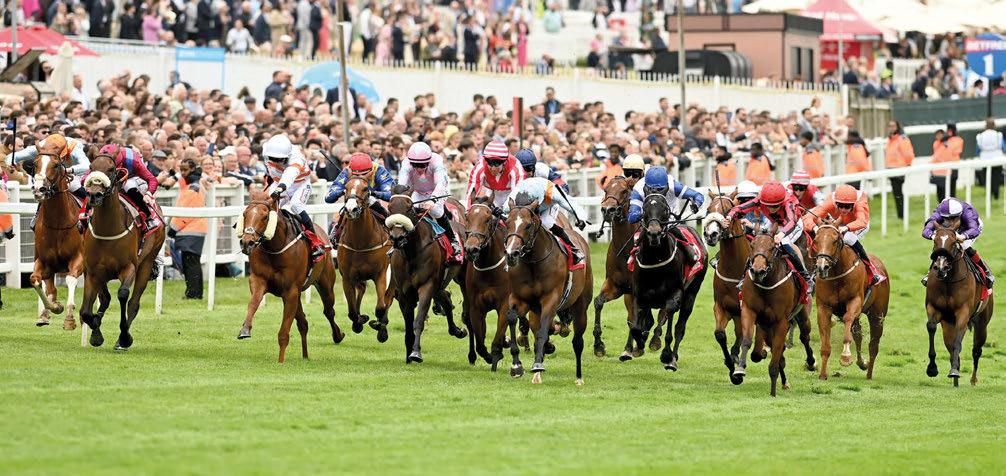
Epsom’s lightning-quick fivefurlong track is just about the last place you’d want to give away ground and challenge from the back of the field. As such, it wasn’t looking promising for Stormy Impact in the 3YO Dash on Derby Saturday – Simon Holt noted in commentary that the filly had “lots to do” – with all except one of her 15 rivals in front of her with two furlongs to run.
Yet under star apprentice Warren Fentiman, Stormy Impact powered down the outside as the leaders began to tire, edging ahead near the finish to take the valuable prize by a length, to the delight of owner Steve Bradley.
He says: “Two furlongs out it looked embarrassing, I thought she’d be tailed off! Then Warren conjured a run down the outside – the finishing speed she showed was unbelievable.
“The race was run to suit because they went too fast and feel in a heap.
“John Williams, the former jockey who is a close friend, urged me not to run her at Epsom, but I decided I would – and I’m glad I did!”
He continues: “Warren’s a very talented rider. I think he’s got a good chance of being champion apprentice this season.
“He rode one for me last year, I
think it was his third or fourth ride, and fell off coming out of the stalls! But he’s excellent and I have a lot of faith in him.”
Bradley is no stranger to success on the big stage, having seen his red and black silks carried to victory at Royal Ascot by Stormy Impact’s half-brother The Ridler – the siblings are homebreds under the Smarden Thoroughbreds banner – in the 2022 Norfolk Stakes.
On that occasion, The Ridler had to survive a stewards’ enquiry after Paul Hanagan’s mount hung badly left inside the final furlong, hampering the placed horses. Kia Joorabchian, owner of the second and third, then lodged an appeal that was spun out until the end of that August when it was dismissed by an independent panel.
“I watched The Ridler’s Norfolk win on the big screen in the paddock with my son and daughter,” Bradley relates. “The victory wasn’t tainted by the enquiry, but it dragged on and took six weeks to get a decision. This was during Covid, everything was carried out remotely, and they threw the kitchen sink at it!
“It was an absolutely brilliant day – that win was on a different planet. It’s a bonus to win any race at Royal
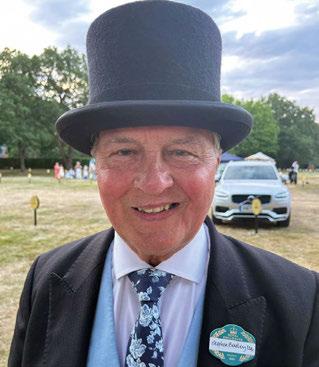
Ascot, but if you’ve bred it too it’s extra special. We were invited back to the course for a celebratory breeders’ lunch – I think out of all the winners at that year’s meeting, only us and one other breeder still owned their horses.”
Bradley’s interest in racing started in the late 1960s on the family farm in south Wales – the land is now occupied by an exclusive golf club and spa.
His parents, who raised cattle and horses and managed a haulage
business, bought and raced both ponies and thoroughbreds, which ran in the name of his mother.
Having decided the farming and haulage world wasn’t for him, Bradley made his mark in financial services, initially with Prudential, moving around the country – “I was very lucky in my career as I was headhunted a couple of times” – before starting a company called UKinsuranceNet with two colleagues. The business was developed to become one of the leading online insurance brands and was sold in 2020; it’s now part of PIB Group.
Bradley, who now lives in Yorkshire and has interests in commercial property and a firm called Seegrow Solutions that produces ozonated water to treat turf in sports arenas – “Arsenal and Chelsea have our machines; I think the principles of running a business are the same if the idea is good” – first dipped his toes into ownership through syndicates.
Deadly Encounter, shared 50-50 with a friend, won a couple of decent handicaps with Richard Fahey – trainer of The Ridler and Stormy Impact –while others owned in partnership included Emperor Caradoc and Parisiac, the latter with late Levy Board Chairman Paul Darling.
“Paul was a lovely guy – how the sport needs him now,” Bradley says. “He was a huge support to me when The Ridler enquiry was going on.”
The move into breeding occurred when Bradley met Hilary Fitzsimons by chance at Jane Chapple-Hyam’s yard 14 years ago. Fitzsimons, who owned a homebred in training that he took a half-share in, also had some broodmares. “They were okay but I didn’t want to breed from them,” Bradley recalls. “I wanted to buy new mares and Colorada was the first one.”
Colorada, acquired for the princely sum of 2,500 guineas at Tattersalls in 2016 – “I liked the pedigree of Lope De Vega out of a Sadler’s Wells mare” –has proved an exceptional purchase.
To date she has bred four individual winners – The Ridler, Stormy Impact, Dylan De Vega and Colorada Dancer
– while her son by Bated Breath made 170,000 guineas at Book 2 of the Tattersalls Yearling Sale in October, bought by Jamie McCalmont for owner Marc Chan. Named Suspicious Mindz and sent to Jessica Harrington, the two-year-old showed promise on his first start at the Curragh early last month.
Bradley says: “The mare has been brilliant for us – Smarden Thoroughbreds is shared with Hilary – and we paid next to nothing for her. Suspicious Mindz is the first one we’ve sold for decent money. As for Stormy, the object now is to get some black type.
“When you’re lucky enough to have a good horse, you can look at all the programme books you want, but sometimes you’re better off following
“The mare has been brilliant for us and we paid next to nothing for her”
the route of another horse that’s progressed from three to four.
“The one that springs to mind is No Half Measures. Look at what she did last year, ending up at Longchamp [in the Prix de l’Abbaye]. Richard Hughes has already done the planning for us!”
Despite being a daughter of French Derby winner Study Of Man, Stormy Impact, whose dam recorded one placing from seven outings at up to seven furlongs, is showing her talent over sprint trips.
“I think perhaps Kirsten [Rausing] and the team at Lanwades [where Study Of Man stands] were gobsmacked,” says Bradley.
“It was on their website when Stormy Impact won at Epsom over five furlongs on the same day that Many Men landed a valuable handicap
at Doncaster over 1m6f! Both are by Study Of Man – it’s given a different perspective to the stallion.”
In the pipeline is Colorada’s latest progeny – a Too Darn Hot yearling filly – along with a two-year-old Bated Breath colt bought last year and a homebred two-year-old son of Almanzor out of Sous Le Soleil. Four foals were also purchased in 2024.
Sous Le Soleil is the dam of Wootton’Sun, who landed the Old Newton Cup in Bradley’s colours before being sold to Prince Faisal Bin Khaled, for whom he contested the Saudi Cup in February.
Bradley thought so much of Wootton’Sun that he purchased his dam in France to breed from. He sold Sous Le Soleil’s Waldgeist colt as a yearling for €80,000 at Arqana – he made €360,000 when re-offered at the breeze-ups – while her first colt by Almanzor, The Sheriff, was entered in the German Derby at the time of writing.
Sous Le Soleil was subsequently sold but sadly died earlier this year while foaling.
There’s plenty to look forward to for Bradley, 75, who enjoys the social side of racehorse ownership but takes issue with the way racecourses distribute their income from media rights –“Stormy Impact is my Madonna, and she wouldn’t perform at a venue for free!” – and feels the sport has suffered under the current Labour administration.
“This government are an absolute shambles,” he says. “Trying to tempt someone under 40 to take a leg in a horse is a bloody sight harder now than it was three years ago.”
He adds: “I think the best aspect of ownership is the camaraderie with the other owners. There’s never any animosity. We all know it’s costing us a lot of money, whether you’ve got millions or not.
“If you have a big or a small share in a horse, you’re still there to win that race. Look at Middleham Park at Epsom on Derby day – they had over 100 people there. That’s what we need.”
If you ask racing fans what the best evening meeting of the year is, I’m pretty sure the vast majority will say the Brigadier Gerard at Sandown. It’s a fixture I look forward to and have been going to for many years. Over those years, I have seen Derby heroes, Ascot Gold Cup scorers, precocious two-year-olds and many a future Royal Ascot winner.
Imagine my surprise when in the days leading up to this year’s meeting, I saw a headline in the Racing Post Weekender saying ‘Change afoot if Brigadier Gerard meeting is not better attended’.
In the article, it was suggested that running it on the Bank Holiday at the end of May would attract families as well as racing fans and lead to an increased attendance. The attendance may well be increased by moving the meeting to the Bank Holiday Monday but surely there are enough family racedays already.
The Thursday evening in May for the Brigadier Gerard is one of the first dates that gets circled on many racing fans’ calendars. Attendees are regular racegoers – the likes that have annual membership of at least one racecourse. I bump into many familiar faces, the same ones I see on the Tuesday of Royal Ascot, the Wednesday of Cheltenham, on Classic days at Newmarket and Epsom and of course, Eclipse and Tingle Creek days at Sandown. They form a hardcore support for a great evening’s racing and it’s the type of meeting that could easily convert a casual racegoer into a lifelong racing fan.
As the saying goes, be careful what you wish for. Racing is naturally keen to attract a new audience, but it needs to look after its established loyal fans. I’d be surprised if Sandown wanted to give up the accolade of hosting the best evening race meeting. To host anything that is recognised as the best is an attribute that should not be taken lightly.
I haven’t seen any attendance figures for this year’s meeting, but it appeared well attended and there was a great atmosphere on a warm summer’s evening.
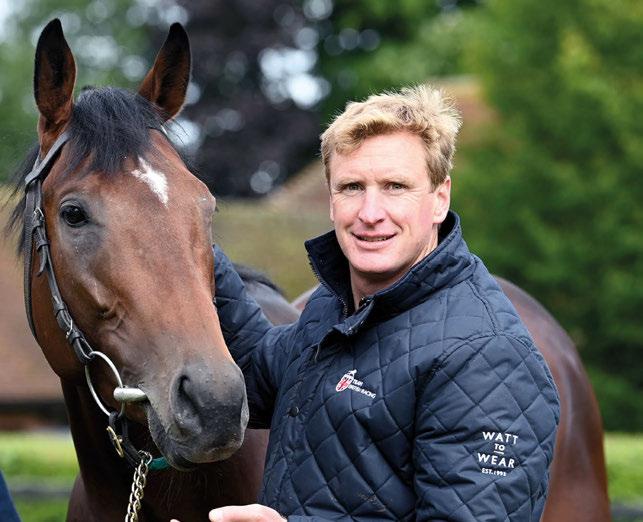
The highlight of the evening for me was the feature race itself. It was at this meeting the previous year when Ed Walker told me that Almaqam was the nicest horse he had trained. He had won the Heron Stakes impressively that night, but things didn’t pan out for him for the rest of the season. A combination of fast ground and Group 1 opposition meant he didn’t add to that victory. A year later and with enough ease in the ground, he strode to an impressive all-the-way victory in the Brigadier Gerard, with the promise that he may well fulfil Ed’s hopes for him this season.
There was a lovely moment soon after Almaqam had crossed the line. I had watched the race from just beyond the winning post with several fellow Kingsdown Racing Club members. We were still applauding Almaqam when Ed appeared through the crowd walking towards us, grinning from ear to ear. “I didn’t enjoy that” he said with a wry smile as we all congratulated him, before we rushed to see Almaqam and Oisin [Murphy] return to a warm reception in the winner’s enclosure.
Ed’s rich vein of form continued a few days later with Ten Bob Tony winning the John Of Gaunt, the highlight of a pattern-race treble on ITV. Ten Bob Tony, with his splashes of white on his chestnut coat, is always a big attraction when we visit Ed’s stable.
Ed’s excellent season continued with a Royal Ascot double courtesy of Never Let Go in the Sandringham Handicap and Noble Champion in the Jersey Stakes.
I’d just like to point out that Ten Bob Tony isn’t named after me! I’ve never had that nickname, but I could easily have had that moniker. When I was a young lad, about six or seven years old, I was on a family holiday at a holiday park near Walton-on-theNaze. As we were walking through a field, I saw something red on the ground – it was a ten-shilling note! I celebrated my good fortune with my two brothers – we had great day on Walton Pier spending our ten bob on the fairground rides.
Let’s hope the season brings more good fortune for the Ed Walker stable and stars like Almaqam.
You can enjoy a Premier League matchday in style with premium hospitality at Brentford FC’s Gtech Community Stadium, available to ROA members through Bid to Give. This exclusive package for four, hosted by Betway, offers the perfect blend of thrilling Premier League action and firstclass hospitality.
You and your guests will enjoy prime seating, exceptional food and drink, and a fantastic atmosphere as you take in the
game from one of the best spots in the stadium. The fixture will be agreed with Betway, ensuring a matchday experience to remember.
Be sure to get your bids in for this terrific prize before the closing date of July 25 at www.bidtogive.co.uk
All funds raised through the auction help Racing Welfare to provide its vital services to all those working in or retired from the British horseracing and thoroughbred breeding industry.

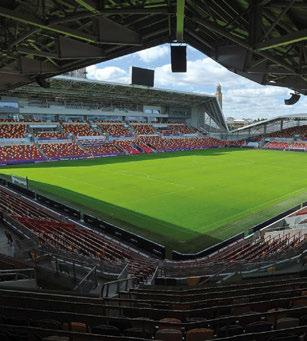
On Sunday, July 6, around 90 people from across the industry took on Racing Welfare’s flagship challenge event for the year – a 22-mile trek from Scarborough Castle to Whitby Abbey, raising crucial funds for the charity.
Many of those who took part did so after seeing first-hand the support Racing Welfare provides, including Warren Greatrex, who assembled a team of 14 people from the Lambourn racing community – The Lambourn Wanderers – to take part. Below is Warren’s heartfelt message on the fundraising page, detailing his reasons for signing up.
“Over the last five years I have got to know the team at Racing Welfare very well. Unfortunately for the saddest of reasons.
“As many of you know, my yard has
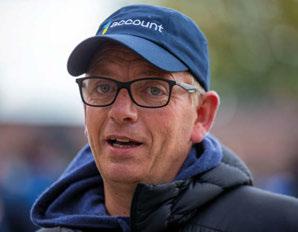
had three tragedies in recent years where three young members of our team took their own lives. No words can describe the devastation it leaves behind for the families, friends and colleagues. On each occasion Racing Welfare have been nothing short of incredible. They have been on site in
From June 21-27, Racing Welfare held the ninth running of Racing Staff Week, which is generously supported by Betfair.
Racing Staff Week recognises the contribution of the industry’s entire workforce, from stud and stable staff to breeders, trainers, racecourse staff, administrators, and everything in between. Racing Welfare hosted community events up and down the country throughout the week – from rounders and BBQs to quiz nights and coffee mornings. Racecourses, workplaces and stakeholders across the industry were encouraged to get involved in the celebrations, with many hosting their own activities.
A highlight of the week included three charity races for
each case in the matter of minutes. Their skill, compassion and kindness has been exemplary. From bringing in biscuits and checking everybody is ok to organising counselling sessions for all that needed it. No stone is unturned to make sure everyone is cared for. I cannot thank them enough.
“These cases are just a small part of their work and they are a much needed support system in our industry. This is why when I was approached to take on this challenge there was only ever going to be one answer. Please give generously so we can help them continue their incredible work for the whole racing industry.”
You can still show your support for Warren and The Lambourn Wanderers at https://racingwelfare.enthuse.com/ to donate.
stable staff, held at Ayr, Newbury and Nottingham, giving those working behind the scenes the opportunity to take the spotlight and turn jockey for the day.
The Racing Staff Week Photography Competition has returned following the success of last year’s inaugural contest, where entries came from across all corners of the racing and breeding industry. There are six categories, with the photos being judged by a panel of industry stakeholders, plus this year Betfair ambassador Rachael Blackmore is on the judging panel to the overall winner.
Anyone working in the racing or breeding industry is eligible to enter images snapped on their mobile phone. Entries close on July 21 and further information can be found at racingwelfare.co.uk/rsw.

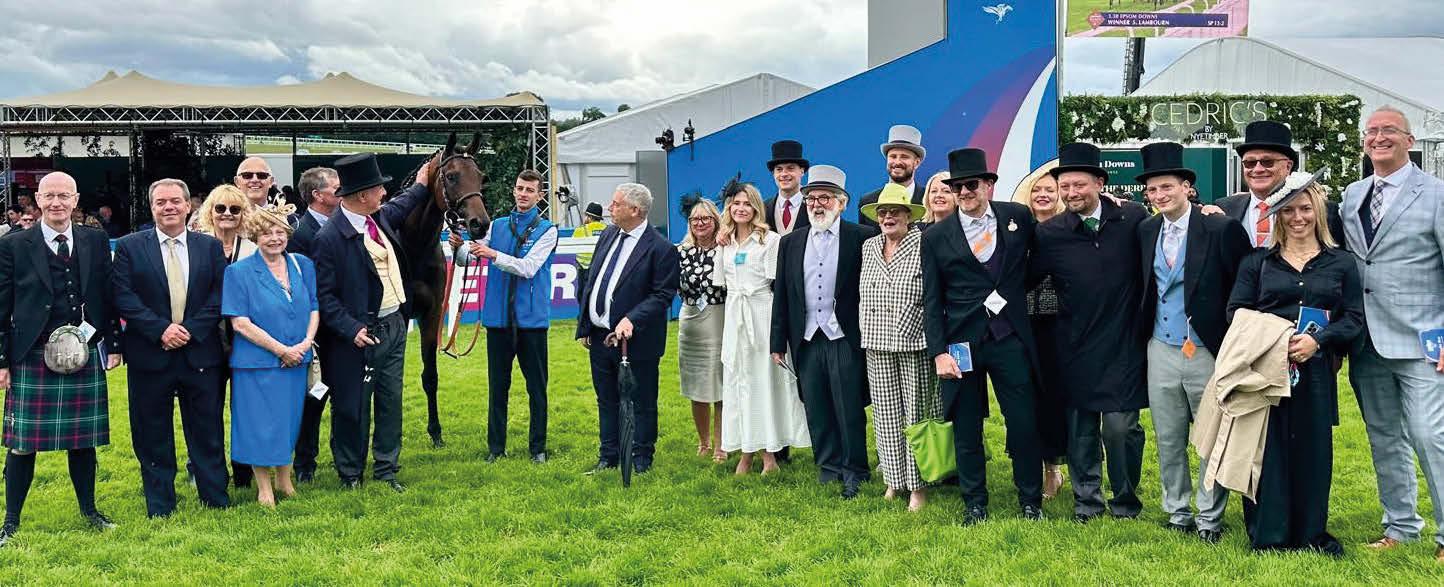
I am penning this one day after a syndicate-owned horse was within one place of winning the Derby, writes Phil Boyle
If even ten years ago someone had suggested to me that I might type that statement, then I would have thought that they were mad, but nowadays, the thought that joining a syndicate or racing club could provide access to the very top tier of the sport is by no means fanciful and indeed but for a demotion in France, syndicate shareholders would already have celebrated Classic success this season.
Congratulations to all the Middleham Park Racing shareholders who are involved with Lazy Griff. Many of them were on the Downs at Epsom to cheer on their boy and for most of them, finishing second will still have created memories that they will treasure for years to come. He subsequently finished a fine third in the Irish Derby and hopefully there will also be many more thrilling racedays ahead for them.
Most readers will be aware that there are not many Lazy Griffs out there and without pouring any more fuel onto the fire of debating prizemoney, most horses in training do not pay their way. So why on earth would anyone want to get involved?
Well, for many the reasons for
joining a syndicate are the same as the reasons that a sole owner might provide for owning a horse.
Those of us who have owned horses can vouch for the extra excitement of a raceday when you are there as an owner and not just a spectator, and we love the experience of being on the inside looking out rather than the other way around.
In footballing terms, as owners we get to go pitchside pre-match to chat with the manager and the star player about tactics, and then get to meet them again at full time for them to explain how the game went and the lessons that they learned from it to put into practice later in the season. It is so much more special than simply buying a ticket and watching the game.
On top of the raceday experience, we also get to go behind the scenes away from the races, with stable visits offering the opportunity to meet with the trainer and those that look after our horses and to see how our horses are prepared for racing. I am sure that like me, you have seen charity auctions attracting significant sums of money to buy a morning on the gallops that most owners get to experience on a regular basis.
There are a couple of additional things that syndicates and racing clubs can provide that are resulting
in some sole owners getting involved in shared ownership in addition to, or replacing, their sole ownership.
Shared ownership obviously comes at a lower cost to the individual and increasingly owners are using syndicates and racing clubs to ‘diversify their portfolio’. This in turn provides them with more opportunities to go racing and possibly also the chance to work with different trainers and see different facilities.
But there is also the social and community aspect of shared ownership. Experiencing the ups and downs of ownership with others is definitely attractive to many people and having a community of likeminded individuals who may also become friends is very appealing to many who may feel somewhat isolated in sole ownership.
With events away from racing and great communications from the course on days when you cannot attend, syndicate and racing club membership is delivering elements of the ownership experience that are not always available to sole owners.
Being able to offer all those benefits and now offering the realistic hope of winning Classics on the Flat and Grade 1 races over jumps, shared ownership is sure to go from strength to strength.
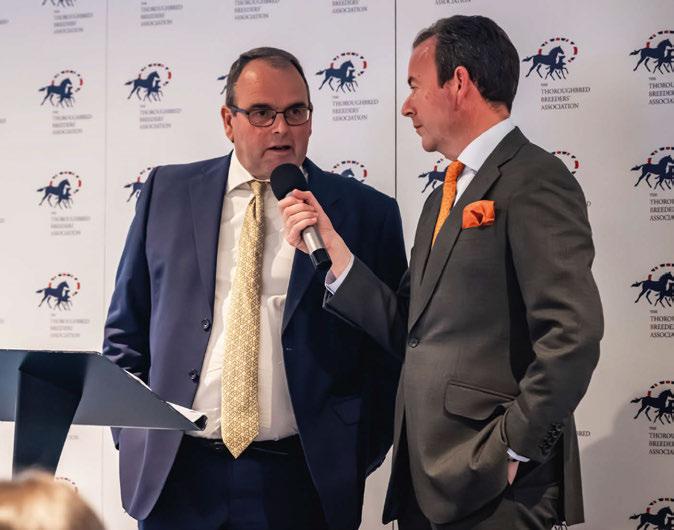
Alan Varey was the big winner at this year’s TBA NH Breeders’ Awards Evening, sponsored by Goffs. He collected the Queen Mother’s Silver Salver, the highest honour bestowed by the TBA’s NH Committee, which recognised Varey’s long and distinguished career in the racing and breeding industries.
Varey, who hails from a non-racing background, showed an interest in the sport from watching the TV at a young age. He was sent off to the stable of Jack Yeomans aged 15, before working for Matt McCourt, who supplied him with his first winner as a jockey. A spell away from racing preceded a livery yard business, before moving to Hillwood Stud in 1995
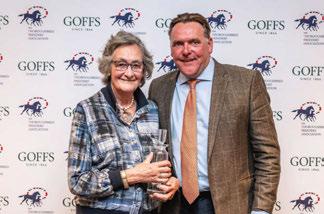
and then Batsford in 2001, where son Tim joined the business.
Since then, Batsford has been home to five Classic winners, including current stallion Kew Gardens.
On being awarded the accolade, Varey said to host Nick Luck: “I’m lost for words, I’m utterly speechless.” When asked by Luck what gets him up in the morning, Varey commented: “Just seeing what we have in front of us, beautiful stallions who are performing well, all their offspring doing well and seeing the foals in the paddock – the up and coming.”
Varey paid tribute to Tim and the role he has played in their success, saying: “He’s 50 per cent of the business. We didn’t let him come in early, he had to go out and
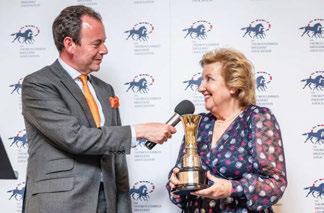
learn his trade and then we said we need you – we need your skills.”
Jackie Chugg went away with a pair of trophies from the evening on behalf of her and her late husband Robert’s exploits as breeders. The New Lion, winner of the Baring Bingham Novices’ Hurdle and Challow Novices’ Hurdle last term, was crowned the leading novice hurdler for which the Overbury Stud Trophy was presented. His exploits on the track, along with his sibling Kateira, a Listed winner at Kempton Park in November and runner-up in a Grade 2 at Doncaster, ensured Chugg took home the Dudgeon Cup, sponsored by Batsford Stud, awarded to Broodmare of the Year, Raitera
Two other perpetual trophies were presented on the evening and both headed to Overbury Stud. Sire of Golden Ace and Poniros, winners of the Champion Hurdle and Triumph Hurdle at the Cheltenham Festival, assisted in Golden Horn winning the Whitbread Silver Salver (leading active British-based NH stallion by prize-money) for the first time. On hand to accept the award was Jayne McGivern, who commented: “I wanted to own a stallion, but it seemed impossible to find the sort of stallion that I wanted for National Hunt. And we looked at a couple and eventually I said, ‘This is the one I want, and we’ll wait for him’. And we did wait for him.
“I can’t tell you how much I appreciate every single one of you who support him. I wanted him in Britain for British breeders. I hope I’m giving you good value and it’s wonderful he’s here for us all.”
The Horse & Hound Cup, awarded to the leading active British-based NH stallion (by steeplechase wins) was won for the fifth successive time by Schiaparelli, whose daughter Marsh Wren won the Bud Booth Mares’ Chase at Market Rasen in November.
Highflyer Bloodstock sponsored the leading hurdler category this year, which was won for the second time by Constitution Hill and his breeder Sally Noott was on hand to collect her prize. Whilst the leading chaser category, sponsored by Mickley Stud, was collected
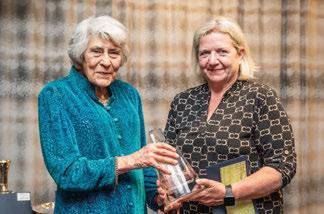
by David Futter and Nick Luck for Gentlemansgame, who was bred by Futter and Luck’s late mother, Maggie.
Winner of the Lady Protectress Mares’ Chase, Telepathique and her breeder Elizabeth Gordon Lennox were the recipients of the Yorton Trophy for leading chase mare. In the hurdling category, which was sponsored by Shade Oak Stud, the Reveley Farms-bred That’ll Do Moss was victorious. The daughter of Black Sam Bellamy was a winner at Ayr and then runner-up in both the Grade 1 Honeysuckle Mares’ Novice Hurdle and Grade 2 Jane Seymour Hurdle.
Transport company Eric Gillie is celebrating its 50th anniversary in 2025 and this year’s Special Award winner was Copperhead. The son of Sulamani, who was bred by Jane Micklethwait, came back to form this past season with vengeance, winning four of his seven starts, including the veterans’ final. The Joe Tizzard inmate’s return is even more remarkable considering he was severely injured in the RSA Chase of 2020, where he had survived a kick to his eye, after which it was touch and go for a good while. Micklethwait was quick to heap praise on Tizzard and the chesnut’s owner Gill Pritchard for their patience. Runner-up in the Manifesto Novices’ Chase at Aintree and a Grade 2 winner earlier on, Gidleigh Park, bred by Richard and Lizzie Kelvin-Hughes, was crowned the leading novice chaser (Midnight Legend Trophy), while the Peel Bloodstock Trophy for leading National Hunt Flat horse went to Rowland Crellin, breeder of Green Splendour, winner of the Grade 2 bumper at Aintree.
TBA National Hunt Committee Chairman Simon Cox commented: “Once again the NH Breeders’ Awards Evening was filled with wonderful and inspiring stories. Huge congratulations to all the winners on the night.
“Our sincere thanks go to Goffs for their continued support of the event, to Nick Luck for his excellent hosting, and to all of the evening’s sponsors – your support is hugely valued and appreciated.”
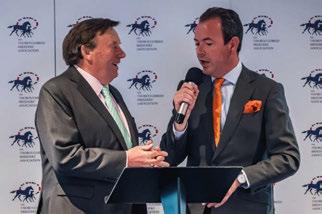
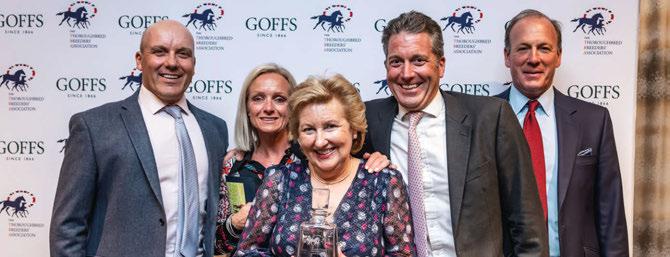
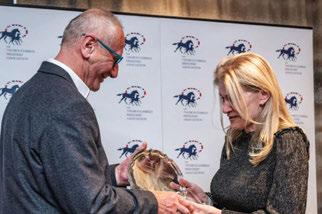
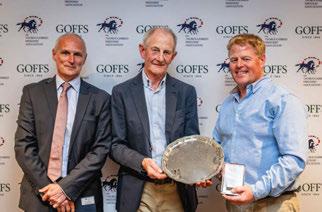
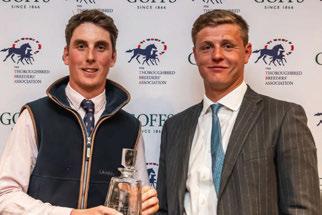
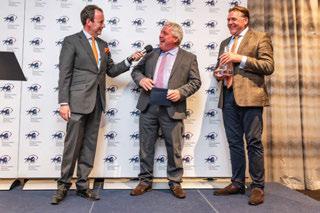
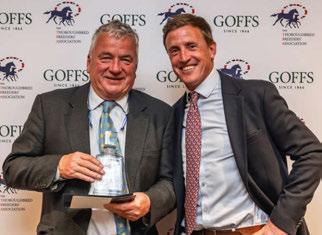
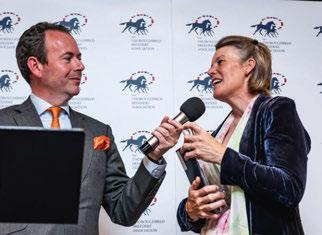
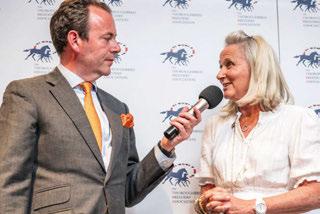


Last month members were informed that Naomi Mellor had been appointed by the TBA’s Board of Trustees to take over from Claire Sheppard, who will step down after the AGM on September 1 following a comprehensive handover process.
A qualified veterinary surgeon, Naomi
Wednesday, July 9
Flat Awards Evening, Chippenham Park, nr Newmarket
Celebrate the success of Flat breeders from the 2024 season in the stunning surroundings of Chippenham Park on the evening before Newmarket’s July Festival kicks off.
Thursday, July 17
‘Nature or Nurture’ TBA Educational Event, Granary Barns, Woodditton
Join fellow members for an educational day exploring influences on foetal and foal development with an expert set of speakers. Lunch and
has over 17 years of equine veterinary experience across the UK, Australia and the South Pacific, including in thoroughbred stud work. She has also served as a veterinary officer at the BHA where she played a role in regulatory compliance and animal welfare at major racing events, including Royal Ascot and
the Cheltenham Festival.
Mellor is the founder and former director of Everybody Media and the International Women’s Podcast Awards and has been a member of Women in Racing for over a decade, including six years as treasurer. Her work as part of the team at Racing Home, supporting working parents and promoting inclusion, has had a lasting impact.
Naomi said: “I am thrilled to be taking up the role of CEO of the TBA and look forward to working with both the team at Stanstead House and others across the industry to secure a sustainable future for the British thoroughbred.
“The breeding sector is fundamental to the success of the sport, in which the TBA plays a central role. We will continue to actively support our current members, ensure productive working relationships within the industry and look to grow a new pipeline of breeders in the future.”
Philip Newton, Chairman of the TBA, commented: “We are absolutely delighted to welcome Naomi as our new Chief Executive. It is rare to find someone with such a diverse and accomplished background, combining extensive veterinary expertise with global experience, stakeholder engagement, and a proven track record in advocacy.
“Naomi’s appointment comes at a pivotal time for the industry, and we are confident she will be a powerful voice for our members, British breeders and the future of British thoroughbred breeding.
“I would also like to once again thank Claire Sheppard for her exceptional contribution to the TBA over the past eight years.”
refreshments will be provided.
Monday, September 1
AGM, Jockey Club Rooms, Newmarket
The 108th Annual General Meeting of the Thoroughbred Breeders’ Association will be held from 5.45pm at the Jockey Club Rooms, Newmarket CB8 8JL. Further details to be released.
For more information regarding events, as well as to see when regional events have been fixed, either contact the office or check out the regular e-bulletins.
Sponsored by Watership Down Stud, this year’s Flat Awards Evening will take place on Wednesday, July 9 at Chippenham Park.
Hosted by Gina Bryce, the event will celebrate the successes of the 2024 Flat season and breeders, owners, trainers, stud staff and enthusiasts will enjoy a champagne reception generously provided by Newsells Park Winery, a two-course dinner with wine sponsored by Chasemore Farm and followed by the awards ceremony.
Tickets for the evening are £85pp and can be secured via the events section on the TBA website.
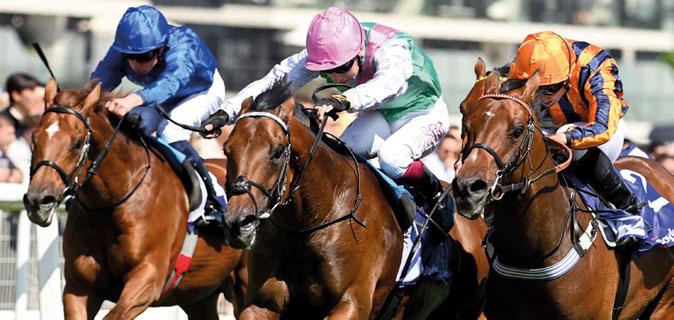
Athree-time winner in Poland as a juvenile, Lady Ilze was transferred by her owners to Andreas Wohler and ran fourth in the main Guineas prep, the Karin Baronin von Ullmann Schwarzgold-Rennen. Three weeks later at Dusseldorf and the daughter of Territories, who was bred by one-mare owner Lulu Winter, who formerly worked for Rae Guest and now Jack Jones, produced a strong run in the final furlong to win the German 1,000 Guineas by a length.
The Karin Baronin von Ullmann Schwarzgold-Rennen was won by Santagada
There was also Classic success for the Aga Khan homebred Zarigana, who gained the Poule d’Essai des Pouliches in the stewards’ room following the disqualification of Shes Perfect.
Juddmonte’s Cosmic Year finished runner-up in the Irish 2,000 Guineas having won the King Charles II Stakes in taking style at Newmarket. He was one of four homebred British-bred winners for the team.
Lead Artist (Dubawi) relished the return to faster conditions in a strong renewal of the Lockinge Stakes to record his maiden top-level win, whilst Babouche also bounced back from a disappointing seasonal return with an impressive victory in the Lackan Stakes at Naas. The quartet was completed by Sunly in the Prix de la Seine at Longchamp.
At Santa Anita on Memorial weekend, King Of Gosford, a son of former shuttler Zoustar and bred by the Tweenhillsofficiated Miss Sugars Partnership, graced the winner’s enclosure after landing his first Grade 1, the Showmaker Mile Stakes. American Gal, a daughter of Kameko, captured the Prix des Lilas and was bred by the Granny Franny Partnership, another Tweenhills partnership.
The David Redvers and Stephen and Becky Hillen (Framont Ltd)-bred Mgheera, like American Gal in the hands of Ed Walker, was meant to be headed for a southern hemisphere cover, but two wins in May could have stalled those ambitions for connections. The daughter of Zoustar won the Prix de Saint Georges at Longchamp and captured the Temple Stakes at Haydock Park two weeks later.
Going one better than his half-brother Dragon Symbol, Symbol Of Honor (Havana Grey) won the Sandy Lane Stakes in good style, a week on from his triumph in the Carnarvon Stakes. He was bred by Whitsbury Manor Stud, as was Rumstar, another son of resident Havana Grey, who won the Palace House Stakes on Guineas weekend.
Godolphin-breds were in fine form during the month. Cinderella’s Dream won the Dahlia Stakes in impressive fashion on the 1,000 Guineas undercard at Newmarket, whilst there were Group 3 wins for Almaqam in the Brigadier Gerard Stakes – another stakes winner for Ed Walker – and Cualificar in the Prix de Guiche, before a runner-up finish in the Prix du Jockey Club.
There were also Listed wins for Diamond Rain in the Hedge of Oak Stakes (formerly Rothesay Stakes) and Quddwah in the Prix de Montretout.
Over the course of the three days at the Dante Festival the most impressive performance was that produced by 12-length scorer See The Fire in the Middleton Fillies’ Stakes for ownerbreeder Jeff Smith.
The Knavesmire also witnessed a winning seasonal return for Inisherin in the Duke of York Stakes for ownerbreeder Sheikh Mohammed Obaid.
Winner of the Prix du Muguet in 2023 and 2024, the Car Colston Hall Stud-
bred Tribalist, a son of Farhh, made it a hat-trick of wins in the Group 2 at the beginning of the month.
Down in Australia and the David and Trish Brown-bred Delius (now under the moniker of Sir Delius), who sold for a record-setting 1.3m guineas at Tattersalls last autumn, made a triumphant debut down under in the Chairman’s Handicap at Doomben.
Another son of Frankel, Touristic, won the Lord Mayors Cup at Rosehill.
There was a proliferation of Listed winners scattered across Europe. At home, the Brightwalton Stud-bred Kon Tiki won the Michael Seely Memorial the day after the Hellwood Stud Farm & RC Dollarbred Tropical Storm (Eqtidaar) took the Westow Stakes, both races at York.
On Guineas weekend, the Ellen Chaloner Stakes went to the Haddenham Stud Farm Ltd-bred Tiger Bay, a daughter of Harry Angel and the following day the Pretty Polly Stakes was won impressively by Falakeyah, a Shadwell homebred.
The David Aykroyd-bred Amiloc (Postponed) was going on best at the line in the Cocked Hat Stakes at Goodwood and in the Cathedral Stakes at Salisbury it was Fair Angellica, a daughter of Harry Angel bred by Wendy Miller, who hit the line in front.
In Ireland there were wins for the Dunchurch Lodge Stud-bred First Instinct, a daughter of Bated Breath, in the Polonia Stakes, for the Michael Smurfit homebred Chicago Critic in the Amethyst Stakes, and for the Gestut zur Kuste-bred Bucanero Fuerte in the Sole Power Sprint Stakes.
In Sweden on the dirt at Jagersro, Aphelios, bred by Kingwood Stud, won the Pramms Memorial, whilst in Germany the Rebecca Philipps-bred Golden Horn filly Lady Charlotte took the Grosser Preis der Burckhardt-Gruppe at Hanover and followed up in the Group 3 Diana-Trial at Hoppegarten. In Rome in the Premio Botticelli, the Trevor Fox-bred Tutto Torna was victorious.
Stateside at Churchill Downs, the Cayton Park homebred Marksman Queen, a daughter of Dubawi, won the Keertana Stakes. Further west at Santa Anita and the Zoustar mare Lunar Impact, bred by Paddy Barrett, landed the Mizdirection Stakes.
Over obstacles and there was a first black-type success for the Goldford Stud homebred Aston Martini in the Prix du Cher at Compiegne. Meanwhile, at Merano, Natam, bred by Aldo and Carlo Borsani, won the Premio Chivas Regal.
Results up to and including May 31 and provided by GBRI.
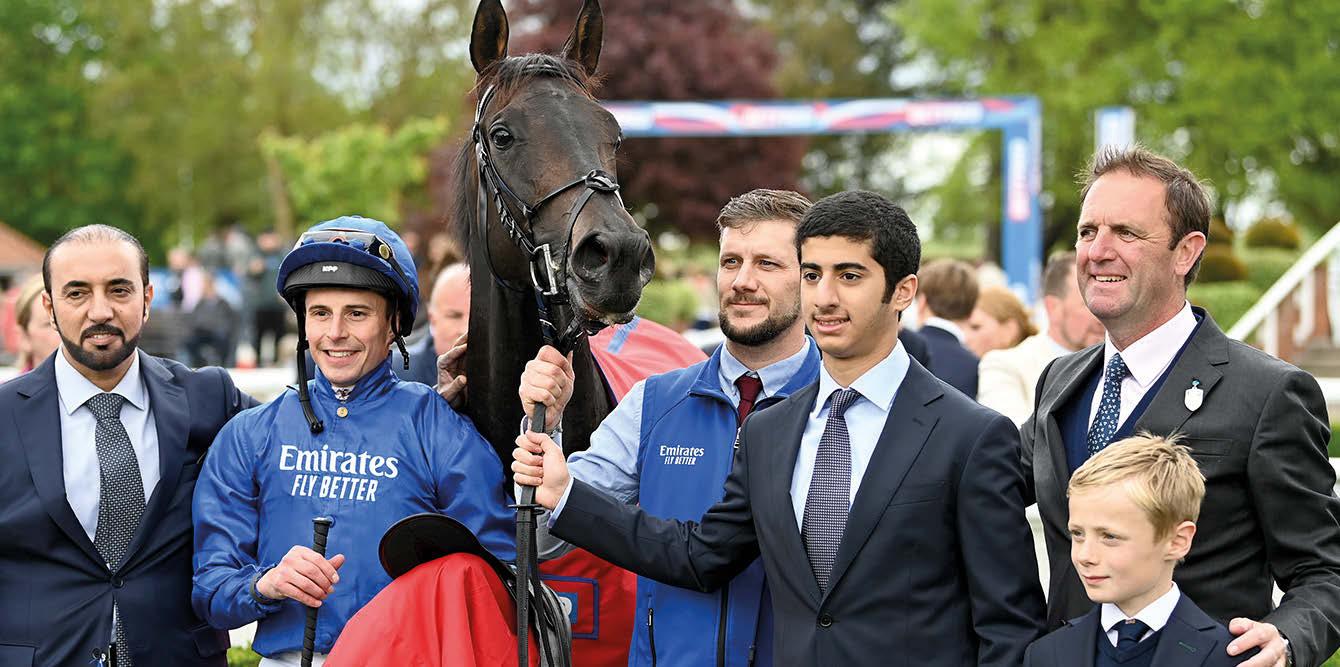
Godolphin’s thoroughbred operation has been a major force around the world for decades now but results on the first weekend in May aligned to make it perhaps the most successful occasion in its long and storied history.
Sheikh Mohammed’s royal blue silks were carried to victory in both Classics either side of the Atlantic, beginning with Good Cheer in the Kentucky Oaks at Churchill Downs followed by Sovereignty in the Derby 24 hours later, with Godolphin becoming the first owner since 1952 to achieve that particular double.
At Newmarket, it was breeze-up purchase Ruling Court who made the perfect start in Saturday’s 2,000 Guineas with a performance full of class under William Buick before homebred Desert Flower showed spirit in abundance to take the 1,000 Guineas on the Sunday. To cap it off, one of the stars of Godolphin’s four-year-old division, Cinderella’s Dream, emphatically defeated last season’s 1,000 Guineas winner Elmalka in the Group 2 Dahlia Stakes.
They were such a momentous series of outcomes that Liam O’Rourke, Godolphin’s Stud Director, still finds it hard to sum the experience up.
“It was something I suppose that, without thinking too deeply about it, we had in the back of our minds as ‘wouldn’t it be wonderful if’ something like that could happen but you don’t ever take it any further or try to tempt fate because you never realistically expect you could,” he said.
“It was quite amazing and even more wonderful that of the four Group 1 winners, three were homebreds from different locations, which gave us all a huge amount of pleasure.
“I began to think the prospect was on after we won the 2,000 at Newmarket, I wasn’t the only one who had a good feeling, and, unbelievably enough, it all came to pass.”
Desert Flower was a first Classic winner for sire Night Of Thunder, a leading son of its powerhouse sire Dubawi who has been based under the operation’s Darley umbrella at its studs on both sides of the Irish Sea.
The daughter of the internationally-campaigned Promising
Run had been unbeaten in four starts at two, culminating in the Group 1 Fillies’ Mile on the Rowley Mile the previous October. She would reappear in the Oaks, showing similar resolution despite difficulties on the track to claim third.
O’Rourke continued: “She’s very much our own product going back to the granddam, Aviacion, who was an imported horse from Brazil that we bought. Promising Run was the best of her daughters, who we still have and she’s been well-covered.
“Desert Flower herself was a very good-looking foal from the get-go, she scored high marks from all members of the team across the board. Through into her yearling year she was just big and backward, perhaps, but very impressive in her action. So there was plenty of expectation from her and she duly delivered.”
Equally important to the team for breeding future generations is Cinderella’s Dream, a daughter of Darley’s late and hugely influential sire Shamardal.
A seventh in the previous year’s Guineas was about the only blip on the CV of the granddaughter of George Strawbridge and James Wigan’s classy mare High Heeled. Cinderella’s Dream won at Grade 1 level in the Belmont Oaks and is sure to contest many more lucrative prizes.
“She’s done a lot already,” said O’Rourke. “Fast ground is important for her and she’s done nothing wrong. We’re very pleased she’s a GB-bred, she was foaled at Church Hall Farm in Newmarket and then raised in Ireland with most of our yearlings. She’s a very good filly indeed and we’d like to think there’s big days ahead of her as well.”
Of Godolphin’s introduction to the family, O’Rouke explained: “We bought her dam Espadrille [a dual winner by Dubawi] as a foal from James Wigan but sadly we lost her as quite a young mare, only a couple of years ago. We’ve got Cinderella’s Dream and there’s a winning three-year-old, Blue Laced, they’re the only two live foals we had out of the mare.”
The weekend showed that, even with the standards Godolphin has set, there are always landmarks to appreciate.
“It has taken a long time but it’s wonderful we’ve done it,” O’Rourke added. “It’s doubtful we’ll ever achieve it again but we’re thrilled, absolutely thrilled.”
When a racehorse leaves the track for the final time, their journey is far from over. In fact, it is just the start of a new chapter, one that demands the same care, consideration and commitment as any stage of their racing career. Ensuring that horses thrive after racing is central to the sport’s social licence and credibility, and that is where traceability plays a crucial role.
At the heart of British racing’s aftercare framework is Retraining of Racehorses (RoR), the charity tasked with leading the industry’s efforts on former racehorses. Traceability is the foundation of this work: it allows us to know where horses go, what they do next, and whether they and their owners need support. It is not about control – it is about care.
In June, RoR and the British Horseracing Authority (BHA) marked a major milestone in this mission with the launch of a new data-sharing agreement designed to improve real-time traceability. From the moment a non-racing agreement (NRA) is logged on the BHA’s database, RoR now receives the owner’s contact details and can reach out directly to check on the horse’s next steps. Owners are invited to complete a short survey to confirm the horse’s status and plans, and, where appropriate, register with RoR.
The survey takes less than five minutes, but its impact is significant. It gives RoR the information needed to offer timely welfare advice, signpost retraining resources, and ensure no horse falls off the radar. Importantly, it also invites owners of former racehorses to become part of a supportive community and access a network of advice, education and opportunities to compete.
This initiative supports both the RoR strategy 2024-2026 and the Horse Welfare Board’s ‘A Life Well Lived’ framework. It reinforces a shared industry commitment to lifelong responsibility where traceability is no longer viewed as a box-ticking exercise but as a genuine opportunity to provide continuity of care.
Racehorse owners are pivotal in this system. Each year, over 2,000 NRAs are signed, and the responsibility for setting the horse up for success in its new home starts with the owner. Many already go above and beyond, carefully selecting
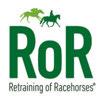

A
the next step and taking time to ensure the horse’s needs are understood. Others need more support – traceability helps to identify where and when that support is required.
We’re not naïve and recognise that not everyone will want to engage with RoR. Some may feel they don’t need support or may be wary of being ‘tracked’. But this isn’t about surveillance. It’s about building the data needed to understand the true scale of racing’s aftercare responsibilities – and identifying where things sometimes go wrong.
If a horse later ends up in difficulty, traceability can help us ask the right questions. Did the problem arise when it left racing in the first step after training? Was it three homes down the line, when it was mis-sold to a novice rider? Or did it occur at a certain life stage? With that insight we can shape better support, whether that’s ramping up training resources, strengthening owner education, or intervening earlier. It’s about being there for the horse at any point beyond the nonracing agreement.
The principle is simple: every former racehorse deserves a responsible, informed transition. Not every horse will need charity intervention, but all should be known, connected and visible within the system. That is why RoR has also
expanded its registration criteria to include all thoroughbreds bred for racing, even those who never entered training. They too deserve to be part of the wider aftercare community.
Having one central charity overseeing aftercare is vital to making this work. RoR’s national remit allows it to coordinate programmes, set retraining standards, support vulnerable horses, and reduce duplication. With stronger data sharing and owner engagement, targeted help can be provided when it is needed most, rather than applying one-size-fits-all solutions.
Recent developments also reflect an evolving funding model, where industry and owner contributions support a fairer and more sustainable future. A new entry levy, supported by the ROA, means that RoR receives between £11.25 and £26 per horse, with most owners contributing £15 or less. It is a modest but meaningful step in recognising aftercare as part of the life cycle of ownership.
Ultimately, good traceability is not about paperwork or process. It is about horses. By working together, and by making the most of new tools such as the RoR–BHA agreement, we can ensure that every horse retiring from racing gets the chance of a fulfilling second career, and every owner has the guidance they need to make that happen.

It’s the final evening of the Goffs Arkle Sale and Frank Motherway is trying to unwind upstairs in the Goffs lounge. But with one more lot from Drumlin and Yellowford still to sell, relaxation will have to wait. It’s a long way from 1972, when Frank first dipped a toe into the bloodstock world at the old Goffs Ballsbridge complex, buying a Raise You Ten filly for 680 guineas.
Having grown up on a farm, hunting and showing horses, Frank had planned to send the filly pointing. Injury changed that, and so began a breeding journey that would span over five decades. He fondly recalls a brief flirtation with training – a filly on the old supplementary register, whose preparation was not quite on Martin Pipe lines: three days ridden work followed by a long rest to ensure freshness at the races. It didn’t end in glory, and the bloodstock world can thank fate that Frank chose breeding over training.
Selecting a stallion for his injured mare wasn’t easy, with options from John Magnier’s Grange Stud and satellite farms – Prince Hansel, Laurence O, and the soon-to-be-famous Deep Run, all standing for £120. Laurence O, the biggest and best-looking, was Frank’s pick, though it was with Menelek, standing with Vincent Hartigan, that the mare produced a fine colt foal. That foal was brought to the newly-established sales ring at Simmonscourt, a venue created through the tireless work of Willie O’Rourke and supportive breeders.
Frank loved those early sales and
soon developed a strategy: buying foals and re-selling them as yearlings, a trade he balanced with a busy farming life. Yellowford today milks 130 cows and keeps over 160 cattle.
Showing also became a strength, with Frank winning the championship class at the yearling sales three years’ running. The first Menelek colt was followed by a Giolla Mear filly, both fetching impressive sums and helping establish Frank’s reputation. The colt, Ashbourne House, went on to be a prolific winner for the Hussey family.
Flush with new funds, Frank purchased Saucy Society, a six-time winner owned by Capt. Luke Mullins of the famous Mullins racing family. Her first colt foal sold for £12,000, and Saucy Society would go on to become one of the foundation mares of Drumlin & Yellowford. Her daughter Queenie Kelly, gifted to Frank’s daughter Deirdre, became a prolific producer of black-type performers and helped inspire the Motherway childrens’ deep interest in the bloodstock world.
Today, Frank’s children – Deirdre, Paul, Colin and Marie – are key players in the operation along with daughters-in-law Michelle and Linda and son-in-law Conor, whose farm makes up the Drumlin part of the partnership. Further down the line are grandsons who also share Frank’s passion for hurling.
Frank never ventured into Flat breeding – “fear of the unknown!” he states, saying that the next generation are involved – but sticking to the National Hunt game has brought continued success. Asked about

the key factors in their achievements, Frank stresses conformation and breeding from young mares, saying: “Young mares foal easier and their progeny reach the track sooner.” His showing background gave him an excellent eye for conformation, invaluable when selecting foals to pinhook.
Over time, breeding became the primary focus, and there’s great satisfaction in watching homebred stars like Bellshill emerge from the Yellowford nursery. One of the few jumpers to win Grade 1s in bumpers, hurdles and chases, Bellshill shares the honour roll with Scandisk, dam of 22-time Grade 1 winner Hurricane Fly. The family purchased Scandisk just as Hurricane Fly began his legendary career – an inspired move.
NH foal sales
There was some overproduction – last year’s sub-70% clearance rates were concerning – and with ownership numbers falling, a backlog built up. There is no point producing foals and getting very little for them.
The biggest issue
Definitely prize-money. It has not kept up with rising costs and any increases should be targeted at the lower end. Adding €5k to a €50k race doesn’t make a lot of difference but it makes a huge difference to a €10k race.
French-bred precocity
Getting young NH horses started early is definitely the key – who is going to be the better football player, the kid starting in an academy at six or at 15?
Breeders’ prizes
They’re part of the fabric in France and Britain. Irish breeders deserve tangible rewards, not something gathering dust on the mantlepiece. The UK has the Levy Board to help fund breeders’ prizes – something Ireland should aim for.
Most admired in the industry
John Kiely – an amazing man and a great tutor to young people entering the industry, not to mention still training winners at 88 years young!
Advice to newcomers
Travel to successful studs and yards, surround yourself with good people, and keep learning.
Racehorse owners looking to turn potential into performance are increasingly turning to Kübler Racing, and for good reason. With a 17% strike rate in 2024 and a record number of winners, Daniel and Claire Kübler are proving that combining traditional horsemanship with a smart, data-driven approach delivers consistent success.
Based at Sarsen Farm in Upper Lambourn, the Küblers offer owners a results-focused training environment where each horse benefits from individual attention, scientific insight, and precise race placement.
as horses, creating a professional, supportive environment where staff are encouraged to grow their skills and understanding. This investment in human talent ensures consistent, high-quality care that underpins every horse’s training and performance.
WITH SWITCHERS AND YOUNG HORSES
The Küblers have built a strong reputation for improving horses that have started their careers elsewhere. Astro King, purchased for just 36,000 Guineas, went on to win the Cambridgeshire and earn over £200,000. Andaleep, who arrived rated just 65 as a six-year-old, has won nine races under their care and banked over £200,000, recording a career-best Timeform rating at the age of nine.
Their approach to developing young horses is equally impressive. All five yearling colts purchased in 2022 went on to win — four of them in novice company, and two in valuable £30,000 contests. This is not just about flair; it is repeatable, structured success.
Owners who switch to Sarsen Farm consistently report not only better results but also improved communication and greater involvement. The Küblers are hands-on, transparent, and committed to working closely with owners to develop each horse’s career. Their collaborative work with ownerbreeders is a key strength, helping nurture families and shape long-term success.
If you believe your horse has more to give, or you want to be part of a yard where detail, care, and performance matter, now is the time to talk to Kübler Racing. Whether you’re seeking a fresh approach for your horse, looking to source your next winner at the sales, or want to join one of their exciting inhouse partnerships, Daniel and Claire would be delighted to hear from you n
British racing expands its safety net and begins roll-out of core aftercare

n 2021, the Horse Welfare Board released its Aftercare Funding Review and the results of a detailed study into the management and quality levels of racing’s aftercare segment.
Every decision, from training intensity to race placement, is shaped by a thoughtful blend of observation, experience, and evidence. Both Daniel and Claire combine a deep understanding of horsemanship with a commitment to using data and science to enhance performance. Claire’s background in Natural Sciences from Cambridge complements their shared analytical mindset, informing areas such as heart rate monitoring, stride analysis, genetic profiling, and optimised feeding. Feedback from riders and grooms is continuously assessed alongside the data to ensure each horse’s training is tailored for success.
“We make use of the data, but we never forget the horse,” they explain. “It’s the combination of analysis and feel that makes the difference.”
The report found that current aftercare service provision has grown organically over the years, to provide a blend of promotional and educational opportunities for thoroughbreds following a racing career. While retraining and rehoming facilities are offered by a mixture of private and commercial plus charitable bodies, there was no consistency in assessment, methodology or reporting making future health and welfare provision for thoroughbreds difficult to forecast and budget for.
Purpose-built and thoughtfully designed, Sarsen Farm offers an outstanding setting for the development of racehorses. Situated in the heart of Lambourn’s world-renowned training valley, the yard benefits from immediate access to the Jockey Club gallops while providing a calm, efficient base where horses can flourish.
Contact Daniel on 07984 287 254 or Claire on 07714 294 172 Sarsen Farm, Upper Lambourn, Berkshire www.kublerracing.com
Considerable cross-industry work has since taken place and, this month, key initiatives start to roll-out. Central
responsibility to now include a thoroughbred’s first step
The facilities include large, modern stables designed with carefully optimised airflow to support respiratory health and overall wellbeing. Generous turnout paddocks allow horses valuable time to relax and move naturally, contributing to both mental and physical soundness.
Crucially, the horses are cared for by a skilled and dedicated team whose horsemanship and daily feedback play a vital role in each horse’s progress. Daniel and Claire place a strong emphasis on developing people as well
The review’s recommendations focused on seven key areas to improve the sector in-line with the sport’s welfare commitments: funding; focus and integration; traceability and data; accreditation; community; education; communication. Strategic ownership of these improvements on behalf of the industry was given to Retraining of Racehorses (RoR) with ongoing support to be provided by the Horse Welfare Board Programme Team.
partner for RoR. Based in Oxfordshire and run by Grace
HEROS was appointed following an extensive pitch process engaging 60 British aftercare providers. In place
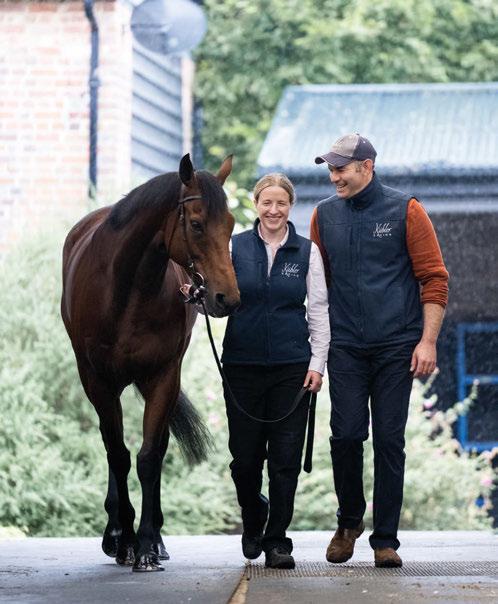
owners, who might be struggling to find
Graham Dench asks our jury the big questions: Is the strategy of altering race distances and restricting runners by certain sires to boost the middle-distance and staying divisions the right one for British racing?
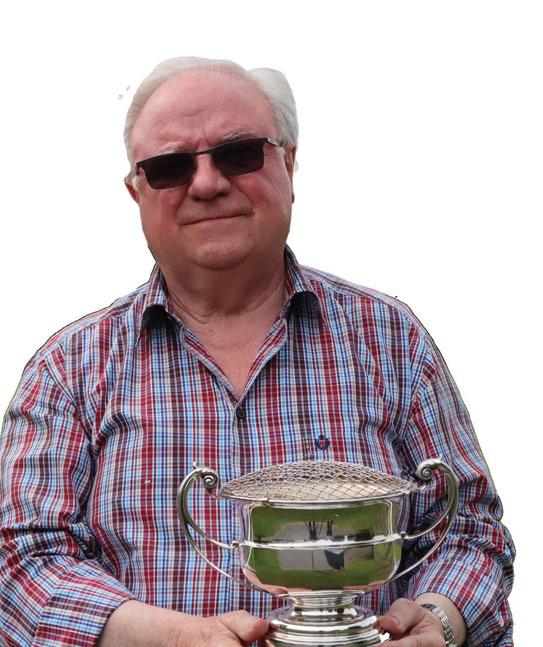
Terry Holdcroft Owner of Bearstone Stud
“
We breed for speed, so I don’t agree with the changes that are being made to the Windsor Castle Stakes [with the distance increased to six furlongs and restricted to runners by sires that won over seven furlongs or upwards at two or a mile and upwards at three]. One or two of the trainers I’ve spoken to don’t agree with them either and I can’t
I like to watch a mile-and-a-half race, but I breed sprinters and run sprinters for a reason. It’s okay to be protecting the middle-distance breed, and there are people who still want horses who take years to reach their best, but it’s not viable for the vast majority.
The cost of keeping these horses in training for two or three years before you find out if they are any good is maybe £25,000 per horse a year, and even then, you might be very competitive but win a race worth just £4,000. That’s the crux of it.
I don’t think trying to get people to breed or buy staying horses by fiddling about with race conditions is going to work, as no matter what they do with race planning, it’s not going to alter the situation. People nowadays want results, and they don’t want to pay for something that’s going to take time.
It’s a simple matter of economics. Those old-fashioned owner-breeders who had all those stayers just aren’t there now – they’ve died off. Coolmore are still breeding them, of course, but even some of their Derby winners are ending up as jumping sires.
Steve Mellish RacingTV pundit
I wholeheartedly support the commitment of the Flat Pattern Committee and European Pattern Committee to safeguard the production, retention and racing of quality horses with stamina, so my answer to this question is yes.
The modern trend is to breed for speed rather than stamina. Two-year-old racing is becoming more important with the lure of quick returns for buyers at the yearling sales. Middledistance horses that are retired to stud have to hit the ground running or they’re quickly seen as jumping stallions.
There are more and more racecards chock full of races over a mile or shorter with fewer races over middle distances or further, resulting in a less attractive product for racegoers and all followers of the sport. There have been calls for the Derby and Leger to have their distances shortened – don’t even start me on this!
Courage and stamina are wonderful virtues of the thoroughbred, and races which test those qualities must be preserved. Speed is great, but so is stamina. Horses like Lochsong and Dayjur were admired, whilst horses such as Stradivarius and Persian Punch were loved. Racing risks losing countless fans if that sort of horse vanishes.
Altering distances and using restrictions based on sire qualifications to races like the Windsor Castle, as they have long done in the Chesham, is a small part in the strategy to protect and encourage stayers. Upgrading races such as the Long Distance Cup on British Champions Day is another. How much all this will help is debatable, but it sends a signal, and it makes a statement saying that stayers are valued and we will support them.
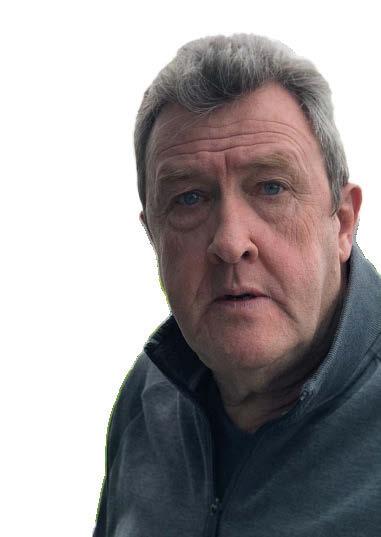

Mark Johnston Record-breaking former trainer
I’m a great believer in us promoting stamina and middle distances but I just think this
From a personal point of view as a trainer, I liked the conditions of the Chesham, in which runners had to be by a sire who won over ten furlongs or more, as I thought it gave me a bit of an edge. I won it three times, but I was never under any illusion that it was doing anything to strengthen the middle-distance or staying division.
The records tell us that of the 29 horses who have won the Chesham since the changes were first introduced, 14 of them never won beyond seven furlongs and only three won over a mile and a half or more. That’s not promoting stamina or doing anything to strengthen middle distances, and a Windsor Castle Stakes over an extra furlong will do even less.
It’s okay to have the odd race like that as a bit of a novelty, but to say that it’s done to boost the middle-distance or staying division is just nonsense. If you want to promote stayers, just put on more races over longer distances and offer more prize-money. It’s that
Maybe in the long-term, bonus schemes are not such a good thing as they are a restrictive practice and exclude foreign-bred horses, but they certainly make us think carefully at the sales about what a horse can win in bonuses. Now with GBBPLUS there’s the added advantage that if you are running them over distances, you can win bonus after bonus after bonus, so it encourages you to have a staying-bred horse and compete it over
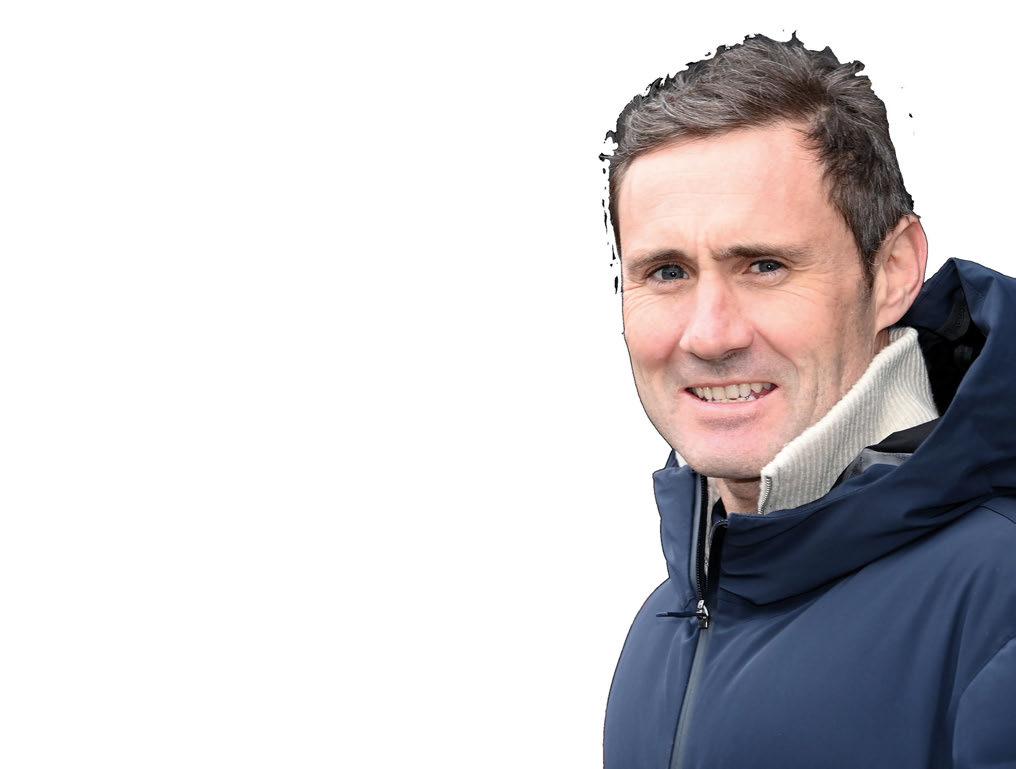
Tim Gredley Leading owner-breeder
“
Any changes to the Windsor Castle won’t really affect us as we are predominantly breeders of middle-distance horses, and out of 30-odd two-year-olds this year we only had one runner at Royal Ascot, and she was bought by my dad. But while the Windsor Castle isn’t a race that we target, Royal Ascot is a tried and tested format and I can understand why a lot of people like the race, as it’s fast and it’s furious.
I completely understand why they are trying to encourage breeding more for stamina, but if people enjoy sprinters and breeding for sprinting then that’s their decision. If it’s not what people want to do you can’t force them to do it.
Although they are raising the distance to six furlongs as well as introducing sire qualifications, I actually think the changes might be detrimental, as it’s still a sprint and you are asking an animal who is not bred to sprint to do something he’s not ready to do.
If they want to do something positive for the middle-distance ranks, then put up better prize-money for that type of horse later on – it’s very simple. The breeze-ups are great if you want to buy a horse that can be racing in a couple of months, but ultimately breeding racehorses is a game of patience and if you are willing to be patient and give yourself a chance in those middle-distance races, you should be rewarded appropriately.
The problem at present is that if you get to Royal Ascot and they clearly aren’t Group-class then there aren’t sufficiently attractive options at home, so many of them are sold abroad. Better prize-money for the big threeyear-old handicaps will encourage people to keep them, and I also think that a better back-end programme at around a mile for the more stoutly bred two-year-olds would also encourage people to give more consideration to owning and breeding middle-distance types.
A race like the Royal Lodge is much more exciting than an early-season sprint race, as that’s where you start to see the bigger pedigrees taking each other on. Let’s have more of them.
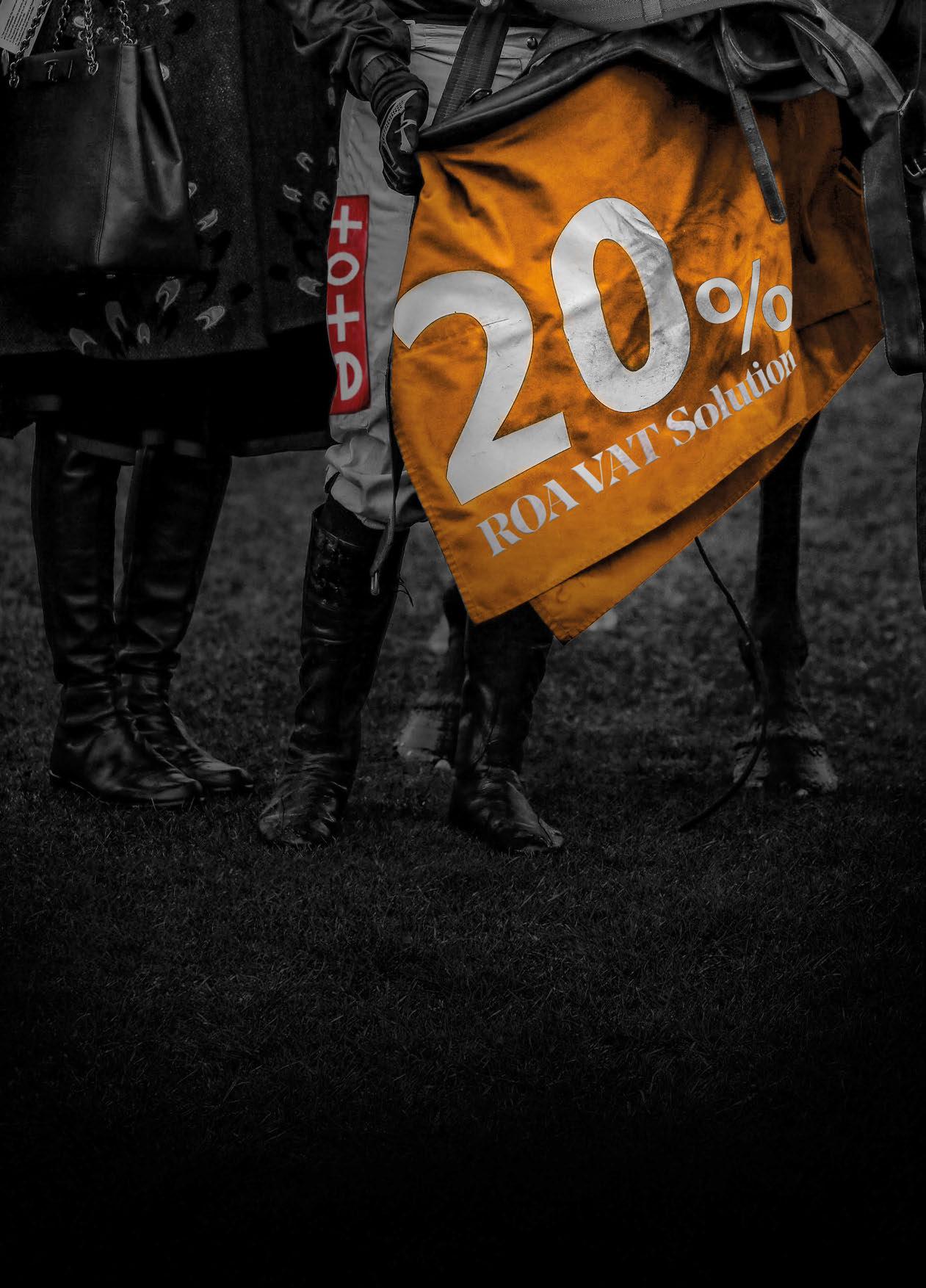
Reclaiming VAT is easier with the ROA VAT Solution.
The Racehorse Owners Association team is here to simplify the process, helping you claim back £000s on your racing expenses and giving you more time for the sport you love. Let us take care of the details and make VAT reclaim seamless. For more information contact our team on 01183 385 685 or email vat@roa.co.uk
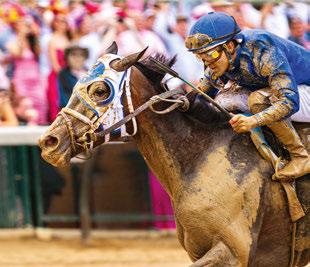
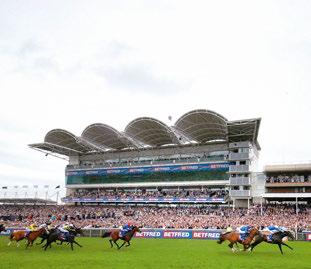
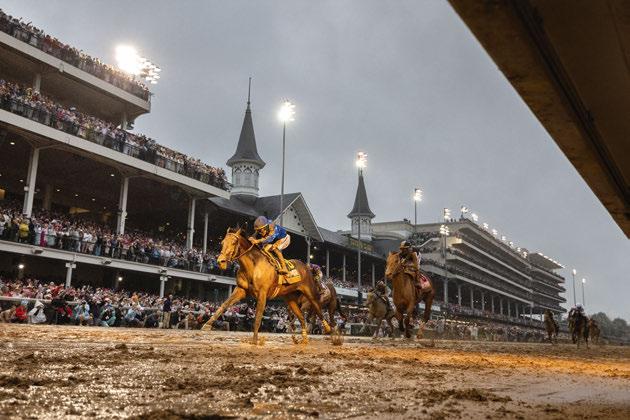
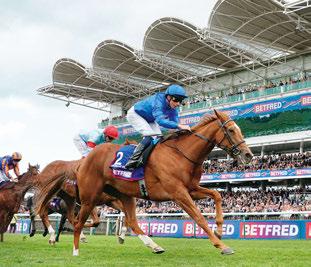

The 2,000 Guineas and the Kentucky Derby. The Kentucky Oaks and the 1,000 Guineas. Tests that make stallions – and prove stallions. That make history. Three homebreds, one sales purchase. Two future Darley stallions, two by Darley stallions. The American double: last achieved in 1952. The Guineas: only three owners have won both since the war. But all four? Never before garnered by a single team as they were in 2025 –on one unforgettable long weekend. And almost five decades after Sheikh Mohammed’s awe-inspiring, all-inspiring first-ever winner.